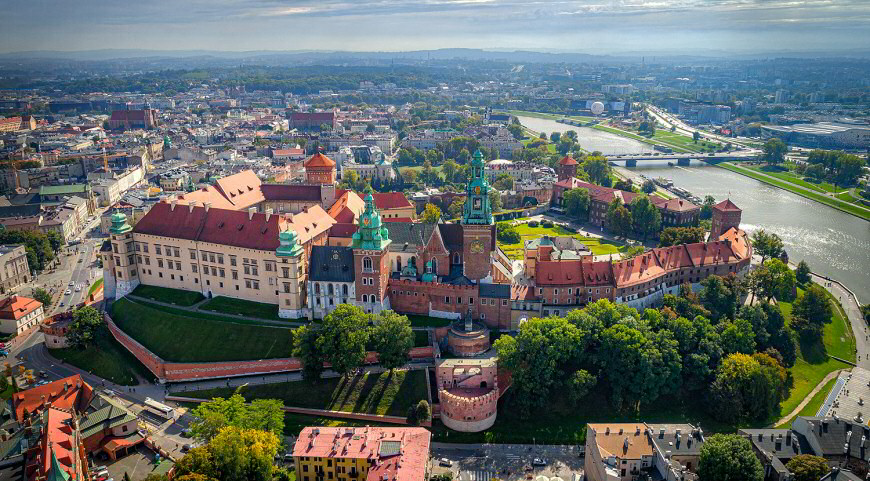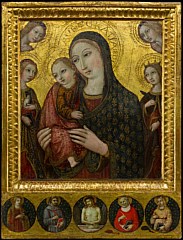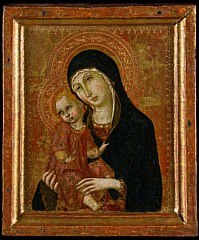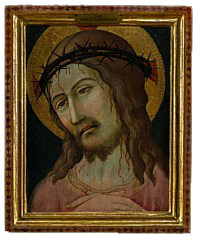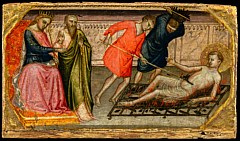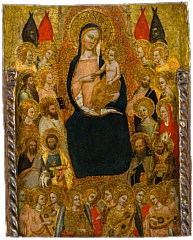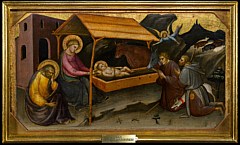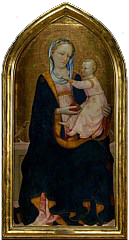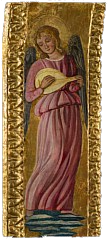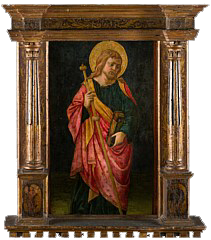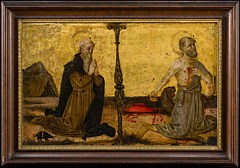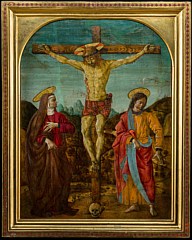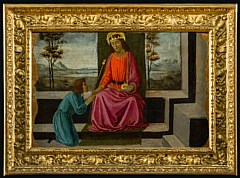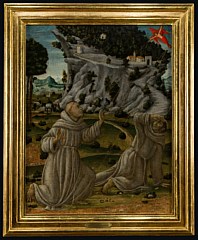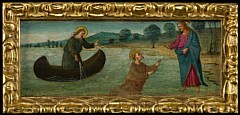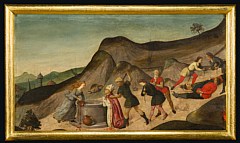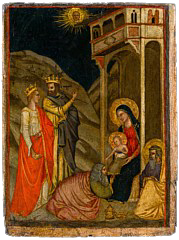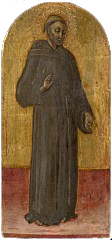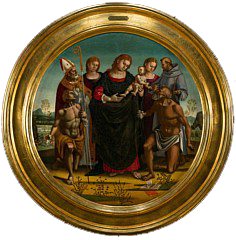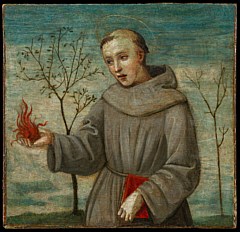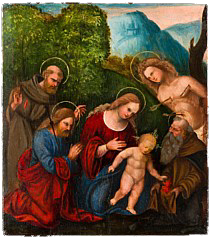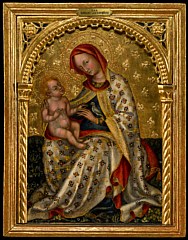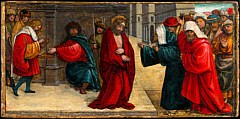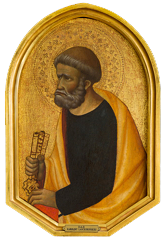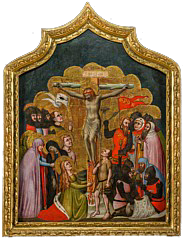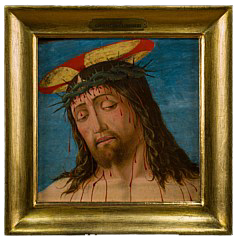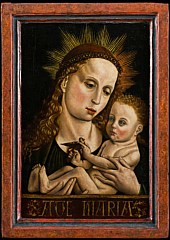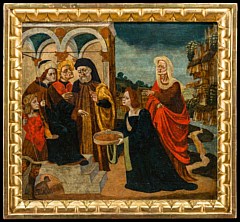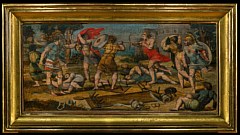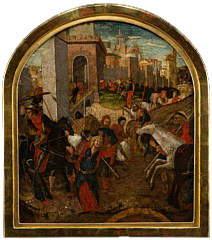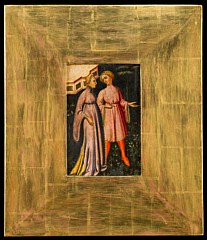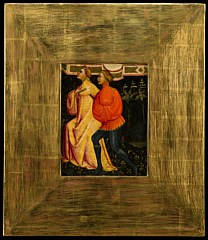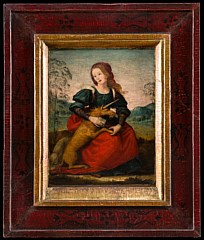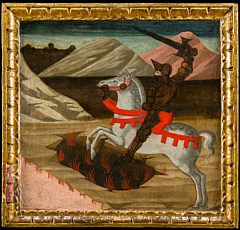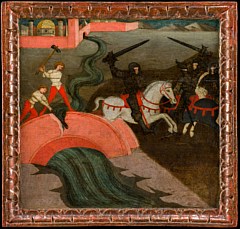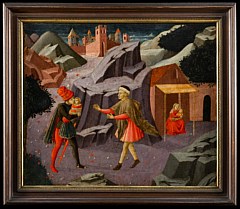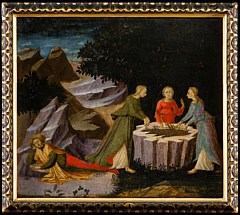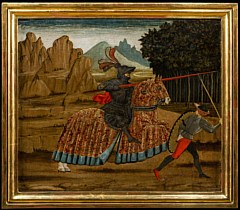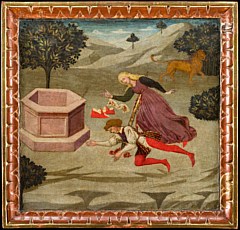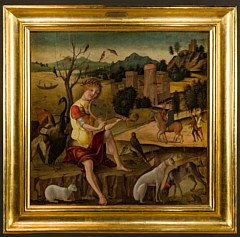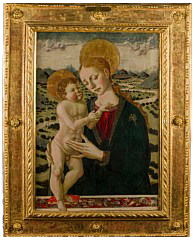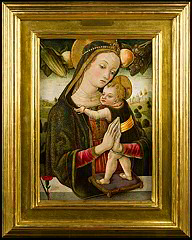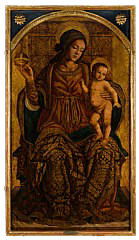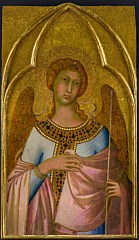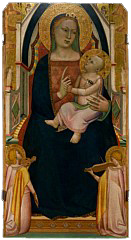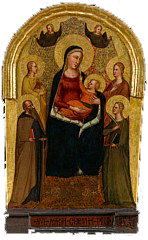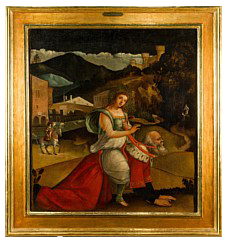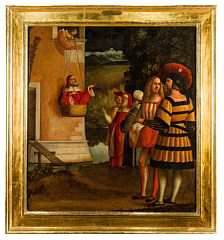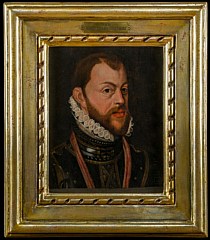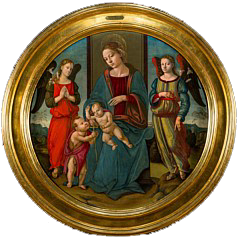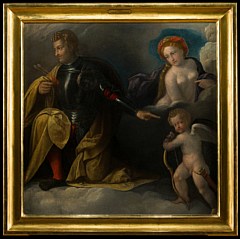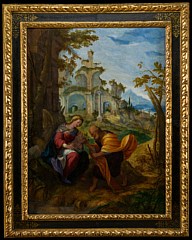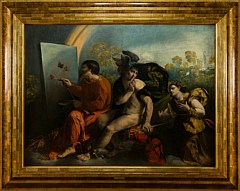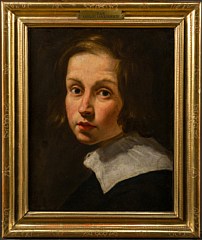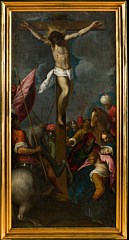7898
Segna di Bonaventura (?)
Segna di Bonaventura (?)
Madonna z Dzieciątkiem
Virgin and Child
czynny od ok. 1280 r. - zm. 1326/1331 r.
active ca. 1280–d. 1326/1331
I PIĘTRO – GABINET WŁOSKI W WIEŻY JORDANCE
1st Floor – Italian Cabinet in the Jordanka Tower
r
tempera, srebrzenia, drewno topolowe, 74 x 47 cm;
Tempera and silver on poplar panel, 74 x 47 cm;
Jeden z najstarszych obrazów w kolekcji Lanckorońskich. Datowany na 1. ćwierć XIV w. został hipotetycznie przypisany Segni di Bonaventura – sieneńskiemu malarzowi z kręgu Duccia di Buoninsegna, autora słynnej Maesty, namalowanej dla katedry w Sienie. Cechą wyróżniającą tę kompozycję jest pewien archaizm w przedstawianiu postaci ascetycznej, nieco sztywnej Madonny. Stosunkowo duże Dzieciątko w antykizujących szatach przytula się do Marii obejmując ją lewą ręką, podczas gdy prawa, uniesiona w geście błogosławieństwa, jest słabo widoczna. Bardzo rzadkie w malarstwie sieneńskim srebrne tło zostało zrekonstruowane podczas konserwacji przeprowadzonej w latach 90. XX w. na podstawie odnalezionych śladów srebrzenia.
This is one of the oldest pictures in the Lanckoroński Collection. Dated to the first quarter of the 14th century, it has been hypothetically attributed to Segna di Bonaventura, a Sienese painter from the circle of Duccio di Buoninsegna, best known for his celebrated Maestà altarpiece in the cathedral in Siena. The Wawel picture is marked by a pronounced archaism in the ascetic, somewhat stiff figure of the Virgin. The relatively large Christ Child is dressed in antique robes and hugs the Virgin with his left arm, while his right arm, raised in a gesture of blessing, is partly obscured by his body. The silver ground, which is rare in Sienese painting, was reconstructed based on traces of silver uncovered during the restoration campaign carried out in the 1990s.
7901
Mistrz z Città di Castello
Master of the Città di Castello
Św. Franciszek z Asyżu
Saint Francis of Assisi
czynny w latach 1305-1330
active 1305–1330
I PIĘTRO – GABINET WŁOSKI W WIEŻY JORDANCE
1st Floor – Italian Cabinet in the Jordanka Tower
r
tempera, złocenia, drewno topolowe, 68 x 37,3 cm; z oryginalną ramą z drewna sosnowego: 72,5 x 42,7 cm;
Tempera and gold of poplar panel, 68 x 37.3 cm; with original engaged pine frame: 772.5 x 42.7 cm;
Surowe, ascetyczne oblicze i sztywna, hieratyczna poza są typowe dla wczesnych wizerunków, inspirowanych żywotem świętego pióra jego współbrata z zakonu franciszkańskiego, Thomasa Celano, z 1229 r. Obraz jest dziełem anonimowego malarza sieneńskiego, któremu przypisano Madonnę z Dzieciątkiem w Pinacoteca Communale w Città di Castello oraz grupę pokrewnych jej stylistycznie obrazów, w tym przedstawienia Św. Jana Chrzciciela i Św. Piotra w Yale University Art Gallery w New Haven, uznawanych hipotetycznie za elementy tego samego poliptyku, z którego pochodzi obraz z kolekcji Lanckorońskich. Jego część środkową stanowiło zapewne jedno z przypisywanych Mistrzowi z Città di Castello przedstawień Madonny z Dzieciątkiem.
The severe, ascetic face and the stiff, hieratic pose are typical of early depictions of Saint Francis, which were inspired by the Life of the saint composed by monastic confrere Thomas of Celano in 1229. The picture was painted by an anonymous Sienese artist, known as the Master of the Città di Castello after the Virgin and Child attributed to him in the Pinacoteca Communale in the Città di Castello. A group of stylistically similar works which includes the Saint John the Baptist and the Saint Peter in the Yale University Art Gallery, New Haven, are believed to be part of the same polyptych as the Lanckoroński picture. One of the Virgin and Child pictures attributed to this master was very likely the central panel of the altarpiece.
7900
Bartolo di Fredi Cini
Bartolo di Fredi Cini
Św. Augustyn
Saint Augustine
ur. ok. 1330 r., czynny od 1353 r. - zm. 1410 r.
born ca. 1330, active from 1353–died 1410
I PIĘTRO – GABINET WŁOSKI W WIEŻY JORDANCE
1st Floor – Italian Cabinet in the Jordanka Tower
r
tempera, złocenia, drewno topolowe, 36,1 x 17,3 cm; z ramą: 39,8 x 20 cm;
Tempera and gold on poplar panel, 36.1 x 17.3 cm; with engaged frame: 39.8 x 20 cm;
Św. Augustyn, jeden z czterech najważniejszych doktorów Kościoła, przedstawiony w stroju biskupim: haftowanej kapie, nałożonej na mnisi habit, w infule, z otwartą księgą i kałamarzem, w którym macza pióro. Obraz, uznany za dzieło Bartola di Fredi Cini, jednego z malarzy sieneńskich, i datowany na lata 80. XIV w., jest pokrewny kompozycyjnie i stylistycznie wyobrażeniu innego świętego, identyfikowanego ze św. Grzegorzem, w Museum of Fine Arts w Bostonie. Widoczny na obu obrazach fragment tak samo uformowanego pięciolistnego maswerku dowodzi, że oba obrazy należały do tego samego retabulum. Mógł to być, jak sądzą badacze, ołtarz w kościele San Francesco w Montalcino lub San Francesco w San Gimignano, a za jego część środkową skłonni są uznać Pokłon Trzech Króli w Pinacoteca Nazionale w Sienie lub Ofiarowanie Dzieciątka Jezus, obecnie Paryż, Luwr.
Saint Augustine, one of the four most important Doctors of the Church, is presented wearing an embroidered Bishop’s cope over a monk’s habit and a mitre, with an open book and an inkwell into which he dips his quill. The picture, recognized as the work of the Sienese painter Bartolo di Fredi Cini and dated to the 1380s, is compositionally and stylistically related to the depiction of another saint, identified as Saint Gregory, in the Museum of Fine Arts, Boston. Fragments of identical engaged cinquefoil moldings prove that the pictures were once part of the same altarpiece. Art historians believe that the altarpiece may have come either from the church of San Francesco in Montalcino or the church of San Francesco in San Gimignano. Its central panel is believed to be either the Adoration of the Magi in the Pinacoteca Nazionale in Siena or the Presentation at the Temple now in the Louvre in Paris.
7902
Taddeo di Bartolo
Taddeo di Bartolo
Św. Franciszek
Saint Francis of Assisi
ur. ok. 1362 r., wzmiankowany od 1383 r. - zm. 1422 r.
born ca. 1362, mentioned from 1383–died 1422
I PIĘTRO – GABINET WŁOSKI W WIEŻY JORDANCE
1st Floor – Italian Cabinet in the Jordanka Tower
r
tempera, złocenia, drewno topolowe,31,8 x 36 cm
Tempera and gold on poplar panel, 31.8 x 36 cm;
Obraz, datowany hipotetycznie na lata 1395-1400, był zapewne częścią ołtarza w kościele San Francesco w Pizie, do którego należały również Madonna z Dzieciątkiem koronowana przez anioły umieszczona w części środkowej oraz Św. Jan i Św. Andrzej po bokach (obecnie w Szépmüvészeti Museum w Budapeszcie). Obraz został w niewiadomym czasie obcięty – całopostaciowy wizerunek świętego zredukowano do popiersia. Archaiczne cechy stylu Taddeo di Bartolo każą związać dzieło z wczesnym okresem jego twórczości, gdy nawiązywał jeszcze do sztuki sieneńskiej 1. poł. XIV w.; dopiero w późniejszych dziełach pojawia się modelunek światłocieniowy i elementy iluzjonizmu, a postacie nabierają woluminu, co jest widoczne w jego głównym dziele – poliptyku wykonanym w 1403 r. dla kościoła San Francesco al Prato w Perugii (części ołtarza są rozproszone, trzynaście tablic znajduje się w Galleria Nazionale dell’Umbria w Perugii).
The painting, hypothetically dated to between 1395 and 1400, was once part of an altarpiece in the church of San Francesco in Pisa. This altarpiece also included the Madonna of Humility flanked by Saint John and Saint Andrew in its central section (now in the Museum of Fine Arts in Budapest). At some unknown date the picture was cut down and the full figure image of the saint was reduced to a bust. The archaic traits of Taddeo di Bartolo’s style indicate that this is an early work, made when the painter was still influenced by Sienese painting of the first half of the fourteenth century. Later, his figures take on volume and chiaroscuro modeling and elements of illusionistic painting appear in his major work, the polyptych that he painted in 1403 for the church of San Francesco al Prato in Perugia (sections of the altarpiece have been scattered, thirteen panels are held in the Galleria Nazionale dell’Umbria in Perugia).
7903
g
Sano di Pietro i warsztat
Sano di Pietro and workshop
Madonna z Dzieciątkiem i świętymi
Virgin and Child with Saints
1405-1481
1405–1481
I PIĘTRO – GABINET WŁOSKI W WIEŻY JORDANCE
1st Floor – Italian Cabinet in the Jordanka Tower
r
tempera, złocenia, drewno topolowe,26,5 x 23,7 cm; z ramą: 38,5 x 29,4 cm;
Tempera and gold on poplar panel, 26.5 x 23.7 cm; with engaged frame: 38.5 x 29.4 cm;
Sano di Pietro był – w opinii badaczy – pierwszym malarzem sieneńskim malującym na tak wielką skalę nieduże obrazki dewocyjne, przeznaczone do prywatnych domów, jakkolwiek powielające, w mniejszej skali, schematy ikonograficzne większych retabulów ołtarzowych. Kompozycja obrazu nawiązuje do idei tryptyku z wyobrażeniem Madonny z Dzieciątkiem w partii centralnej oraz aniołów i świętych u dołu i po bokach – wielopostaciowe przedstawienie artysta zaadaptował do małej powierzchni. Umieszczone u dołu w medalionach: wizerunek Chrystusa umęczonego w typie Imago Pietatis pośrodku oraz podobizny czworga świętych: Marii Magdaleny, Franciszka, Hieronima i nierozpoznanej świętej, tworzą rodzaj predelli. Po bokach Madonny wyobraził malarz dwie święte, otaczane w Sienie szczególną czcią: św. Agnieszkę i św. Katarzynę Aleksandryjską; u góry widnieją głowy dwóch aniołów. W postaci Marii badacze dopatrują się pokrewieństwa stylistycznego z analogicznym wizerunkiem pędzla Sana di Pietro w Pinacoteca Nazionale w Sienie, datowanym na lata 70. XV w.. Na ten sam okres przypada zapewne powstanie realistycznie malowanych, nieco uproszczonych figur w predelli, jakkolwiek taka jej forma, nawiązująca do dzieł z XIV w., w 2. poł. następnego stulecia wydaje się nieco archaiczna; w twórczości Sana di Pietro medaliony z podobiznami świętych pojawiają się w obrazach datowanych na lata 40. i 50.; potem artysta rezygnuje z pojedynczych wizerunków na rzecz scen o charakterze narracyjnym.
Art historians believe that Sano di Pietro was the first Sienese painter to create small pictures intended for private devotion on such a large scale. Although small in size, the pictures retained the iconographic compositions of much larger altarpiece paintings. The composition of this picture recalls the form of a triptych, with the image of the Virgin and Child in the central section with angels and saints on the sides and at the bottom. The artist adapted the multi-figure composition to a small surface. The medallions along the bottom form a predella of sorts. The central medallion holds an image of the martyred Christ of the Imago Pietatis type, flanked by medallions holding images of four saints: Mary Magdalene, Francis, Jerome, and an unidentified female saint. The artist has pictured two saints especially revered in Siena: Saint Agnes and Saint Catherine of Alexandria; heads of angels are placed above the saints. Scholars have noted a stylistic relationship between the figure of the Virgin in this picture and a similar work by Sano di Pietro dated to the 1470s in the Pinacoteca Nazionale in Siena. The realistically rendered, if somewhat simplified, figures of the predella were painted at about the same time, although its form, which harks back to the fourteenth century, appears a bit archaic in the second half of the next century. Medallions with images of saints appear in Sano’s works dated to the 1440s and 1450s. In his later works, the artist favored narrative scenes instead.
7904
Sano di Pietro
Sano di Pietro
Madonna z Dzieciątkiem
Virgin and Child
1405-1481
1405–1481
I PIĘTRO – GABINET WŁOSKI W WIEŻY JORDANCE
1st Floor – Italian Cabinet in the Jordanka Tower
r
tempera, złocenia, drewno topolowe; 19 x 15,2 cm; z oryginalną malowaną ramą: 23,2 x18,3 cm;
Tempera and gold on poplar panel; 19 x 15.2; with original painted frame: 23.2 x 18.3 cm;
Jeden z licznych w dorobku artysty niewielkich obrazów, ukazujących Madonnę z Dzieciątkiem, służących prywatnej dewocji. Często były dziełem warsztatu – Sano di Pietro, jeden z popularniejszych artystów swego czasu, aczkolwiek dość konserwatywny malarz sieneński XV w., był wysoko ceniony przez współczesnych. Prowadził rozbudowany warsztat, w którym powstawały obrazy dewocyjne o nierównym poziomie wykonania, zaspokajając rosnące zapotrzebowanie na dewocyjne wyobrażenia Marii z małym Jezusem, często przedstawianej w otoczeniu świętych. Wawelska Madonna jest zapewne jednym z nielicznych, wczesnych dzieł Sana, datowanych na przełom lat 40. i 50. XV w.– wyróżnia ją stosunkowo wysoki poziom wykonania, widać w nim rękę samego mistrza, udział współpracowników był wyraźnie mniejszy.
This is one of the artist’s many small depictions of the Virgin and Child intended for private devotion. These were often workshop pieces. Although conservative, Sano di Pietro was one of the more popular fifteenth-century Sienese artists and was highly esteemed by his contemporaries. He ran a large workshop which produced devotional pictures of an uneven artistic level, to meet the growing demand for devotional images of Mary and the Baby Jesus, often surrounded by saints. The Wawel Virgin and Child is one of Sano’s few early works dating from the late 1440s or early 1450s. This rather fine picture exhibits the hand of the master himself with an evidently lesser degree of participation by workshop artists.
7905
Sano di Pietro
Sano di Pietro
Popiersie Chrystusa w koronie cierniowej
Bust of Christ in the Crown of Thorns
1405-1481
1405–1481
I PIĘTRO – GABINET WŁOSKI W WIEŻY JORDANCE
1st Floor – Italian Cabinet in the Jordanka Tower
r
tempera, złocenia, drewno topolowe, 35,1 x 27 cm; z ramą: 42 x 34,9 cm;
Tempera and gold on poplar panel, 35.1 x 27 cm; with frame: 42 x 34.9 cm;
Niewielkie rozmiary obrazu każą zaliczyć go do typu przedstawień służących prywatnej dewocji. Datowany na połowę lat 60. XV w., a więc na okres, kiedy Sano di Pietro, dotąd pracujący w ramach tzw. compagne, grupujących wybitniejszych artystów, tworzył własny warsztat, w którym pracowali także malarze pośledniejszej klasy: uczniowie i pomocnicy, realizując rosnące zapotrzebowanie na niewielkie kompozycje o charakterze dewocyjnym. Obraz charakteryzuje się już pewnym schematyzmem rysunku mimo sporej ekspresji i pewnych elementów modelunku światłocieniowego. Kompozycja reprezentuje typ ikonograficzny Ecce Homo – wizerunek Chrystusa umęczonego, w cierniowej koronie i czerwonej tunice; w innej od powszechnie przyjętej na podstawie przekazów ewangelicznych formule: zredukowany do popiersia, jednakże z widocznymi częściowo dłońmi.
The small dimensions of this painting indicate that it was intended for private devotion. It is dated to the mid 1460s, when Sano di Pietro was forming his own workshop. Until then he had worked within the system of the compagne, or artists associations that grouped the leading artists with more average painters, such as students and helpers; it was the lesser painters who made small devotional works for the growing market. The line of the drawing is fairly schematic, but it is highly expressive and contains some elements of chiaroscuro modelling. The composition is of the Ecce Homo iconographic type – an image of the martyred Christ wearing the crown of thorns and a red tunic. It diverges, however, from the accepted formula based on the Gospels in that it is reduced to a bust, but with the hands partially visible.
7906
Pellegrino di Mariano di Jacopo Rossini
Pellegrino di Mariano di Jacopo Rossini
Św. Katarzyna Sieneńska
Saint Catherine of Siena
notowany od 1449 r. - zm. 1491 r.
recorded from 1449–died 1491
I PIĘTRO – GABINET WŁOSKI W WIEŻY JORDANCE
1st Floor – Italian Cabinet in the Jordanka Tower
r
tempera, złocenia,drewno topolowe, 14 x13,5 cm;
Tempera and gold on poplar panel, 14 x 13.5 cm;
Dwa niewielkich rozmiarów obrazy ukazujące dwoje świętych w czworolistnym obramieniu, wykonanym z zatopionego w zaprawie sznurka, wchodziły pierwotnie w skład predelli złożonej z kilku podobnych wyobrażeń świętych, tworzących rodzaj fryzu – usytuowane były zapewne po dwóch stronach jakiegoś centralnego przedstawienia, być może Chrystusa. Zarówno w kolekcji Lanckorońskich, jak też w późniejszej literaturze przedmiotu uchodziły za dzieła sieneńskiego malarza Sana di Pietro, którego dzieła przypomina zwłaszcza wyobrażenie św. Bernardyna. Z Pellegrinem di Mariano di Jacopo Rossinim, sieneńskim artystą, znanym głównie jako malarz miniatur w kodeksach wykonanych dla katedr w Pienzy i w Sienie, zostały związane na podstawie pokrewieństwa stylistycznego z predellą w Pinacoteca Nazionale w Sienie, złożoną z dziewięciu podobnych przedstawień świętych w czworolistnych medalionach. Atrybucję tę potwierdza porównanie do jednego z dwóch sygnowanych obrazów artysty: Madonny z Dzieciątkiem, św. Janem Chrzcicielem i św. Bernardynem w Memphis Brooks Museum of Art w Memphis (USA).
These two small pictures which depict two saints in quatrefoil moldings made of a piece of cord dipped in gesso were originally part of a predella made up of several similar images of saints creating a frieze of sorts located on either side of a central panel, perhaps depicting Christ. In the Lanckoroński collection and in the later literature, they had been attributed to Sano di Pietro, whose work the Saint Bernardino in particular recalls. They were linked to Pellegrino di Mariano di Jacopo Rossini, a Sienese artist primarily known for his miniatures in codices made for the cathedrals in Pienza and Siena. The connection was made based on their stylistic relationship to his predella in the Pinacoteca Nazionale in Siena, which comprises nine similar images of saints in quatrefoil medallions. This attribution is further supported by comparison to one of two signed works by the artist, the Madonna and Child with Saints John the Baptist and Bernardino of Siena in the Memphis Brooks Museum of Art in Tennessee, USA.
7907
Pellegrino di Mariano di Jacopo Rossini
Pellegrino di Mariano di Jacopo Rossini
Św. Bernardyn ze Sieny
Saint Bernardino of Siena
notowany od 1449 r. - zm. 1491 r.
recorded from 1449–died 1491
I PIĘTRO – GABINET WŁOSKI W WIEŻY JORDANCE
1st Floor – Italian Cabinet in the Jordanka Tower
r
tempera, złocenia, drewno topolowe, 14,1 x 14,3 cm;
Tempera and gold on poplar panel, 14.1 x 14.3 cm;
Dwa niewielkich rozmiarów obrazy ukazujące dwoje świętych w czworolistnym obramieniu, wykonanym z zatopionego w zaprawie sznurka, wchodziły pierwotnie w skład predelli złożonej z kilku podobnych wyobrażeń świętych, tworzących rodzaj fryzu – usytuowane były zapewne po dwóch stronach jakiegoś centralnego przedstawienia, być może Chrystusa. Zarówno w kolekcji Lanckorońskich, jak też w późniejszej literaturze przedmiotu uchodziły za dzieła sieneńskiego malarza Sana di Pietro, którego dzieła przypomina zwłaszcza wyobrażenie św. Bernardyna. Z Pellegrinem di Mariano di Jacopo Rossinim, sieneńskim artystą, znanym głównie jako malarz miniatur w kodeksach wykonanych dla katedr w Pienzy i w Sienie, zostały związane na podstawie pokrewieństwa stylistycznego z predellą w Pinacoteca Nazionale w Sienie, złożoną z dziewięciu podobnych przedstawień świętych w czworolistnych medalionach. Atrybucję tę potwierdza porównanie do jednego z dwóch sygnowanych obrazów artysty: Madonny z Dzieciątkiem, św. Janem Chrzcicielem i św. Bernardynem w Memphis Brooks Museum of Art w Memphis (USA).
These two small pictures which depict two saints in quatrefoil moldings made of a piece of cord dipped in gesso were originally part of a predella made up of several similar images of saints creating a frieze of sorts located on either side of a central panel, perhaps depicting Christ. In the Lanckoroński collection and in the later literature, they had been attributed to Sano di Pietro, whose work the Saint Bernardino in particular recalls. They were linked to Pellegrino di Mariano di Jacopo Rossini, a Sienese artist primarily known for his miniatures in codices made for the cathedrals in Pienza and Siena. The connection was made based on their stylistic relationship to his predella in the Pinacoteca Nazionale in Siena, which comprises nine similar images of saints in quatrefoil medallions. This attribution is further supported by comparison to one of two signed works by the artist, the Madonna and Child with Saints John the Baptist and Bernardino of Siena in the Memphis Brooks Museum of Art in Tennessee, USA.
7909
Bicci di Lorenzo
Bicci di Lorenzo
Męczeństwo św. Wawrzyńca
The Martyrdom of Saint Lawrence
1373-1452
1373–1452
I PIĘTRO – GABINET WŁOSKI W WIEŻY JORDANCE
1st Floor – Italian Cabinet in the Jordanka Tower
r
tempera, złocenia, drewno topolowe, 19 x 32,3 cm;
Tempera and gold on poplar panel, 19 x 32.3 cm;
Obraz pochodzi z predelli, do której należało też Męczeństwo św. Bartłomieja, obecnie w Isabella Stewart Gardner Museum w Bostonie. Oprócz pokrewieństwa stylistycznego i niemal identycznych wymiarów, oba obrazy łączy także forma obramienia o ściętych narożnikach, z wykonaną w zaprawie dekoracją ornamentalną. Za autora obrazu bostońskiego uznawano florenckiego malarza Stefano di Antonio, potem związano go z twórczością Bicciego di Lorenzo, któremu przypisano także malowidło wawelskie, datowane początkowo na wczesny wiek XIV i łączone z kręgiem Agnola Gaddiego. Elementy stylu Bicciego di Lorenzo to m.in. detale ubiorów oraz ekspresja twarzy i gestów głównych postaci: siedzącego na tronie cesarza Decjusza i stojącego obok niego urzędnika, a także prosty mur ozdobiony fryzem arkadkowym. Ikonografia sceny nawiązuje natomiast do Historii św. Wawrzyńca z warsztatu Bernarda Daddiego w kaplicy Pulci-Berardi w kościele Santa Croce we Florencji.
This picture was once part of a predella, which also included the Martyrdom of Saint Bartholomew, now in the Isabella Stewart Gardner Museum in Boston. In addition to the stylistic similarities and nearly identical dimensions, the two works are also linked by a common frame style with beveled corners, with ornamentation carved and punched into the gesso ground and gilt. The Boston picture is attributed to the Florentine painter Stefano di Antonio, but was later linked to Bicci di Lorenzo, to whom the Wawel picture is attributed. The Wawel work was initially dated to the early fourteenth century and linked with the circle of Agnolo Gaddi. Elements of Bicci di Lorenzo’s style include details of the garments, facial expressions, and gestures of the main figures: the seated Emperor Decius and the official standing next to him, as well as the simple wall decorated with an arcaded frieze. The iconography of the scene relates to the Story of Saint Lawrence by the workshop of Bernardo Daddi in the Pulci-Bernardi chapel in the church of Santa Croce in Florence.
7910
Niccolò di Tommaso
Niccolò di Tommaso
Madonna z Dzieciątkiem wśród aniołów i świętych
Madonna and Child Surrounded by Angels and Saints
wzmiankowany od 1343 r. – 1376 r.
recorded from 1343–1376
I PIĘTRO – GABINET WŁOSKI W WIEŻY JORDANCE
1st Floor – Italian Cabinet in the Jordanka Tower
r
tempera, złocenia, drewno topolowe, 36,6 x 28,8 cm;
Tempera and gold on poplar panel; 36.6 x 28.8 cm;
Obraz został w niewiadomym czasie pomniejszony: pozbawiono go ostrołukowego zwieńczenia, a muzykujące anioły w partii dolnej, pierwotnie zapewne w całej postaci, zostały obcięte. Kręcone kolumienki, ujmujące obraz z obu stron, są zachowane również fragmentarycznie. Kompozycja nawiązuje do typu ikonograficznego Maestà: tronującej Marii z Dzieciątkiem, którą na obrazie wawelskim otaczają od góry rzędy Serafinów i Cherubinów, a z obu stron święci, wśród których można zidentyfikować św. Jana Chrzciciela i św. Jana Ewangelistę, Bartłomieja, Piotra, Antoniego Opata i św. Łucję. Atrybucja nie budzi wątpliwości – obraz łączono z Niccolò di Tommaso, działającym we Florencji i Pistoi twórcą niewielkich obrazów, powtarzających ten sam schemat: tronującą Madonnę z Dzieciątkiem, w niebieskim płaszczu podbitym gronostajem, w otoczeniu aniołów i świętych. Niezmienny pozostaje też ich styl, co utrudnia datowanie.
At some unknown time, this picture was cut down: its pointed arch gable was removed and the music-making angels in the lower section, originally full-length figures, were partly cut off. The Solomonic columns, which frame the picture on either side, are also fragmentarily preserved. The composition recalls the Maestà iconographic type: the Madonna and Child enthroned. In the Wawel picture, the Virgin and Child are surrounded by, from the top, rows of Seraphim and Cherubim, with saints on either side among whom we can identify Saint John the Baptist, Saint John the Evangelist, Saint Bartholomew, Saint Peter, Saint Anthony Abbot, and Saint Lucy. The attribution to Niccolò di Tomasso is firm. Active in Florence and Pistoia, the artist repeated the same theme in modest-sized pictures: the enthroned Madonna holding the Child in her arms, wears a blue, ermine-lined cloak, and is surrounded by angels and saints. The pictures’ style doesn’t change, which makes it difficult to date them.
7914
g
Mariotto di Nardo
Mariotto di Nardo
Pokłon pasterzy
The Adoration of the Shepherds
wzmiankowany od 1393 r. - zm. 1424 r. lub 1428 r.
recorded from 1393–died 1424 or 1428
I PIĘTRO – GABINET WŁOSKI W WIEŻY JORDANCE
1st Floor – Italian Cabinet in the Jordanka Tower
r
tempera, złocenia, drewno topolowe, 30,4 x 52,2 cm;
Tempera and gold on poplar panel, 30.4 x 52.2 cm;
Obraz, uważany początkowo za desco da parto (m.in. z racji wtórnie zmienionego kształtu), jest w istocie częścią predelli, w której skład wchodził także Pokłon Trzech Króli, obecnie w Allen Memorial Art Museum w Oberlin (USA). Oba obrazy łączą nie tylko wymiary, kształt i obramienie desek, ale także kompozycja: postacie zgrupowane po obu stronach niemal identycznej stajenki nakrytej dwuspadowym słomianym daszkiem. Również cechy stylistyczne: fałdy szat, fizjonomie postaci, elementy górzystego pejzażu w tle oraz roślinność na pierwszym planie, każą widzieć w obu obrazach rękę tego samego artysty. Obraz wawelski uchodził za dzieło Taddea Gaddiego, ucznia Giotta di Bondone, co zdawała się potwierdzać giottowska postać Marii; potem był przypisywany Lorenzo di Niccolò, Agnolo Gaddiemu, a ostatecznie uznano go za dzieło florenckiego malarza Mariotta di Nardo, którego styl uformował się pod wpływem Niccolò di Pietro Geriniego i Spinella Aretino, czerpiących obficie z wzorów Giotta. Z kolei wpływ Mariotta di Nardo można zaobserwować w malarskich dziełach znanego głównie z dzieł rzeźbiarskich Lorenza Ghibertiego, który u Mariotta uczył się malarstwa - płaskorzeźba przedstawiająca Anioła w scenie Zwiastowania na północnych drzwiach z brązu w baptysterium we Florencji, wykonanych w latach 1401-1424, przypomina figury na obrazie w Oberlin; niewykluczone, że Ghiberti miał swój udział w powstaniu predelli. Za czas jej powstania uznano pierwsze dwudziestolecie XV w., możliwe, że została namalowana wkrótce po 1400 r. – taką datę należy przyjąć dla obrazu wawelskiego.
This picture was originally thought to be a desco da parto, or commemorative birth tray, partly because of its altered shape. It is in fact a fragment of a predella which included the Adoration of the Magi now in the Allen Memorial Art Museum in Oberlin, Ohio. The affinities between the two pictures are not limited to their dimensions, shapes, and frames; they extend to the compositions. In each case the figures are grouped on either side of a nearly identical straw-roofed manger. Stylistic similarities, which include the way in which the folds of the robes are rendered, the facial features of the figures, the mountainous landscape in the background, and the vegetation in the foreground indicate that they were painted by the same artist. The Wawel picture had been ascribed to Taddeo Gaddi, a pupil of Giotto di Bondone, which appeared to be supported by the Giottesque figure of Mary. Later it was attributed to Lorenzo di Niccolò, Agnolo Gaddi, and finally recognized as the work of the Florentine painter Mariotto di Nardo, whose style was formed under the influence of Niccolò di Pietro Gernini and Spinello Aretino, both of whom borrowed amply from Giotto. On the other hand, the influence of Mariotto di Nardo can be found in the paintings of Lorenzo Ghiberti, who is primarily known as a sculptor, but studied painting under Mariotto. His bas-relief image of the angel in the Annunciation on his bronze doors of the baptistery in Florence from 1401 to 1424, recalls the figure of the angel in the Oberlin picture. It is possible that Ghiberti contributed to the predella. Believed to date from the first two decades of the fifteenth century, the predella could have been painted shortly after 1400 – the date accepted for the Wawel picture.
7915
Rossello di Jacopo Franchi
Rossello di Jacopo Franchi
Madonna z Dzieciątkiem
Madonna and Child
ok. 1376-1456
ca. 1376–1456
I PIĘTRO – GABINET WŁOSKI W WIEŻY JORDANCE
1st Floor – Italian Cabinet in the Jordanka Tower
r
tempera, złocenia, drewno topolowe, 94,2 x 47,7 cm;
Tempera and gold on poplar panel, 94.2 x 47.7 cm;
Obraz został zakupiony przez Adolpha Bayersdorfera dla Karola Lanckorońskiego na aukcji kolekcji Leclanché w Paryżu w 1892 r. W pałacu Lanckorońskich w Wiedniu złączony był z dwoma bocznymi skrzydłami, przedstawiającymi świętych, namalowanymi jednakże przez innego artystę. Pierwotnie stanowił zapewne środkową część nieznanego dziś tryptyku, którego lewym skrzydłem mogło być wyobrażenie świętych: Kosmy i Damiana w Compagna di Belle Arti w Mediolanie. Według innej hipotezy Madonnie z kolekcji Lanckorońskich towarzyszyły dwa inne obrazy: Św. Jerzy i św. Jan Chrzciciel (dawniej w kolekcji Mario Krohna w Kopenhadze) oraz Św. Franciszek i św. Jan Ewangelista (dawniej w zbiorach Oswalda Siréna w Sztokholmie). Za czas powstania Madonny przyjęto lata ok.1420 r. na podstawie stylistycznego pokrewieństwa z Koronacją Marii w zbiorach Galleria dell’Accademia we Florencji.
This picture was purchased by Adolph Bayersdorfer for Karol Lanckoroński at the sale of the Leclanché collection in Paris in 1892. When it hung in Lanckoroński’s palace in Vienna, it had been connected to two altarpiece wings with representations of saints painted by a different artist. Originally, the picture was the central panel of an unidentified triptych, whose left wing may have been the image of Saints Cosmas and Damian in the Compagna di Belle Arti in Milan. According to a different hypothesis, the Madonna in the Lanckoroński collection was once accompanied by two different pictures: Saint George and Saint John the Baptist (formerly in the Mario Krohn collection in Copenhagen) and Saint Francis and Saint John the Evangelist (formerly in the Oswald Sirén collection in Stockholm). The Madonna has been dated to about 1420 on the basis of its stylistic affinity with the Coronation of Mary in the Galleria dell’Accademia in Florence.
7920
Bartolomeo Caporali (Bartolomeo di Giovanni, zwany Il Caporale) (?)
Bartolomeo Caporali (Bartolomeo di Giovanni, called Il Caporale) (?)
Muzykujący anioł
Music-making Angel
ur. ok. 1420 r., czynny od 1442 r. - zm. przed 1505 r.
born ca. 1420, active from 1442–died before 1505
I PIĘTRO – GABINET WŁOSKI W WIEŻY JORDANCE
1st Floor – Italian Cabinet in the Jordanka Tower
r
tempera, złocenia, drewno topolowe i lipowe, 47,4 x13-13,3 cm; z oryginalną ramą: 47-47,4 x 20,2-24,3 cm;
Tempera and gold on poplar and limewood panel, 47.4 x 13–13.3 cm; with original engaged frame: 47–47.4 x 20.2–24.3 cm;
Obraz był pierwotnie zapewne częścią obramienia większej kompozycji, wchodzącej w skład retabulum ołtarzowego z lewej strony. Został zakupiony przez Adolpha Bayersdorfera dla Karola Lanckorońskiego na aukcji kolekcji Leclanché w Paryżu w 1892 r. Zaliczany był do dzieł florenckiego malarza Filippa Lippiego – cech jego stylu dopatrywano się m.in. w lirycznym wyrazie twarzy anioła, jej delikatnych rysach oraz lekkości całej trochę wygiętej sylwetki. Pewne niedoskonałości w proporcjach postaci, kształcie głowy, rysunku ramion i dłoni wykluczyły obraz z oeuvre tego malarza, zbliżając Anioła do twórczości Bartolomea Caporali, urodzonego w Perugii i działającego w Umbrii, m.in. w kręgu Benedetta Bonfigli, ale pozostającego pod dużym wpływem malarzy florenckich.
This picture, once part of the frame of a larger composition, was located on the left-hand side of an altarpiece. It was purchased for Karol Lanckoroński by Adolph Bayersdorfer at the sale of the Leclanché collection in Paris in 1892. It was believed to be by the Florentine painter Filippo Lippi – traces of his style were sought in, among others, the angel’s lyrical expression and his delicate facial features, as well as in the overall lightness and slight contraposto stance of the figure. Imperfections in the figure’s proportions, the shape of the head, the line of the arms and hands, however, preclude its inclusion in Filippo Lippi’s oeuvre. Instead, they suggest an affinity with the work of Bartolomeo Caporali, a painter born in Perugia and active in neighboring Umbria in the circle of Benedetto Bonfigli, who was, nevertheless, greatly influenced by the Florentines.
7921
Diamante di Feo zwany Fra Diamante
Diamante di Feo, called Fra Diamante
Św. Jakub Starszy
Saint James the Greater
ur. ok. 1430 r., czynny w 2. poł. XV w. - zm. po 1498 r.
born ca. 1430, active in the 2nd half of the 15th century–died after 1498
I PIĘTRO – GABINET WŁOSKI W WIEŻY JORDANCE
1st Floor – Italian Cabinet in the Jordanka Tower
r
tempera, złocenia, drewno topolowe, 52,2 x32 cm; z ramą z XVI w.: 62,5 x 54,5 cm;
Tempera and gold on poplar panel, 52.2 x 32 cm; with 16th-century frame: 62.5 x 54.5 cm;
Obraz został przycięty ze wszystkich stron; pierwotnie stanowił część retabulum ołtarzowego; w niewiadomym czasie został oprawiony wtórnie w ramę z XVI w. Jego autora poszukiwano w kręgu malarzy związanych z Alesso Baldovinettim, Zanobim Machiavellim i Fra Filippo Lippim, by ostatecznie związać dzieło z florenckim malarzem Diamante di Feo – zakonnikiem w klasztorze karmelitów. Był uczniem i współpracownikiem również karmelity, Fra Filippa Lippiego, z którym w 1452 r. współpracował przy dekorowaniu Capella Maggiore w katedrze w Prato. Za datę powstania obrazu przyjęto czas ok. 1460 r. na podstawie stylistycznego pokrewieństwa z obrazami innego malarza florenckiego, Pesellina. Trudno przytoczyć analogie z innymi dziełami Fra Diamante – jego oeuvre, rekonstruowane głównie w oparciu o wiadomości biograficzne, pozostaje wciąż nierozpoznane.
The picture was cut down on all sides. Originally, it had been part of an altarpiece. At some point it was put in a sixteenth-century frame. Its creator was sought in the circle of artists associated with Alesso Baldovinetti, Zanobi Machiavelli, and Fra Filippo Lippi, but the picture was finally attributed to the Florentine painter and Carmelite monk Diamante di Feo. He had been the pupil and collaborator of another Carmelite, Fra Filippo Lippi, with whom he worked on the decoration of the Capella Maggiore in the Prato cathedral. This picture is dated to about 1460, based on its stylistic affinity with the paintings of another Florentine artist, Pesellino. As Diamante’s oeuvre has been reconstructed mainly on biographical data and is still largely unidentified, it is difficult to find an analogy.
7922
Malarz toskański, identyfikowany z Mistrzem Epifanii z Fiesole (?)
Tuscan painter, possibly the Master of the Fiesole Epiphany (?)
Św. Antoni Opat i św. Hieronim
Saint Anthony Abbot and Saint Jerome
czynny ok. 1460-1480
active ca. 1460–1480
I PIĘTRO – GABINET WŁOSKI W WIEŻY JORDANCE
1st Floor – Italian Cabinet in the Jordanka Tower
r
tempera, złocenia, drewno topolowe, 22,1 x 35,3 cm;
Tempera and gold on poplar panel, 22.1 x 35.5 cm;
Obraz jest lewą częścią predelli, do której należało analogicznie zakomponowane przedstawienie Stygmatyzacji św. Franciszka oraz Pokutującej św. Marii Magdaleny (obecnie Staatsgalerie w Stuttgarcie), przypisywane zmiennie artystom florenckim: Lorenzo di Niccolò Gerini czy Neri di Bicci, bez sprecyzowania atrybucji. Oba obrazy łączy nie tylko kompozycja – klęczące postacie, ukazane w surowym krajobrazie, z pustynną roślinnością i pojedynczą skałą, lecz także rozdzielająca obie postacie tralka o dekoracji w formie przestylizowanych liści. Obraz wawelski był przypisywany Alesso Baldovinettiemu, dopatrywano się w nim cech malarstwa bolońskiego i umbryjskiego. Ostatecznie został związany z anonimowym artystą nazwanym Mistrzem Epifanii z Fiesole na podstawie pokrewieństwa z Adoracją Dzieciątka w Musée du Petit Palais w Awinionie, a za datę powstania przyjęto lata ok.1470 r.
The picture is the left side of a predella that once also included the analogously composed Stigmatization of Saint Francis and Saint Mary Magdalene (now in the Staatsgalerie in Stuttgart), which has been alternately attributed to Florentine artists Lorenzo di Niccolò Gerini and Neri di Bicci. The two pictures are linked not only by similarities of composition, such as the kneeling figures depicted in an arid landscape with desert vegetation and a single rock formation, but also the baluster in the form of stylized leaves separating the two figures which appears in each of the two pictures. The Wawel panel had been attributed to Alesso Baldovinetti, as scholars sought in it traits of Bolognese or Umbrian painting. Ultimately, it was linked to an anonymous Tuscan artist called the Master of the Fiesole Epiphany based on similarities to the Adoration of the Child in the Musée du Petit Palais in Avignon. It is dated to about 1470.
7927
Andrea del Castagno - późny naśladowca
Andrea del Castagno - late follower
Ukrzyżowanie
Crucifixion
1423-1457
1423–1457
I PIĘTRO – GABINET WŁOSKI W WIEŻY JORDANCE
1st Floor – Italian Cabinet in the Jordanka Tower
r
tempera, złocenia, drewno topolowe 66,8 x 47,4 cm;
Tempera and gold on poplar panel, 66.8 x 47.4 cm;
Obraz został w niewiadomym czasie przycięty u dołu. Usytuowanie figur w przestrzeni, na tle stosunkowo bliskiego pejzażu, próby ukazania trójwymiarowości postaci przywodzą na myśl dzieła Andrei del Castagno, który przywiązywał dużą wagę do umiejętnego odtworzenia muskulatury ludzkiego ciała, w czym nawiązywał do dzieł Masaccia. Jednakże ani centralna postać ukrzyżowanego Chrystusa, ani figury stojących pod krzyżem Marii i św. Jana, jakkolwiek wykazują znajomość fresków Castagna (m.in. Ukrzyżowania z ok. 1444 r. w Ospedale di Santa Maria Nuova we Florencji czy też późniejszego o ok. 10 lat z kościoła Santa Maria degli Angeli), to nie dorównują ani pod względem kompozycji, ani też poziomu wykonania jego własnoręcznym dziełom. Autora należy szukać wśród florenckich uczniów lub – co jest bardziej prawdopodobne – naśladowców Castagna, związanych z jego warsztatem w ostatnich pięciu latach twórczości mistrza.
At some point, this picture was cut down. The placement of the figures in space against a relatively nearby landscape and the attempt to render the figures in three dimensions bring to mind the works of Andrea del Castagno, who, like Masaccio, was concerned with correct rendering of the musculature of the human body. Nevertheless, although they reveal an acquaintance with Castagno’s frescos, such as the Crucifixion of ca. 1444 in the Ospedale di Santa Maria Nuova in Florence, or the Crucifixion painted about ten years later in the church of Santa Maria degli Angeli, neither the central figure of Christ on the cross, nor the figures of the Virgin Mary and Saint John standing at the foot of the cross, are equal to the compositional and technical mastery of Castagno’s works. The author of this work must be sought among his Florentine pupils or, what is more probable, followers connected with the master’s workshop in the last five years of his activity.
7935
Mistrz Tonda Millera (Arcangelo di Jacopo) (?)
Master of the Miller Tondo (Archangelo di Jacopo)
Chrystus Król
Christ the King
czynny na przełomie XV/XVI w.
active in the late 15th and early 16th centuries
I PIĘTRO – GABINET WŁOSKI W WIEŻY JORDANCE
1st Floor – Italian Cabinet in the Jordanka Tower
r
tempera, drewno topolowe, 28 x 42,2 cm;
Tempera on poplar panel, 28 x 42.2 cm;
Tematykę obrazu, stanowiącego pierwotnie zapewne środkową część predelli niezidentyfikowanego ołtarza, odczytywano jako wyobrażenie Chrystusa Salvatora Mundi. Uważany był za dzieło Jacopa del Sellaio na podstawie pokrewieństwa stylistycznego z jego późnymi dziełami, a także z obrazami Domenica Ghirlandaia. Ostatecznie został związany z Mistrzem Tonda Millera – dotąd anonimowym autorem Madonny z Dzieciątkiem, św. Janem Chrzcicielem i Aniołami w Fogg Art Museum w Cambridge (USA), identyfikowanym z synem Jacopa Sellaia, Arcangelo. Ikonografia obrazu jest zapewne związana z działalnością charyzmatycznego mnicha Girolama Savonaroli – do takiego przypuszczenia skłania wyobrażenie młodzieńca, klęczącego przed Chrystusem ukazanym w czerwonych szatach i z atrybutami władzy królewskiej: w koronie, z berłem i jabłkiem. Poza młodzieńca wyrażać może pokorę i skruchę, wywołane płomiennymi kazaniami Savonaroli, nawołującego do pokuty i nawrócenia.
The theme of this picture, which was originally the central section of the predella of an unidentified altarpiece, was read as an image of Christ as Salvator Mundi. It was thought to be the work of Jacopo del Sellaio based on stylistic affinities with his late works and with the works of Domenico Ghirlandaio. In the end it was connected to the Master of the Miller Tondo, until recently the anonymous creator of the Holy Family with the Young Baptist and an Angel at the Fogg Art Museum in Cambridge, Massachusetts, but now identified as the son of Jacopo del Sellaio, Arcangelo. The picture’s iconography is undoubtedly connected to the sermons of the charismatic monk Girolamo Savonarola. This assumption is supported by the image of the youth kneeling before Christ, who is depicted wearing red robes and holding the attributes of royal power: the crown, sceptre, and orb. The youth’s pose may represent humility and penitence, brought on by Savonarola’s fiery sermons, that urged repentance and reform.
7936
Mistrz Tonda Millera (Arcangelo di Jacopo) (?)
Master of the Miller Tondo (Archangelo di Jacopo)
Stygmatyzacja św. Franciszka
Saint Francis Receiving the Stigmata
czynny na przełomie XV/XVI w.
active in the late 15th and early 16th centuries
I PIĘTRO – GABINET WŁOSKI W WIEŻY JORDANCE
1st Floor – Italian Cabinet in the Jordanka Tower
r
tempera, drewno topolowe, 68,8 x 55 cm;
Tempera on poplar panel, 68.8 55 cm;
Schemat ikonograficzny, który ukształtował się w malarstwie m.in. pod wpływem Giotta, odnosi się do najważniejszego wydarzenia z życia świętego: na Monte Della Verna miał on otrzymać stygmaty od ukrzyżowanego Chrystusa, który tu został wyobrażony ze skrzydłami Serafina. Obraz uchodził za dzieło Jacopa del Sellaia, podkreślano także związek malowidła z twórczością Bartolomea di Giovanni, Maestra di Marradi oraz podobieństwo do fresku Ghirlandaia w kaplicy Sassettich w kościele Santa Trinità we Florencji. Datowany ok. 1500 r. został przypisany autorowi tonda przedstawiającego Św. Rodzinę ze św. Janem Chrzcicielem i aniołami w dawnej kolekcji Millera (obecnie Fogg Art Museum, Cambridge, USA), identyfikowanemu z Arcangelo di Jacopo, synem Jacopa del Sellaio. Obrazy takie, małych rozmiarów, przedstawiające św. Franciszka, jednego z najpopularniejszych ówczesnych świętych, służyły indywidualnej dewocji.
The iconographic formula, formulated by Giotto, among others, refers to the key event in the life of the saint: on the Monte della Verna he is supposed to have received the stigmata from the crucified Christ, who is depicted with the wings of a Seraph. The painting was believed to be the work of Jacopo del Sellaio, but connections were shown to the work of Bartolomeo di Giovanni and the Master of Marradi, as was as an affinity to Ghirlandaio’s frescos in the Sassetti chapel in the church of the Santa Trinità in Florence. Dated to about 1500, the Wawel picture has been attributed to the author of the tondo depicting the Holy Family with the Young Baptist and an Angel formerly in the Miller collection and now at the Fogg Art Museum in Cambridge, Massachusetts. The artist has been identified as Arcangelo di Jacopo, the son of Jacopo del Sellaio. Small pictures such as this depiction of Saint Francis, one of the most popular saints of the period, were intended for private devotion.
7939
Bartolomeo di Giovanni
Bartolomeo di Giovanni
Chrystus ze św. Piotrem i św. Andrzejem
Christ with Saint Peter and Saint Andrew
czynny na przełomie XV/XVI w.
active in the late 15th and early 16th centuries
I PIĘTRO – GABINET WŁOSKI W WIEŻY JORDANCE
1st Floor – Italian Cabinet in the Jordanka Tower
r
tempera, drewno topolowe, 11,7 x 32,5 cm; z ramą: 14,5 x 33 cm;
Tempera on poplar panel, 11.7 x 32.5 cm; with frame: 14.5 x 33 cm;
Kompozycja o tematyce zaczerpniętej z Ewangelii św. Mateusza (4,18-19, 14,25-31) oraz św. Marka (1,16-18) ilustruje powołanie pierwszych apostołów. Stanowiła pierwotnie zapewne część predelli niezidentyfikowanego ołtarza. Przypisywana początkowo Fra Bartolomeo, została ostatecznie związana z florenckim malarzem Bartolomeo di Giovanni na podstawie porównania z predellą głównego ołtarza z kościoła Santa Maria degli Innocenti we Florencji (obecnie Museo degli Innocenti tamże), dla którego środkowy obraz: Pokłon Trzech Króli, namalował Domenico Ghirlandaio. Badacze podkreślali też jej związek z ilustrującym ten sam epizod ewangeliczny freskiem Ghirlandaia w Kaplicy Sykstyńskiej. Bartolomeo di Giovanni malował głównie obrazy niewielkiego formatu; wiadomo o jego współpracy z innymi malarzami działającymi we Florencji – badacze wymieniają m.in. Piera di Cosimo oraz Sandra Botticellego.
The theme of this composition, drawn from the Gospels of Matthew (4:18–19, 14:25–31) and Mark (1:16–18), depicts the calling of the first apostles. Originally it was part of the predella of an unidentified altarpiece. Initially attributed to Fra Bartolomeo, it was ultimately connected with the Florentine painter Bartolomeo di Giovanni, based on a comparison with the predella of the high altarpiece in the church of Santa Maria degli Innocenti in Florence (now in the Museo degli Innocenti in Florence). The altarpiece’s central panel, the Adoration of the Magi, was painted by Domenico Ghirlandaio. Art historians have also pointed out its connection to the fresco by Ghirlandaio in the Sistine Chapel, which depicts the same episode from the Gospels. Bartolomeo di Giovanni primarily painted small-format works and is known to have collaborated with other Florentine painters including Piero di Cosimo and Sandro Botticelli.
7941
Biagio d'Antonio
Biagio d'Antonio
Męczeństwo św. Romulusa
The Martyrdom of Saint Romulus
1446-1516
1446–1516
I PIĘTRO – GABINET WŁOSKI W WIEŻY JORDANCE
1st Floor – Italian Cabinet in the Jordanka Tower
r
tempera, drewno topolowe, 35 x 64 cm;
Tempera on poplar panel, 35 x 64 cm;
Romulus był diakonem (prawdopodobnie także biskupem Fiesole) w czasach panowania Domicjana; z rozkazu tego cesarza miał zostać ścięty. Szczątki świętego przeniesiono z czasem do katedry w Fiesole. Z kultem jego relikwii należy łączyć zapewne powstanie obrazu, którego twórca, florencki malarz Biagio d’Antonio, wykształcony w kręgu Fra Filippa Lippi i Andrei del Verrocchio, działał głównie w Faenzy, gdzie notowany był w latach: 1476, 1483 i 1504, kiedy powrócił do Florencji. Jego dzieła długo łączono z innym florenckim malarzem, Giovannim Battistą Utili, któremu przypisywano także wawelską kompozycję, stanowiącą pierwotnie zapewne predellę ołtarza. Jej powstanie przypada na środkowy okres twórczości Biagia, czyli na 2. poł. lat 80. XV w., a o jego autorstwie przekonują m.in. wyrazisty rysunek profilowo ujętych postaci oraz rozległy krajobraz – kulisowo ujęte tło dla sceny pierwszoplanowej.
Romulus was the deacon (and probably also bishop of Fiesole) during the reign of Domitian and he was beheaded on the emperor’s orders. In time, the saint’s remains were moved to the cathedral in Fiesole. This picture was most likely painted in relation to the cult of his relics. It’s author, the Florentine painter Biagio d’Antonio, was trained in the circles of Fra Filippo Lippi and Andrea del Verrochio. He was active mainly in Faenza where he was recorded in 1476, 1483, and 1504, after which he returned to Florence. His works were long linked to another Florentine, Giovanni Battista Utili, to whom the Wawel picture, originally most certainly part of the predella of an altarpiece, had also been attributed. The picture is most likely a mid-career work painted in the second half of the 1480s. Its clean line, the figures depicted in profile, and the expansive landscape speak to Biagio’s authorship.
8498
Malarz liguryjski (Mistrz z Pornassio?)
Ligurian Painter (Master of Pornassio?)
Pokłon Trzech Króli
Adoration of the Magi
czynny na pocz. XV w.
active in the 1st half of the 15th century
I PIĘTRO – GABINET WŁOSKI W WIEŻY JORDANCE
1st Floor – Italian Cabinet in the Jordanka Tower
r
tempera, złocenia, drewno topolowe, 39,5 x 30,5 cm;
Tempera and gold on poplar panel, 39.5 x 30.5 cm;
Obraz został pomniejszony z lewej strony i u góry; pierwotnie stanowił, być może, skrzydło drzwiczek tabernakulum. Rzadkim motywem jest promienista gwiazda betlejemska, w którą malarz wpisał oblicze Chrystusa ujęte w krzyżowy nimb - odniesienie do symboliki Chrystusa interpretowanego jako Lux mundi. Kompozycja, datowana na XIV w., była łączona z malarstwem neapolitańskim i przypisywana malarzowi nazwanemu Maestro delle Tempere Francescane. Ostatnio dostrzeżono jej uderzającą zbieżność kompozycyjną z Adoracją Trzech Króli Taddeo Gaddiego na fresku w kaplicy Baroncellich w kościele Santa Croce we Florencji, a przesuwając datowanie na pocz. XV w., związano obraz z anonimowym twórcą poliptyku w kościele San Dalmazzo w Pornassio, nazwanym Maestro di Pornassio.
The picture was cut down on the left and at the top; originally it was, possibly, the wing of a tabernacle door. The motif of the radiant star of Bethlehem, into which the painter inscribed the image of Christ in a cross-shaped halo, is rare. It is a reference to the symbolism of Christ as Lux mundi, the light of the world. The composition had been dated to the fourteenth century, linked to Neapolitan painting, and attributed to the Master of the Franciscan Temperas. Recently, art historians have noted a striking similarity to Taddeo Gaddi’s Adoration of the Magi in the fresco in the Baroncelli chapel in the church of Santa Croce in Florence and, moving the dating up to the fifteenth century, connected the picture to the anonymous author of the polyptych in the church of San Dalmazzo in Pornassio, dubbed the Master of Pornassio.
8497
Malarz nieokreślony, w stylu Vincenza Foppy
Unidentified painter, in the style of Vincenzo Foppa
Św. Franciszek ukazujący stygmaty
Saint Francis Showing the Stigmata
między 1427-1430 r. - zm. 1515/1516 r.
born between 1427 and 1430–died 1515/1516
I PIĘTRO – GABINET WŁOSKI W WIEŻY JORDANCE
1st Floor – Italian Cabinet in the Jordanka Tower
r
tempera, złocenia, drewno topolowe, 33,8 x 15,5 cm;
Tempera and gold on poplar panel, 33.8 x 15.5 cm;
Niewielkich rozmiarów obraz, przycięty ze wszystkich stron, stanowił pierwotnie zapewne część poliptyku, a opuszczona głowa świętego i jego wzrok skierowany w dół mogą sugerować, że umieszczony był w górnej partii retabulum. Przypisywany początkowo malarzowi tworzącemu pod wpływem Gentilego da Fabriano, został związany z artystą lombardzkim, którego styl przywodzi na myśl wczesne obrazy działającego w Bresci Vincenza Foppy. Podkreślano też podobieństwo syntetycznie zbudowanej figury św. Franciszka do wykonanego w brązie posągu tego świętego w Altare del Santo Donatella w bazylice św. Antoniego w Padwie, a także do przedstawienia św. Bernardyna ukazanego ze św. Antonim Opatem na skrzydle ołtarza namalowanego do jednej z kaplic tejże bazyliki przez Jacopa Belliniego w 1460 r. (obecnie National Gallery of Art w Waszyngtonie). Rzadkim motywem jest otaczający głowę świętego szeroki nimb z zewnętrznym kręgiem w formie odwróconych arkadek.
This small-format work was cut down on all sides. It was probably once part of a polyptych; the saint’s lowered head and downward gaze suggest that it was placed in the upper portion of an altarpiece. Initially attributed to a painter influenced by Gentile da Fabriano, it was linked to an unidentified Lombard painter, whose style is reminiscent of the early work of the Brescian, Vincenzo Foppa. Similarities have been noted between the synthetic figure of Saint Francis and the bronze statue of the saint by Donatello in the basilica of Saint Anthony in Padua and the depiction of Saint Bernardino and Saint Anthony Abbot on the wing of an altarpiece painted for a side chapel in the basilica by Jacopo Bellini in 1460 (now National Gallery of Art, Washington, D.C.). The saint’s broad halo with an exterior ring of inverted arcades is an unusual motif.
7944
Luca Signorelli i warsztat
Luca Signorelli and workshop
Madonna z Dzieciątkiem i świętymi
Madonna and Child with Saints
ok. poł. XV-1523 w.
ca. mid-15th century–1523
I PIĘTRO – GABINET WŁOSKI W WIEŻY JORDANCE
1st Floor – Italian Cabinet in the Jordanka Tower
r
tempera, złocenia, drewno topolowe, 75,5 x 74 cm (owal);
Tempera and gold on poplar panel, 75.5 x 74 cm (oval);
Kompozycja w typie Sacra Conversazione: Madonnie towarzyszą święci: z lewej Jan Chrzciciel i Ambroży w stroju pontyfikalnym oraz niezidentyfikowana święta, widoczna ponad ramieniem Marii; z prawej natomiast przyklęka św. Hieronim, przed którym leży rozłożona księga, za nim stoi św. Franciszek. W tle z lewej strony jest widoczna scena ucieczki do Egiptu. Obraz został zakupiony przed 1882 r. jako dzieło Signorellego; później był przypisywany naśladowcy lub łączony z warsztatem tego malarza. Niebudzące wątpliwości cechy stylistyczne: kompozycja, wyrazisty rysunek, sposób operowania światłocieniem, ostro wydobywającym muskulaturę ciał i wolumen szat oraz charakterystyczne dla tego artysty, układające się pasowo cienie figur przemawiają za autorstwem Signorellego. Na jego warsztat wskazują natomiast powtórzenia typów i póz postaci, ustalone w pracach mistrza, stanowiące motywy obiegowe w pracach jego warsztatu oraz sztywna kompozycja hieratycznie usytuowanych postaci.
This Sacra Conversazione composition shows the Virgin in the company of Saints John the Baptist, Ambrose in pontifical vestments, and an unidentified female saint, visible behind Mary’s shoulder on the left side of the composition. On the right, is the kneeling figure of Saint Jerome with an open book, and standing behind him are Saint Francis and another female saint. In the background on the left, we can see a scene depicting the Flight into Egypt. The picture was purchased before 1882 as the work of Signorelli; it was later ascribed to a follower or connected to the artist’s workshop. The picture has certain stylistic traits that speak to Signorelli’s authorship – the composition, the bold line, the manner in which chiaroscuro is used to sharply delineate the musculature of the bodies and the volume of the robes, and finally shadows cast in stripes, a Signorelli trademark. The repetition of the figure types and poses, established in the works of the master, but replicated in workshop pieces, as well as the stiff, hierarchical composition implicate his workshop, however.
7945
Andrea di Aloigi di Apollonio da Assisi zwany L'Ingegno
Andrea di Aloigi di Apollonio da Assisi, called L’Ingengno
Św. Antoni Padewski
Saint Anthony of Padua
wzmiankowany od 1480 r. -zm. przed 1521 r.
recorded from 1480–died before 1521
I PIĘTRO – GABINET WŁOSKI W WIEŻY JORDANCE
1st Floor – Italian Cabinet in the Jordanka Tower
r
tempera, drewno topolowe, 21 x 21,5 cm;
Tempera on poplar panel, 21 x 21.5 cm;
Obraz był najprawdopodobniej częścią większej całości – wskazuje na to horyzontalny układ słojów drewna, na którym został namalowany. Niewykluczone, że jest to fragment predelli; mógł też stanowić samodzielny obraz, służący prywatnej dewocji. Przypisywany Matteo Balducciemu, potem umbryjskiemu artyście Tiberio d’Assisi, ostatecznie został związany z działającym także w Umbrii uczniem Pietra Perugina, Andrea d’Assisi, czynnym w latach 1484-1516. Św. Antoniego z Padwy identyfikuje nie tylko mnisi habit, lecz także książka i płomień – jeden z jego atrybutów (przedstawiany był też z gorejącym sercem na dłoni).
The picture was most likely part of a larger whole, as indicated by the horizontal arrangement of the grain of the wood of the support. It is possible that it was part of a predella, but it may be a stand-alone work intended for private devotion. It was attributed to Matteo Balducci, then the Umbrian painter Tiberio d’Assisi, and finally, to a pupil of Pietro Perugino, Andrea d’Assisi, who was active in Umbria from 1484 to 1516. Saint Anthony of Padua is identified not only by his monk’s habit, but also by the book and the flame – one of his attributes (he has also been depicted with the Sacred Heart of Jesus in his palm).
7946
Marco Palmezzano i warsztat
Marco Palmezzano and workshop
Ucieczka do Egiptu
The Flight into Egypt
1459/1463-1539
1459/1463–1539
I PIĘTRO – GABINET WŁOSKI W WIEŻY JORDANCE
1st Floor – Italian Cabinet in the Jordanka Tower
r
tempera, drewno topolowe, 39 x 49 cm;
Tempera on poplar panel 39 x 49 cm;
Kształt, wymiary i kompozycja obrazu skłaniają do przypuszczeń, że pierwotnie była to część większej całości, najprawdopodobniej predelli ołtarza. Przypisywany był Marcowi Palmezzano, działającemu w Umbrii malarzowi z kręgu Melozza da Forli. Bezpośrednią analogią jest nieco bardziej rozbudowana Ucieczka do Egiptu pędzla tego artysty w Pinacoteca Civica w Forli, datowana na lata ok. 1400-1405. Niewykluczone, że ten właśnie obraz stanowił kompozycyjny wzór dla malowidła z kolekcji Lanckorońskich, które wykonane zostało w warsztacie mistrza przez nieco mniej biegłego ucznia. Wyróżnia je bowiem większy linearyzm, plama barwna jest kładziona płasko, kompozycji brak miękkości charakteryzującej obraz w Forli. Za czas jej powstania przyjęto pierwsze dziesięciolecie XVI w.
The shape, size, and composition of this picture suggest that it had originally been part of a larger whole, most probably an altarpiece predella. It has been attributed to Marco Palmezzano, a painter from the circle of Molozzo da Forli active in Umbria. A direct analogy for this work is a somewhat more complex Flight into Egypt by the artist in the Pinacoteca Civica in Forli, dated to about 1400 to 1405. Conceivably, the Lanckoroński picture was modeled on this work and executed in the master’s workshop by a less fluent pupil. It is more linear, the color is laid down in flatter areas, the composition lacks Forli’s characteristic softness. It is dated to the first decade of the sixteenth century.
7938
Nicolaio – uczeń Domenica Ghirlandia
Nicolaio, student of Domenico Ghirlandaio
Dysputa św. Szczepana
The Disputation of Saint Stephen
czynny ok. 1494 r.
active ca. 1494
I PIĘTRO – GABINET WŁOSKI W WIEŻY JORDANCE
1st Floor – Italian Cabinet in the Jordanka Tower
r
tempera, złocenia olejne, drewno topolowe, 34-34,4 x 42,2 cm;
Tempera and oil gilding on poplar panel, 34–34.4 x 42.2 cm;
Obraz ilustruje stosunkowo rzadko przedstawiany w malarstwie temat: św. Szczepana dyskutującego z członkami Sanhedrynu, których gniew doprowadził do jego ukamienowania. Wśród prób przypisania obrazu kilku malarzom najbardziej prawdopodobna jest sugestia łącząca dzieło z kręgiem Domenica Ghirlandaia, m.in. z jego współpracownikiem Poggio Pogginim lub – co wydaje sie bardziej uzasadnione – z uczniem Ghirlandaia, identyfikowanym z malarzem o imieniu Nicolaio. Malarz ten miał być – według Giorgia Vasariego – autorem predelli ze sceną Dysputy, umieszczoną pod wizerunkiem św. Szczepana; zatem obraz wawelski byłby częścią predelli rozproszonego ołtarza fundacji Giovanniego Tornabuoni, zamówionego u Domenica Ghirlandaia do rodzinnej kaplicy w kościele Santa Maria Novella we Florencji, wykonanego przy udziale współpracowników, ukończonego po śmierci malarza (zm.1494 r.).
This picture presents a theme rarely depicted in painting – the disputation of Saint Stephen with the elders of the Sanhedrin, whose anger led to his being stoned to death. Among the attempts to attribute the painting to several artists, the most convincing is the suggestion of linking the work to the circle of Domenico Ghirlandaio, and among others, to his collaborator Poggio Poggini, or, and this appears to be more justifiable, to a pupil of Ghirlandaio – a painter by the name of Nicolaio. According to the painter and writer Giorgio Vasari, this artist had painted a predella with a scene of the Disputation, which was placed beneath the image of Saint Stephen in the altarpiece. Therefore, the Wawel picture is very likely to have been part of a dispersed altarpiece commissioned from Ghirlandaio by Giovanni Tornabuoni for his family chapel in the church of Santa Maria Novella in Florence and which was executed with the participation of collaborators and finished after the artist’s death in 1494.
7947
Andrea Picinelli zwany Il Brescianino
Andrea Piccinelli, called Il Brescianino
Św. Katarzyna Sieneńska
Saint Catherine of Siena
ur. ok. 1487 r., notowany od 1505 r. - zm. po 1525 r.
born ca. 1487, recorded from 1505–died after 1525
I PIĘTRO – GABINET WŁOSKI W WIEŻY JORDANCE
1st Floor – Italian Cabinet in the Jordanka Tower
r
tempera, drewno topolowe, 54,5 x 42,6 cm;
Tempera on poplar panel, 54.5 x 42.6 cm;
Obraz został przypisany Andrei Picinelli, malarzowi pochodzącemu z Umbrii, działającemu wraz z bratem Raffaello w Toskanii, głównie w Sienie, gdzie był po raz pierwszy wzmiankowany w 1505 r. Obraz wawelski wykazuje wszystkie cechy stylu tego malarza: precyzyjny, nieco schematyczny rysunek cienką jasną kreską obrysowującą szaty świętej oraz łagodne, równomiernie rozproszone światło. Św. Katarzyna została ukazana w habicie zakonnym, z typowymi atrybutami: lilią, krucyfiksem i księgą Ewangelii. Obraz jest datowany na lata 20. XVI w., powstał zapewne po ukończeniu prac nad ołtarzemw opactwie Monteoliveto Maggiore koło Sieny – pochodząca z tego retabulum Madonna z Dzieciątkiem i świętymi jest bowiem datowana na lata 1515-1516. Postać św. Katarzyny w podobnym ujęciu powtórzył malarz na obrazie Madonny z Dzieciątkiem i świętymi w National Gallery w Londynie, na którym święta została ukazana bez krzyża.
The picture was attributed to Andrea Picinelli, a painter from Umbria, who worked with his brother Rafaello in Tuscany, primarily in Siena, where he is first recorded in 1505. The Wawel picture exhibits all of the characteristics of the artist’s style: a precise, almost schematic drawing employing a thin, light, line outlining the saint’s robes and gentle, diffused light. Saint Catherine is depicted in her nun’s habit with her typical attributes: the lily, crucifix, and Book of Gospels. The picture, dated to the 1520s, was executed after the completion of the altarpiece for the Abbey of Monte Oliveto Maggiore near Siena – the Madonna and Child with Saints from this altarpiece is dated to 1515–1516. The artist repeated the figure of Saint Catherine in a very similar attitude in the Madonna and Child with Saints in the National Gallery in London, where she is depicted without the cross.
7951
Ludovico Mazzolino
Ludovico Mazzolino
Madonna z Dzieciątkiem i świętymi
Madonna and Child with Saints
ok. 1480 r. - 1528/1529
ca. 1480–1528/1529
I PIĘTRO – GABINET WŁOSKI W WIEŻY JORDANCE
1st Floor – Italian Cabinet in the Jordanka Tower
r
tempera, laserunki olejne, drewno topolowe, 26 x 23 cm;
Tempera and oil glazes on poplar panel, 26 x 23 cm;
Według napisu wypalonego na odwrociu obraz pochodzi z kolekcji Gianbattisty Costabili, rozprzedanej w 1885 r. w Mediolanie. Madonnie i małemu Jezusowi towarzyszą święci: Antoni Opat, którego atrybutem jest ogień oznaczający pokusy (na obrazie gaszony wyciągniętą rączką Dzieciątka), Franciszek wyróżniony stygmatami, Sebastian ze strzałami tkwiącymi w jego ciele oraz klęczący z lewej strony zapewne św. Jakub Starszy. Obraz został uznany za dzieło Ludovica Mazzolina, ucznia Ercole de Robertiego i Lorenza Costy, malarza działającego głównie w Ferrarze na dworze księcia Ercole d’Este. W jego obrazach są widoczne wpływy sztuki niemieckiej, zwłaszcza Lucasa Cranacha, przejęte zapewne za pośrednictwem grafiki; później także Dossa Dossiego. Za datę powstania obrazu przyjęto lata 20. XVI w., co uzasadnia rezygnacja z symetrii na rzecz kompozycji bardziej dynamicznej, zbudowanej wzdłuż diagonali.
According to the inscription burned into the reverse of the picture, it was in the collection of Gianbattista Costavili, which was sold in Milan in 1885. The Virgin and baby Jesus are accompanied by Saints Anthony Abbott, whose attribute is fire signifying temptation (in the painting extinguished by the extended hand of the Child), Francis identified by the stigmata, Sebastian whose body is pierced by arrows, and kneeling on the left, James the Greater. The picture was accepted to be the work of Ludovico Mazzolino, a student of Ercole de Roberti and Lorenzo Costa, a painter active primarily in Ferrara at the court of Duke Ercole d’Este. His pictures exhibit the influence of German art, especially the work of Lucas Cranach, which he must have seen in prints; and later also of Dosso Dossi. The dating of the picture to the 1520s is supported by the painter’s abandonment of symmetry in favor of a more dynamic diagonal composition structure.
7956
Malarz północnowłoski
Northern Italian Painter
Św. Sebastian
Saint Sebastian
czynny w 3. ćwierci XV w.
active 3rd quarter 15th century
I PIĘTRO – GABINET WŁOSKI W WIEŻY JORDANCE
1st Floor – Italian Cabinet in the Jordanka Tower
r
tempera, drewno topolowe, 56 x 36,3 cm;
Tempera on poplar panel, 56 x 36.3 cm;
Dzieło anonimowego malarza, łączonego początkowo ze środowiskiem padewskim, potem ferraryjskim, przypisane zostało ostrożnie malarzowi działającemu w regionie Emilia i datowane na 3. ćwierć XV w. Przedstawia świętego w tradycyjnym ujęciu ikonograficznym – jako męczennika, który miał zginąć od strzał, a cudowne ocalenie zawdzięczał boskiemu wstawiennictwu. Niezwykle popularny w czasach renesansu, był orędownikiem strzegącym przed epidemią, uznawaną za przejaw boskiego gniewu. Obraz wykazuje pewne wpływy malarstwa Andrei Mantegni i Francesca del Cossa; wyraźne błędy anatomiczne w odtwarzaniu ciała młodzieńca świadczą, że autor dzieła był malarzem prowincjonalnym, tworzącym poza wielkimi ośrodkami artystycznymi jak Ferrara czy Padwa.
The work of an anonymous painter, this picture was first linked to artistic circles in Padua, then Ferrara, and finally to a painter working in the Emilia region and dated to the third quarter of the fifteenth century. It depicts Saint Sebastian in the traditional iconographic convention – as a martyr who died pierced by arrows, but whose body was miraculously saved through Divine intervention. A very popular saint in the Renaissance, Sebastian was invoked as a protector against the plague, which was thought to be a manifestation of God’s wrath. Although this picture exhibits the influence of the work of Andrea Mantegna and Francesco del Cossa, obvious anatomical errors in his depiction of the young man’s body indicate that its author was a provincial painter working outside of artistic centers such as Ferrara or Padua.
7957
Dujam Vušković (?)
Dujam Vušković (?)
Madonna z Dzieciątkiem (Madonna dell’Umiltà)
Madonna and Child (Madonna of Humility)
czynny od lat 20. XV w. - zm. 1460 r. ?
active from the 1420s–died 1460?
I PIĘTRO – GABINET WŁOSKI W WIEŻY JORDANCE
1st Floor – Italian Cabinet in the Jordanka Tower
r
tempera, złocenia, drewno topolowe, 57,7 x 44,5 cm;
Tempera and gold on poplar panel, 57.7 x 44.5 cm;
Obraz był najprawdopodobniej przeznaczony do prywatnej dewocji. Jego dekoracyjny charakter, sposób kształtowania wyodrębnionych stłumionym cieniem załamań fałdów płaszcza Marii, miękkość rysów jej twarzy wskazuje na związek z twórczością działającego w Wenecji Gentilego da Fabriano. Weneckie wpływy widoczne są też w sposobie kształtowania ozdobnego obramienia. Określany jako dzieło niezidentyfikowanego malarza czynnego w regionie Emilia lub Marche, został związany z Dujamem Vuškovićem, malarzem działającym w Dalmacji, pozostającym pod silnym wpływem malarstwa weneckiego. Na jego pędzel wskazuje m.in. zbliżone kształtem i dekoracją obramienie Madonny z Dzieciątkiem oraz wzór jej płaszcza na środkowym obrazie poliptyku z kościoła Św. Franciszka w Zadarze. Obraz wawelski byłby jednym z jego najlepszych dzieł.
This picture was most likely intended for private devotion. Its decorative character, the manner of shaping the folds of the Virgin’s cloak with muted shadow, and the softness of her facial features point to a connection to Gentile da Fabriano, who was then working in Venice. Venetian influence is also evident in the decorative engaged frame. Considered to be the work of an unknown artist active in the Emilia region of the Marches, it was eventually connected to Dujam Vušković, a painter working in Dalmatia, who was profoundly influenced by Venetian art. Several traits indicate his authorship, including the similarities between the decoration on the frame of the Wawel Madonna and Child and the ornament on the Virgin’s cloak with the central panel of a polyptych in the Church of Saint Francis in Zadar. The Wawel picture is one of the artist’s finest works.
7958
Malarz ferraryjski
Ferrarese Painter
Św. Hieronim w pracowni
Saint Jerome in His Study
czynny na przełomie XV i XVI w.
active in the late 15th and early 16th centuries
I PIĘTRO – GABINET WŁOSKI W WIEŻY JORDANCE
1st Floor – Italian Cabinet in the Jordanka Tower
r
tempera, drewno topolowe, 19,2 x 29,5 cm;
Tempera on poplar panel, 19.2 x 29.5 cm;
Przedstawienie św. Hieronima, którego identyfikuje lew u jego stóp oraz kapelusz kardynalski w półkolistej niszy po lewej stronie, uważane było za dzieło malarza północnowłoskiego z Ferrary lub Bolonii, potem sytuowane w kręgu oddziaływania takich malarzy ferraryjskich jak Boccaccio Boccacino, Francesco Marmitta i Domenico Panetti. Za datę powstania obrazu przyjęto ok. 1500 r. Pierwotnie był częścią predelli niezidentyfikowanego retabulum, w której skład wchodziły pokrewne stylistycznie i nieznacznie różniące się wymiarami cztery inne kompozycje: Stygmatyzacja św. Franciszka, Boże Narodzenie i Św. Jerzy ze smokiem w Pinacoteca Nazionale w Ferrarze oraz Męczeństwo św. Sebastiana w Musée Jacquemart-André w Paryżu.
This depiction of Saint Jerome – identified by the lion at his feet and the cardinal’s hat placed in a semicircular niche on the left – was thought to be the work of a Northern Italian painter working in Ferrara or Bologna, but was later placed in the circle of such Ferrarese artists as Boccaccio Boccacino, Francesco Marmitta, and Domenico Panetti. It was painted in about 1500. Originally the picture was part of the predella of an unidentified altarpiece, which included four other stylistically related compositions of similar size: The Stigmatization of Saint Francis, The Nativity, and Saint George and the Dragon in the Pinacoteca Nazionale in Ferrara and The Martyrdom of Saint Sebastian in the Musée Jacquemart-André in Paris.
7960
Vittore Crivelli
Vittore Crivelli
Madonna adorująca Dzieciątko
Madonna Adoring the Child
1444/1449-1501 lub 1502
1444/1449–1501/1502
I PIĘTRO – GABINET WŁOSKI W WIEŻY JORDANCE
1st Floor – Italian Cabinet in the Jordanka Tower
r
tempera, złocenia, drewno lipowe, 40 x 24-24,5 cm;
Tempera and gold on limewood panel, 40 x 24–24.5 cm;
Madonna prezentuje typowe dla dzieł Crivellego ujęcie, z girlandą kwiatów – w tym przypadku róż, odnoszących się do symboliki maryjnej. Nawiązuje w ten sposób do dzieł Carla Crivellego, starszego brata Vittore. W kompozycjach Vittore odnajdujemy także wpływ Madonn weneckich malarzy Antonia i Bartolomea Vivarinich. Obraz jest zaliczanydo wczesnych dzieł artysty i datowany na lata 60. XV w., kiedy Vittore przebywał w Zadarze. Wśród jego dzieł stylistycznie najbliższa obrazowi z kolekcji Lanckorońskich jest Madonna z dwoma aniołami adorującymi Dzieciątko z dawnej kolekcji Bayera w Nowym Jorku, uchodząca za pierwszy spośród znanych dziś obrazów artysty. Niewielkie wymiary wawelskiej Madonny uzasadniają przypuszczenie, że był to obraz przeznaczony do indywidualnej dewocji.
This Madonna represents an arrangement, favored by Crivelli, with a garland of flowers, in this case roses, a reference to the symbols of Mary. It also refers to the works of his older brother, Carlo Crivelli. The influence of the Madonnas of Venetian painters Antonio and Bartolomeo Vivarini can also be found in Vittore’s compositions. This picture is an early work, dated to the 1460s, when Vittore was working in Zadar. Among his works, the closest stylistically is the Madonna with Two Angels Adoring the Child, formerly in the Bayer collection in New York, which is believed to be the earliest of the artist’s known works. The Wawel picture’s small format suggests that it was intended for private devotion.
7963
Malarz północnowłoski (Padwa?)
Northern Italian Painter (Padua?)
Madonna z Dzieciątkiem
Madonna and Child
czynny w 1. ćwierci XVI wieku
active 1st quarter of the 16th century
I PIĘTRO – GABINET WŁOSKI W WIEŻY JORDANCE
1st Floor – Italian Cabinet in the Jordanka Tower
r
tempera, drewno topolowe, 54,7 x 45,6 cm;
Tempera on poplar panel, 54.7 x 45.6 cm;
Obraz jest być może tożsamy z przedstawieniem Madonny z Dzieciątkiem, które Adolph Bayersdorfer zakupił dla Karola Lanckorońskiego w 1894 r. jako dzieło Cimy da Conegliano. Przypisany został Marcello Fogolino; jego autorstwo nie zostało ostatecznie rozstrzygnięte. Przypuszcza się, że jego autor działał w środowisku malarzy północnowłoskich: Emilii Romanii lub Veneto. Typ Marii ze stojącym Dzieciątkiem zbliża natomiast kompozycję do Madonn Giovanniego Belliniego. Wśród artystów, których wpływ zaznaczył się w kompozycji wawelskiej wymienia się m.in. Jacopa da Valenza, a chłodny koloryt zbliża obraz m.in. do Madonny ze świętymi Francesca Francii (obecnie Pinacoteca Nazionale w Bolonii). Według jednej z hipotez obraz może być dziełem działającego w Padwie Agnola Zotto (Zoppo).
This picture can possibly be identified with the Madonna and Child that Adolph Bayersdorfer purchased for Karol Lanckoroński in 1894 as a work by Cima da Conegliano. It was next attributed to Marcello Fogolino, but the question of its authorship has not been fully resolved. It is believed that the painter of the picture worked in Northern Italy, perhaps in Emilia, Romagna, or the Veneto. The Madonna with standing Child type bring the composition into the orbit of Giovanni Bellini’s Madonnas. Among the artists whose influence is visible in the Wawel picture is Jacopo da Valenza, while the cool color palette connects it to the Madonna with Saints by Francesco Francia (now in the Pinacoteca Nazionale in Bologna). One hypothesis suggests that the picture could be the work of Agnolo Zotto (Zoppo) who was active in Padua.
7968
Defendente Ferrari
Defendente Ferrari
Chrystus przed Piłatem
Christ Before Pilate
ok. 1500 r. - po 1535 r.
ca. 1500–after 1535
I PIĘTRO – GABINET WŁOSKI W WIEŻY JORDANCE
1st Floor – Italian Cabinet in the Jordanka Tower
r
tempera, drewno topolowe, 20,3 x 41,8 cm;
Tempera on poplar panel, 20.3 x 41.8 cm;
Obraz, stanowiący zapewne fragment predelli nieznanego ołtarza, był łączony z Defendente Ferrarim, artystą działającym głównie w Piemoncie, twórcą licznych ołtarzy w kościołach Turynu. Na opisaną we wszystkich czterech Ewangeliach scenę sądu Piłata nad Chrystusem składają się trzy epizody: pośrodku Chrystus w typie ikonograficznym Ecce Homo (w koronie cierniowej, czerwonym płaszczu, ze związanymi rękami), z lewej Piłat umywający ręce, z prawej tłum domagający się ukarania Jezusa. Tłem jest antykizująca architektura symbolizująca Jerozolimę – miejsce wydarzenia. Ten sam układ kompozycyjny prezentuje jedna z czterech scen predelli ołtarza w kaplicy świętych Kryspina i Kryspiniana w katedrze w Turynie – dzieła Defendente Ferrariego i jego mistrza Giovanniego Martina Spanzotti, datowanego na lata 1498-1504. Być może predella turyńska była wzorem dla namalowanego później obrazu z kolekcji Lanckorońskich.
This picture, which was once part of the predella of an unidentified altarpiece, is linked to Defendante Ferrari, an artist who worked primarily in the Piedmont region and painted numerous altarpieces for churches in Turin. The scene, in which Pilate sentences Jesus Christ is described in all four Gospels. It comprises three episodes: in the center, we see Christ depicted in the Ecce Homo iconographic type (with the crown of thorns, red cloak, and bound hands), to the left is Pilate washing his hands, and to the right the crowd calling for Jesus’ punishment. The background is formed by classical architecture representing Jerusalem, where the events took place. The same composition is employed in one of the scenes in the predella of the altarpiece in the chapel of Saints Crispin and Crispinian in Turin Cathedral painted by Defenente Ferrari and his master Giovanni Martino Spanzotti in 1498–1504. Perhaps the Turin predella was the model for the later picture in the Lanckoroński Collection.
7970
Liberale Bonfanti zwany Liberale da Verona
Liberale Bonfanti, called Liberale da Verona
Św. Franciszka Rzymska nękana przez szatana
Saint Fances of Rome Tormented by Satan
ok. 1445 r. - 1527/1529
ca. 1445–1527/1529
I PIĘTRO – GABINET WŁOSKI W WIEŻY JORDANCE
1st Floor – Italian Cabinet in the Jordanka Tower
r
tempera, drewno topolowe, 27 x 53,5 cm; z późniejszą bordiurą: 33,7 x 60,4 cm;
Tempera on poplar panel, 27 x 53.5 cm; with border (added later): 33.7 x 60.4;
Obraz, początkowo przypisywany Piero di Lorenzo, potem zaliczany do dzieł Bernarda di Parenzo, długo uchodził za dzieło Girolama da Cremona i – zdaniem niektórych badaczy – mógł być częścią predelli datowanego na lata 1472-1474 ołtarza, którego część środkowa to przypisywana temu malarzowi Madonna z Dzieciątkiem (w zakrystii kościoła Santa Maria Nuova w Rzymie). Ostatecznie został włączony do oeuvre Liberale da Verona, malarza urodzonego w Weronie, wykształconego w środowisku ferraryjskim, notowanego od 1465 r. Za jego autorstwem przemawia zwłaszcza ekspresja sceny, ilustrującej epizod z życia św. Franciszki Rzymskiej (1348-1440), założycielki zgromadzenia Oblatek, związanych z klasztorem oliwetanów przy Santa Maria Nuova, opiekujących się biednymi i chorymi podczas epidemii. Przedstawia jej wizję, podczas której Szatan przyciskając ją do ciała zmarłego podczas epidemii, próbował wzbudzić w niej odrazę i odwieść od dzieł miłosierdzia. Obraz, oparty na relacji spowiednika św. Franciszki, Giovanniego Mattiottiego, wyprzedza o ponad sto lat jej kanonizację, która miała miejsce w 1604 r.
This picture, which was initially attributed to Piero di Lorenzo, was later connected to the oeuvre of Bernardo di Parenzo, and for a long time was considered to be a work by Girolamo da Cremona. Some art historians were of the opinion that it may have been part of the predella of an altarpiece, dated to 1472–1474, whose central panel is the Madonna and Child (in the sacristy of the church of Santa Maria Nuova in Rome) attributed to Girolamo. Finally, it was added to the oeuvre of Verona-born painter Liberale da Verona, a painter, who trained in Ferrara and is recorded from 1465. The expressiveness of the scene illustrating an episode from the life of Saint Frances of Rome (1348–1440) speaks to Liberale’s authorship. Saint Frances was the founder of the Oblate Congregation, a community connected with the Olivetan Benedictine abbey at Santa Maria Nuova, who cared for the poor and sick during the plague. The picture depicts a vision the saint had. In it, Satan crushes her body against a plague-stricken corpse in an attempt to elicit disgust and lead her away from her charitable works. The picture, based on the account of Giovanni Mariotti, Saint Frances’ confessor, was painted one hundred years before she was canonized in 1604.
7974
Mistrz św. Pawła Perkinsów
Master of the Perkins Saint Paul
Św. Piotr
Saint Peter
czynny w latach 1340-1360
active 1340–1360
I PIĘTRO – GABINET WŁOSKI W WIEŻY JORDANCE
1st Floor – Italian Cabinet in the Jordanka Tower
r
tempera, złocenia, drewno topolowe, 50 x 32,7 cm;
Tempera and gold on poplar panel, 50 x 32.7 cm;
Obraz stanowił najprawdopodobniej prawe skrzydło nieznanego ołtarza. Powstał w środowisku artystów sieneńskich; wykazuje pokrewieństwo stylistyczne z obrazami Bartola di Fredi. Jego twórcą był najprawdopodobniej ten sam malarz, którego dziełem jest wyobrażenie Św. Pawła, dawniej w kolekcji Fredericka Mason Perkinsa (obecnie Santo Convento w Assyżu) oraz trzy inne dzieła, zapewne części tego samego retabulum: Św. Biskupi Św. Jakub (w zbiorach prywatnych), a być może także przedstawienie Chrystusa błogosławiącego w Palazzo Venezia w Rzymie. Do oeuvre tego artysty dopisywane są systematycznie kolejne obrazy, m.in. Św. Bartłomiej i Św. Jan Chrzciciel, obecnie w Allen Memorial Art Museum w Oberlin (USA).
This picture was most likely the right wing of an unidentified altarpiece. It was painted in the milieu of Sienese artists; it exhibits a stylistic relationship to the works of Bartolo di Fredi. It’s maker is most probably the same painter whose work, the Saint Paul formerly in the collection of Frederick Mason Perkins (now in the Santo Covento in Assisi). Three other pictures, undoubtedly parts of the same altarpiece, are linked to this artist: a Bishop Saint and Saint James (in private collections) and possibly Christ Blessing in the Palazzo Venezia in Rome. More pictures have been systematically added to the artist’s oeuvre, among them Saint Bartholomew and Saint John the Baptist, both in the Allen Memorial Art Museum in Oberlin, Ohio.
7975
Simone di Filippo zwany Simone dei Crocefissi
Simone di Filippo, called Simone dei Crocifissi
Ukrzyżowanie
Crucifixion
1325/1330-1399; czynny od 1355 r.
1325/1330–1399; active from 1355
I PIĘTRO – GABINET WŁOSKI W WIEŻY JORDANCE
1st Floor – Italian Cabinet in the Jordanka Tower
r
tempera, złocenia, drewno topolowe, 62 x 48 cm;
Tempera and gold on poplar panel, 62 x 48 cm;
Obraz, oprawiony wtórnie, pozbawiony charakterystycznego dla dzieł tego malarza bogatego obramienia, stanowił pierwotnie zapewne zwieńczenie środkowej części retabulum. Oprócz postaci tradycyjnie ukazywanych w przedstawieniach Ukrzyżowania, jak Maria i św. Jan, obejmująca krzyż Maria Magdalena, setnik trzymający włócznię z gąbką oraz żołnierze grający w kości o szatę Jezusa, artysta namalował dwie postacie interpretowane jako fundatorzy obrazu, widoczne z prawej strony, obok rzymskiego żołnierza, trzymającego czerwony sztandar z literami SPQR. Nierówny poziom wykonania malowidła skłania do przypuszczeń, że w jego powstaniu brali udział także uczniowie lub współpracownicy bolońskiego artysty Simona dei Crocifissi (zwanego też Simone di Filippo).
The picture has been reframed, depriving it of the elaborate engaged frame characteristic of the work of Simone di Filippo. Originally it must have been the pinnacle of the central section of an altarpiece. In addition to the figures traditionally pictured in Crucifixion scenes, such as the Virgin Mary and Saint John, Mary Magdalene embracing the cross, the centurion proffering a vinegar-soaked sponge on his lance, and soldiers casting dice for Jesus’ clothes, the artist painted two figures, interpreted as donors, next to the Roman soldier holding a red banner emblazoned with the letters SPQR. The uneven execution suggests that pupils or other collaborators of the Bolognese artist Simone dei Crocefissi (also called Simone di Filippo) participated in the creation of the picture.
7976
Guerau (Gerardo) Gener
Guerau (Gerardo) Gener
Św. Jan Ewangelista
Saint John the Evangelist
ok. 1368 - wzmiankowany do 1410 r.
ca. 1368–recorded until 1410
I PIĘTRO – GABINET WŁOSKI W WIEŻY JORDANCE
1st Floor – Italian Cabinet in the Jordanka Tower
r
tempera, złocenia, drewno sosnowe, 46 x 56,7 cm;
Tempera and gold on pine panel, 46 x 56.7 cm;
Niewielkich rozmiarów obraz stanowił pierwotnie zapewne zwieńczenie retabulum. Przypisywany był zmiennie malarzowi czeskiemu, włoskiemu bądź hiszpańskiemu. Wedle ostatniej hipotezy jest dziełem katalońskiego artysty Gerarda Gener, współpracownika Lluisa Borrassà. Kształt deski, a zwłaszcza forma jego ozdobnej ramy zbliża dzieło do Bitwy na moście Milwijskim Miguela Alcañiz w Museu de Bellas Artes w Walencji; wyraźne jest także jego pokrewieństwo stylistyczne z retabulum w opactwie cysterskim Santes Creus w prowincji Tarragona (Hiszpania), namalowanym w latach 1407-1410 przez Gerarda Gener i Lluisa Borrassà. Herby na tarczach trzymanych przez aniołów mogą odnosić się do dynastii aragońskiej; tym bardziej, że Gerardo Gener jest też autorem poliptyku w katedrze w Monreale na Sycylii, pozostającej pod rządami władców z domu aragońskiego.
This small picture was once the pinnacle of an altarpiece. It had been attributed in turn to a Bohemian, Italian, and Spanish painter. According to the most recent hypothesis it is the work of the Catalan artist Gerard Gener, a collaborator of Lluis Borrassà. The shape of the panel, especially the form of the decorative engaged frame, is similar to the Battle of the Milvian Bridge by Miguel Alcañiz in the Museo de Bellas Artes in Valencia; there is also an unmistakable stylistic affinity with the altarpiece in the Cistercian monastery of Santes Creus in the province of Tarragona in Spain, painted by Gerardo Gener and Lluis Borrassà in 1407–1410. The coats of arms on the shields supported by the angels may refer to the House of Aragon, which is very likely, as the painter was the author of the polyptych in the Monreale cathedral in Sicily, which was then under Aragon rule.
7977
Miguel Ximénez
Miguel Ximénez
Imago Pietatis
Imago Pietatis
czynny w latach 1462-1505
active 1462–1505
I PIĘTRO – GABINET WŁOSKI W WIEŻY JORDANCE
1st Floor – Italian Cabinet in the Jordanka Tower
r
tempera, drewno topolowe, 48,8 x 54,8 cm, sygnowany: „Miguel Ximenez m/e pinto An[no] MCCCCLXX”;
Tempera on poplar panel, 48.8 x 54.8 cm, signature: Miguel Ximenez m/e pinto.An[no] MCCCCLXX;
Jeden z kilku obrazów hiszpańskich w kolekcji Lanckorońskich i jedyny sygnowany i opatrzony datą. Całość umieszczonej u dołu inskrypcji nie zachowała się: brakuje dolnej części napisu. Autorem obrazu jest Miquel Ximénez, malarz kastylijski, działający w kręgu Bartolomé Bermeja, wrażliwy też na wpływ malarstwa niderlandzkiego i niemieckiej grafiki. Postać umęczonego Chrystusa w kamiennym sarkofagu, z raną w boku, ale z otwartymi oczami, należy do typu ikonograficznego Imago Pietatis, ukształtowanego w XII w. w sztuce bizantyńskiej. Kompozycja reprezentuje mniej rozpowszechnioną wersję tego tematu, poszerzoną o przedstawienia Marii i św. Jana, osób przedstawianych zwykle pod krzyżem. Była najprawdopodobniej częścią predelli tego samego ołtarza, do którego należała Trójca Święta, należąca także do zbiorów Karola Lanckorońskiego (obecnie Museo del Prado w Madrycie).
One of several Spanish pictures in the Lanckoroński collection, it is the only signed and dated one. However, the entire inscription has not been preserved; the lower part of it is missing. This picture is by Miguel Ximénez, a Castilian painter active in the circle of Bartolomé Bermeja, but also responsive to the influence of Netherlandish painting and German prints. The figure of the martyred Christ in a stone sarcophagus, with the wound in his side but eyes open, belongs to the Imago Pietatis iconographic type developed in twelfth-century Byzantine art. This composition is a less-common version of the subject, which includes the Virgin Mary and Saint John, who are generally depicted next to the cross. This picture was most likely part of the predella of the same altarpiece as the Holy Trinity formerly in the collection of Karol Lanckoroński (now in the Prado Museum in Madrid).
7978
Vicino da Ferrara
Vicino da Ferrara
Głowa Chrystusa w koronie cierniowej
Head of Christ in the Crown of Thorns
czynny w 4. ćwierci XV w.
active 4th quarter of the 15th century
I PIĘTRO – GABINET WŁOSKI W WIEŻY JORDANCE
1st Floor – Italian Cabinet in the Jordanka Tower
r
tempera, drewno topolowe, 27,5 x 26,6 cm;
Tempera on poplar panel, 27.5 x 26.6 cm;
Obraz był pierwotnie zapewne częścią większej kompozycji, której elementy są widoczne u góry (fragment łuku) oraz z prawej strony ponad ramieniem Chrystusa. Nawiązuje do przedstawień Chrystusa ubiczowanego i ukoronowanego cierniem, określanych w ikonografii jako Ecce Homo. Niezwykle ekspresyjny wizerunek cierpiącego Chrystusa z półotwartymi ustami o opadających kącikach i przymkniętych powiekach, charakteryzuje się wyrazistym, graficznym rysunkiem, a jasna karnacja ciała stanowi silny kontrast z niebieskim tłem. Przypisywany był anonimowemu malarzowi ferraryjskiemu nazwanemu Vicino da Ferrara, utożsamianemu niekiedy z lombardzkim artystą Baldassare d’Este. Stylistycznie jest pokrewny innym przedstawieniom Chrystusa Bolesnego – wśród nich jest wymieniany m.in. obraz w kolekcji prywatnej w Modenie, kompozycja w zwieńczeniu Madonny z Dzieciątkiem ze zbiorów prywatnych w Ferrarze oraz w Ukrzyżowaniu w Musée des Arts Décoratifs w Paryżu.
The picture was originally part of a larger composition, elements of which are visible at the top of the picture (a fragment of an arch) and on the right above Christ’s shoulder. It recalls images of Christ, flogged and crowned with thorns, described in Christian iconography as Ecce Homo. This exceptionally expressive image of the suffering Christ, his mouth turned down at the corners and partially open and his eyes partly closed, is characterized by the bold, graphic drawing, while the light color of the complexion stands in sharp contrast to the bright blue background. It has been attributed to an anonymous Ferrarese painter, dubbed Vicino da Ferrara, once identified with the Lombard painter Baldassare d’Este. Stylistically, it is related to other images of Christ as the Man of Sorrows, including a picture in a private collection in Modena, a composition in the pinnacle of the Madonna and Child in a private collection in Ferrara, and the Crucifixion in the Musée des Arts Décoratifs in Paris.
7979
Malarz hiszpański
Spanish Painter
Madonna z Dzieciątkiem
Virgin and Child
czynny w 2. poł. XV w.
active 2nd half 15th century
I PIĘTRO – GABINET WŁOSKI W WIEŻY JORDANCE
1st Floor – Italian Cabinet in the Jordanka Tower
r
tempera, drewno sosnowe, 42 x27,5 cm; z oryginalną ramą: 50 x 35,5 cm;
Tempera on pine panel, 42 x 27.5 cm; with original frame: 50 x 35.5 cm;
Obraz należał zapewne do typu niewielkich przedstawień dewocyjnych. W zbiorach Karola Lanckorońskiego uchodził za dzieło malarza hiszpańskiego, namalowane ok. 1480 r. pod wpływem dewocyjnych obrazów niderlandzkiego artysty Dirka Boutsa. Graficzny rysunek, wyraziste rysy postaci Marii i Dzieciątka, monochromatyczna tonacja skłaniają do przypuszczeń, że był wzorowany na grafice – być może niemieckiej, zwłaszcza Martina Schongauera lub niderlandzkiej. Ptak w rękach Dzieciątka to zapewne szczygieł – z racji czerwonej plamki na upierzeniu, identyfikowanej z kroplą krwi, stanowi odniesienie do męki Chrystusa.
This picture is a small devotional work. In Karol Lanckoroński’s collection it was described as the work of a Spanish artist painted in about 1480, under the influence of devotional pictures by the Netherlandish painter Dirk Bouts. The graphic line, distinctive features of the Virgin Mary and the Christ Child, and the monochromatic tonality suggest that it was modeled on a print, possibly German – perhaps by Martin Schongauer – or Netherlandish. The bird in the Child’s hand is a goldfinch. Owing to the red spot on its plumage which recalls a drop of blood, it is a symbol of Christ’s passion.
7971
Alvise de' Donati
Alvise de' Donati
Sąd Salomona
The Judgment of Solomon
czynny w latach 1490-1525
active 1490–1525
I PIĘTRO – GABINET WŁOSKI W WIEŻY JORDANCE
1st Floor – Italian Cabinet in the Jordanka Tower
s
tempera, drewno orzechowe, 40,5 x 47,7 cm; z ramą: 42 x 49,2 cm;
Tempera on walnut panel; 40.5 x 47.7 cm; with frame: 42 x 49.2 cm;
Wszystkie trzy obrazy były pierwotnie częścią skrzyni wyprawnej (cassone), stanowiąc jej ściankę frontową, przy czym Legenda o zmarłym królu, zakomponowana symetrycznie, mogła być umieszczona pośrodku. Przypisywane były artyście działającym w Emilii, potem Lombardii, ostatecznie połączono je z czynnym w latach 1490-1525 w Mediolanie konserwatywnym malarzem z kręgu Vincenza Foppy, Alvise de Donati, a jego pędzel rozpoznano m.in. w zaburzonych proporcjach i braku precyzji rysunku, cechach fizjonomicznych postaci oraz dramatyzmie narracji. Źródłem ikonograficznym Sądu Salomona jest Biblia (1 krl III, 16-28) oraz Dawne dzieje Izraela Flawiusza Józefa; Legenda o zmarłym królu jest zapisana w pochodzącym z IV w. Talmudzie babilońskim, natomiast Historia westalki Tuzji jest znana z kilku źródeł literackich: m.in. Historii naturalnej Pliniusza, De civitate Dei św. Augustyna i Trionfi Francesca Petrarki.
All three pictures were originally part of a dowry chest (cassone), arranged in the front wall of the chest, with the Legend of the Dead King, which has a symmetrical composition, probably in the middle. Initially they were attributed to an artist active in Emilia, then to a Lombard painter, and finally they were linked to Alvise de’Donati, a conservative artist active in Milan from 1490 to 1525 in the circle of Vincenzo Foppa. His hand was recognized in the works, based on the uncertain proportions and imprecise drawing, the facial features of the figures, and the dramaturgy of the narrative. The iconographic sources of the Judgment of Solomon are the Bible (1 Kings 3, 16–28) and Josephus Flavius’s Antiquities of the Jews; the Legend of the Dead King is recorded in the 4th-century Babylonian Talmud; while the Story of the Vestal Virgin Tuccia is known from several literary sources, including Pliny’s Natural History, Saint Augustine’s De Civitate Dei, and Petrarch’s Trionfi.
7972
Alvise de' Donati
Alvise de' Donati
Legenda o zmarłym królu
The Legend of the Dead King
czynny w latach 1490-1525
active 1490–1525
I PIĘTRO – GABINET WŁOSKI W WIEŻY JORDANCE
1st Floor – Italian Cabinet in the Jordanka Tower
s
tempera, drewno orzechowe, 40,5 x 43 cm; z ramą: 42,3 x 44 cm;
Tempera on walnut panel; 40.5 x 43 cm; with frame: 42.3 x 44 cm;
Wszystkie trzy obrazy były pierwotnie częścią skrzyni wyprawnej (cassone), stanowiąc jej ściankę frontową, przy czym Legenda o zmarłym królu, zakomponowana symetrycznie, mogła być umieszczona pośrodku. Przypisywane były artyście działającym w Emilii, potem Lombardii, ostatecznie połączono je z czynnym w latach 1490-1525 w Mediolanie konserwatywnym malarzem z kręgu Vincenza Foppy, Alvise de Donati, a jego pędzel rozpoznano m.in. w zaburzonych proporcjach i braku precyzji rysunku, cechach fizjonomicznych postaci oraz dramatyzmie narracji. Źródłem ikonograficznym Sądu Salomona jest Biblia (1 krl III, 16-28) oraz Dawne dzieje Izraela Flawiusza Józefa; Legenda o zmarłym królu jest zapisana w pochodzącym z IV w. Talmudzie babilońskim, natomiast Historia westalki Tuzji jest znana z kilku źródeł literackich: m.in. Historii naturalnej Pliniusza, De civitate Dei św. Augustyna i Trionfi Francesca Petrarki.
All three pictures were originally part of a dowry chest (cassone), arranged in the front wall of the chest, with the Legend of the Dead King, which has a symmetrical composition, probably in the middle. Initially they were attributed to an artist active in Emilia, then to a Lombard painter, and finally they were linked to Alvise de’Donati, a conservative artist active in Milan from 1490 to 1525 in the circle of Vincenzo Foppa. His hand was recognized in the works, based on the uncertain proportions and imprecise drawing, the facial features of the figures, and the dramaturgy of the narrative. The iconographic sources of the Judgment of Solomon are the Bible (1 Kings 3, 16–28) and Josephus Flavius’s Antiquities of the Jews; the Legend of the Dead King is recorded in the 4th-century Babylonian Talmud; while the Story of the Vestal Virgin Tuccia is known from several literary sources, including Pliny’s Natural History, Saint Augustine’s De Civitate Dei, and Petrarch’s Trionfi.
7969
Alvise de' Donati
Alvise de' Donati
Historia Tuzji
The Story of Tuccia
czynny w latach 1490-1525
active 1490–1525
I PIĘTRO – GABINET WŁOSKI W WIEŻY JORDANCE
1st Floor – Italian Cabinet in the Jordanka Tower
s
tempera, drewno orzechowe, 40,5 x 45 cm; z ramą: 42 x 47 cm;
Tempera on walnut panel; 40.5 x 45 cm; with frame: 42 x 47 cm;
Wszystkie trzy obrazy były pierwotnie częścią skrzyni wyprawnej (cassone), stanowiąc jej ściankę frontową, przy czym Legenda o zmarłym królu, zakomponowana symetrycznie, mogła być umieszczona pośrodku. Przypisywane były artyście działającym w Emilii, potem Lombardii, ostatecznie połączono je z czynnym w latach 1490-1525 w Mediolanie konserwatywnym malarzem z kręgu Vincenza Foppy, Alvise de Donati, a jego pędzel rozpoznano m.in. w zaburzonych proporcjach i braku precyzji rysunku, cechach fizjonomicznych postaci oraz dramatyzmie narracji. Źródłem ikonograficznym Sądu Salomona jest Biblia (1 krl III, 16-28) oraz Dawne dzieje Izraela Flawiusza Józefa; Legenda o zmarłym królu jest zapisana w pochodzącym z IV w. Talmudzie babilońskim, natomiast Historia westalki Tuzji jest znana z kilku źródeł literackich: m.in. Historii naturalnej Pliniusza, De civitate Dei św. Augustyna i Trionfi Francesca Petrarki.
All three pictures were originally part of a dowry chest (cassone), arranged in the front wall of the chest, with the Legend of the Dead King, which has a symmetrical composition, probably in the middle. Initially they were attributed to an artist active in Emilia, then to a Lombard painter, and finally they were linked to Alvise de’Donati, a conservative artist active in Milan from 1490 to 1525 in the circle of Vincenzo Foppa. His hand was recognized in the works, based on the uncertain proportions and imprecise drawing, the facial features of the figures, and the dramaturgy of the narrative. The iconographic sources of the Judgment of Solomon are the Bible (1 Kings 3, 16–28) and Josephus Flavius’s Antiquities of the Jews; the Legend of the Dead King is recorded in the 4th-century Babylonian Talmud; while the Story of the Vestal Virgin Tuccia is known from several literary sources, including Pliny’s Natural History, Saint Augustine’s De Civitate Dei, and Petrarch’s Trionfi.
7952
Malarz sieneński
Sienese Painter
Walka Perseusza z Fineuszem
Battle of Perseus and Phineas
czynny w 2. ćwierć XVI w.
active 2nd quarter 16th century
I PIĘTRO – GABINET WŁOSKI W WIEŻY JORDANCE
1st Floor – Italian Cabinet in the Jordanka Tower
s
tempera, drewno orzechowe, 31,5 x 65,1-65,5 cm;
Tempera on walnut panel, 31.5 x 65.1–65.5 cm;
Malowidło było przeznaczone zapewne do umieszczania pod stropem (tzw. cornice).Za jego autora uznawano Baldassare Peruzziego bądź Amica Aspertiniego, dopatrując się w nim cech stylu Rafaela, zwłaszcza jego kompozycji w Stanzach watykańskich. Kwestia atrybucji nie została jednak ostatecznie rozstrzygnięta, obraz powstał zapewne w kręgu Peruzziego w latach 1530-1540, jest bliski twórczości mniej znanych malarzy sieneńskich, jak Bartolomeo di David, malarz z kręgu Domenica Beccafumi i autor Porwania Sabinek w londyńskich zbiorach Colnaghi oraz Giorgio di Giovanni. Tematem obrazu jest scena z mitu o Perseuszu, zaczerpnięta z Metamorfoz Owidiusza (IV, 667-802). Perseusz, trzymający uniesioną wysoko głowę Meduzy, razi nią przeciwników: Fineusza i jego towarzyszy, którzy wtargnęli na jego wesele z Andromedą.
This picture was intended to be hung below the ceiling (cornice). Its author was thought to be either Baldassare Peruzzi or Amico Aspertini, and links to Raphael’s style, especially the Vatican Stanze (Vatican Rooms), were sought in the composition. The issue of attribution has not been completely resolved. It is certain that the picture was painted by an artist in Peruzzi’s circle between 1530 and 1540; it is close to the works of less-well-known Sienese painters such as Giorgio di Giovanni and Bartolomeo di David, a painter close to Domenico Beccafumi and the author of the Rape of the Sabine Women in the Colnaghi collection in London. The subject of the picture is a scene from the myth of Perseus, drawn from Ovid’s Metamorphoses (IV, 667–802). Perseus, holding aloft the head of Medusa, smites his adversaries – Phineas and his cohort, who had crashed his wedding to Andromeda.
7950
Malarz weroneński
Veronese Painter
Zdobycie Kartaginy i wielkoduszność Scypiona
The Capture of Carthage and the Magnanimity of Scipio
czynny w 4. ćwierci XV w.
active 4th quarter of the 15th century
I PIĘTRO – GABINET WŁOSKI W WIEŻY JORDANCE
1st Floor – Italian Cabinet in the Jordanka Tower
s
tempera, drewno modrzewiowe, 44,8 x 38,5 cm; z ramą: 47,4 x 42,8 cm;
Tempera on larch panel, 44.8 x 38.5 cm; with frame: 47.4 x 42.8 cm;
Autorstwo dwóch obrazów, stanowiących pierwotnie boczne ścianki skrzyni wyprawnej (cassone) nie zostało dotąd ustalone. Zostały zakupione przez Karola Lanckorońskiego w 1904 r. jako elementy wtórnie zmontowanej skrzyni, której część frontową stanowiły Przygody Odyseusza (nr inw. 7928); w tym celu oba zostały zapewne pomniejszone. Określano je jako dzieła malarza ferraryjskiego z 2. poł. XV w., proponując autorstwo Ercole de Robertiego. Następnie były łączone z Liberale da Verona, potem z Bernardem Parentinem. Stylistyczne analogie odnajdywano nie tylko w kręgu malarstwa Ferrary, lecz także Werony i Padwy. Tematem są ostatnie epizody zdobycia Kartaginy przez Scypiona Starszego –na obrazie ukazano związaną młodą brankę, którą, wg Historii wojny punickiej Liwiusza, Scypion miał wspaniałomyślnie uwolnić i oddać narzeczonemu. Drugi obraz ukazuje rzymski tryumf wodza.
The authorship of these two paintings, which were originally mounted in the end walls of a dowry chest (cassone), has yet to be established. They were purchased by Karol Lanckoroński in 1904 as part of a reconstructed cassone, which had the Adventures of Odysseus (inv. no. 7928) on the front. Both were probably cut down for this purpose. They had been described as the work of a Ferrarese painter dating to the second half of the fifteenth century, with a proposed attribution to Ercole de Roberti. They were next linked to Liberale da Verona and then to Bernardo Parentino. Stylistic analogies were found in the art of Verona and Padua as well as Ferrara. The subjects of the paintings are the last episodes of the capture of Carthage by Scipio Africanus the Elder. The first depicts a bound female captive whom, according to Livy’s account of the Punic Wars, Scipio magnanimously freed and returned to her betrothed. The second picture shows the general’s Roman triumph.
7949
Malarz weroneński
Veronese Painter
Tryumf Scypiona Afrykańskiego
The Triumph of Scipio Africanu
czynny w 4. ćwierci XV w.
active 4th quarter of the 15th century
I PIĘTRO – GABINET WŁOSKI W WIEŻY JORDANCE
1st Floor – Italian Cabinet in the Jordanka Tower
s
tempera, drewno modrzewiowe, 45 x 39cm; z ramą: 48,8 x 43 cm;
Tempera on larch panel, 45 x 39 cm; with frame: 48.8 x 43 cm;
Autorstwo dwóch obrazów, stanowiących pierwotnie boczne ścianki skrzyni wyprawnej (cassone) nie zostało dotąd ustalone. Zostały zakupione przez Karola Lanckorońskiego w 1904 r. jako elementy wtórnie zmontowanej skrzyni, której część frontową stanowiły Przygody Odyseusza (nr inw. 7928); w tym celu oba zostały zapewne pomniejszone. Określano je jako dzieła malarza ferraryjskiego z 2. poł. XV w., proponując autorstwo Ercole de Robertiego. Następnie były łączone z Liberale da Verona, potem z Bernardem Parentinem. Stylistyczne analogie odnajdywano nie tylko w kręgu malarstwa Ferrary, lecz także Werony i Padwy. Tematem są ostatnie epizody zdobycia Kartaginy przez Scypiona Starszego –na obrazie ukazano związaną młodą brankę, którą, wg Historii wojny punickiej Liwiusza, Scypion miał wspaniałomyślnie uwolnić i oddać narzeczonemu. Drugi obraz ukazuje rzymski tryumf wodza.
The authorship of these two paintings, which were originally mounted in the end walls of a dowry chest (cassone), has yet to be established. They were purchased by Karol Lanckoroński in 1904 as part of a reconstructed cassone, which had the Adventures of Odysseus (inv. no. 7928) on the front. Both were probably cut down for this purpose. They had been described as the work of a Ferrarese painter dating to the second half of the fifteenth century, with a proposed attribution to Ercole de Roberti. They were next linked to Liberale da Verona and then to Bernardo Parentino. Stylistic analogies were found in the art of Verona and Padua as well as Ferrara. The subjects of the paintings are the last episodes of the capture of Carthage by Scipio Africanus the Elder. The first depicts a bound female captive whom, according to Livy’s account of the Punic Wars, Scipio magnanimously freed and returned to her betrothed. The second picture shows the general’s Roman triumph.
7912
Mistrz z 1416 r.
Master of 1416
Ogród miłości
The Garden of Love
czynny w 1. poł. XV w.
active 1st half 15th century
I PIĘTRO – GABINET WŁOSKI W WIEŻY JORDANCE
1st Floor – Italian Cabinet in the Jordanka Tower
s
tempera, złocenia, drewno topolowe i cedrowe, płótno, 18,9 x 12,6 cm
Tempera and gold on poplar panel, canvas, cedar panel, 18.9 x 12.6 cm
Obrazy stanowiły część większej całości, z której zostały wycięte. Być może pochodzą z deschi da parto – malowanych tac, używanych w związku z uroczystościami ślubu i narodzin potomka. Pary wyobrażone są na tle ogrodu z drzewkami pomarańczowymi, palmami i drobnymi kwiatami rozsianymi na trawie; fragmenty architektury to prawdopodobnie postumenty fontanny. Mamy tu do czynienia zapewne z wyobrażeniem ogrodu miłości – ilustracją poematu Il giardio d’amore, powstałego w 2. poł. XIV w. Stroje przedstawionych postaci: suknie i kaftany o szerokich rękawach, z wysokim, stojącym kołnierzem, zapinane na rząd drobnych, gęsto rozmieszczonych guzików, datują oba obrazy na początek XV w. Przypisywane były Giovanniemu di Paolo, zostały uznane za pracę anonimowego artysty florenckiego, zwanego Mistrzem 1416 r., ucznia Lorenza di Niccolò.
These paintings were cut out of a larger work, possibly a desco da parto – a painted tray used during a marriage ceremony or at the birth of a child. The couples are depicted in a garden with orange and palm trees, with tiny flowers scattered throughout the grass. The architectural element visible in each is the base of a fountain. This is undoubtedly a representation of the garden of love – an illustration of the poem “Il giardino d’amore,” written in the second half of the fourteenth century. The clothes worn by the figures – robes and caftans with wide sleeves and high standing collars buttoned with rows of small, tightly placed buttons date the pictures to the early fifteenth century. They had been attributed to Giovanni di Paolo, but were later reassigned to the anonymous Florentine master known as the Master of 1416, a student of Lorenzo di Niccolò.
7913
Mistrz z 1416 r.
Master of 1416
Ogród miłości
The Garden of Love
czynny w 1. poł. XV w.
active 1st half 15th century
I PIĘTRO – GABINET WŁOSKI W WIEŻY JORDANCE
1st Floor – Italian Cabinet in the Jordanka Tower
s
tempera, złocenia, drewno topolowe i cedrowe, płótno, 18,9 x 12,6 cm
Tempera and gold on poplar panel, canvas, cedar panel, 18.9 x 12.6 cm
Obrazy stanowiły część większej całości, z której zostały wycięte. Być może pochodzą z deschi da parto – malowanych tac, używanych w związku z uroczystościami ślubu i narodzin potomka. Pary wyobrażone są na tle ogrodu z drzewkami pomarańczowymi, palmami i drobnymi kwiatami rozsianymi na trawie; fragmenty architektury to prawdopodobnie postumenty fontanny. Mamy tu do czynienia zapewne z wyobrażeniem ogrodu miłości – ilustracją poematu Il giardio d’amore, powstałego w 2. poł. XIV w. Stroje przedstawionych postaci: suknie i kaftany o szerokich rękawach, z wysokim, stojącym kołnierzem, zapinane na rząd drobnych, gęsto rozmieszczonych guzików, datują oba obrazy na początek XV w. Przypisywane były Giovanniemu di Paolo, zostały uznane za pracę anonimowego artysty florenckiego, zwanego Mistrzem 1416 r., ucznia Lorenza di Niccolò.
These paintings were cut out of a larger work, possibly a desco da parto – a painted tray used during a marriage ceremony or at the birth of a child. The couples are depicted in a garden with orange and palm trees, with tiny flowers scattered throughout the grass. The architectural element visible in each is the base of a fountain. This is undoubtedly a representation of the garden of love – an illustration of the poem “Il giardino d’amore,” written in the second half of the fourteenth century. The clothes worn by the figures – robes and caftans with wide sleeves and high standing collars buttoned with rows of small, tightly placed buttons date the pictures to the early fifteenth century. They had been attributed to Giovanni di Paolo, but were later reassigned to the anonymous Florentine master known as the Master of 1416, a student of Lorenzo di Niccolò.
7916
Mariotto di Biagio di Bindo Albertinelli i warsztat (?)
Mariotto di Biagio di Bindo Albertinelli (1474–1515) and workshop (?)
Dziewica z jednorożcem
Virgin with a Unicorn
1474-1515
1474–1515
I PIĘTRO – GABINET WŁOSKI W WIEŻY JORDANCE
1st Floor – Italian Cabinet in the Jordanka Tower
s
tempera, drewno bukowe, 21,5 x16 cm; z ramą: 23,5 x 18,5 cm;
Tempera on beechwood panel, 21.5 x 16 cm; with frame: 23.5 x 18.5;
Obraz został zakupiony w 1891 r. z kolekcji Charlesa Loesera; w zbiorach Karola Lanckorońskiego uchodził za pracę Mariotta Albertinellego, ucznia Cosima Rosellego, Lorenza di Credi, Piera di Cosimo; potem był uznawany za dzieło Giovanniego Soglianiego i Antonia di Donnino dal Mazziere. Cechy stylistyczne: typ młodej kobiety o delikatnych rysach twarzy i rozwianych włosach, krój i detale jej stroju oraz sposób malowania zwierzęcia przemawiają za autorstwem Albertinellego. Obraz powstał zapewne na przełomie pierwszego i drugiego dziesięciolecia XVI w., kiedy w warsztacie malarza powstawały niewielkie obrazki o treści alegorycznej. Wyobrażenie młodej kobiety z jednorożcem – fantastycznym zwierzęciem, opisanym w Fizjologu, greckim traktacie o symbolice zwierząt, pochodzącym z wieków II-IV, jest alegorią czystości i niewinności.
The picture was acquired in 1891 from the collection of Charles Loeser. In Karol Lanckoroński’s collection it was described as a work by Mariotto Albertinelli, a student of Cosimo Roselli, Lorenzo di Credi, and Piero di Cosimo. It was later assigned to Giovanni Sogliani and Antonio di Donnino dal Massiere. Stylistic traits such as the type of the young woman with delicate features and billowing hair, the cut and details of her dress, and the manner in which the animal is painted speak to Albertinell’s authorship. The picture was painted in the latter part of the first or the early years of the second decade of the sixteenth century, when the artist’s workshop produced small pictures with allegorical themes. The image of a young woman with a unicorn, the fantastic animal described in the Physiologus, a Greek treatise on the symbolism of animals from the 2nd–4th centuries, is an allegory of chastity and innocence.
7923
Malarz florencki
Florentine Painter
Skok Marka Kurcjusza
The Leap of Marcus Curtius
czynny ok. poł. XV w.
active ca. mid-1400s
I PIĘTRO – GABINET WŁOSKI W WIEŻY JORDANCE
1st Floor – Italian Cabinet in the Jordanka Tower
s
tempera, drewno topolowe, 41,2 x 44 cm; z ramą: 49,2 x 51,5 cm;
Tempera on poplar panel, 41.2 x 44 cm; with frame: 49.2 x 51.5;
Obrazy stanowiły pierwotnie boczne ścianki (testate) skrzyni wyprawnej (cassone). Literackim źródłem przedstawień są dzieje Rzymu – Ab urbe condita – pióra Tytusa Liwiusza. Malarz wybrał dwie sceny ukazujące bohaterskie czyny młodych Rzymian: Marka Kurcjusza, skaczącego w otchłań, która niespodziewanie otwarła się na rzymskim forum i w ten sposób uratował miasto, które wedle wyroczni ocalić mogło jedynie poświęcenie tego, co jest najcenniejsze: młodości i męstwa. Druga scena ukazuje epizod wojny z Etruskami: waleczność i poświęcenie Publiusza Horacjusza Koklesa, który tak długo bronił mostu na Tybrze, aż jego towarzysze zdołali zniszczyć przeprawę, uniemożliwiając wrogom opanowanie miasta. Autorstwo obu obrazów, namalowanych przez tego samego artystę, nie zostało rozstrzygnięte. Łączono je z anonimowymi malarzami: Mistrzem Parysa, Mistrzem 1441 lub synem Giovanniego di Ser Giovanni.
These two pictures were originally the side walls (testate) of a dowry chest (cassone). The literary source of the images is Livy’s history of Rome – Ab urbe condita. The artist chose two scenes that depict the heroic acts of young Romans. In the first, Marcus Curtius plunges into a chasm that opened up in the Roman Forum so as to save the city, when seers declare that Rome can only be saved by sacrificing its most precious possessions: youth and courage. The second scene illustrates an episode from the war against the Etruscans: the bravery and sacrifice of Publius Horatius Cocles, who defended the bridge on the Tiber until his men destroyed the bridge preventing the enemy from capturing the city. Both pictures were painted by the same artist, but their authorship has not been established. They had been linked to several anonymous masters: the Master of Paris, the Master of 1441, and the son of Giovanni di Ser Giovanni.
7924
Malarz florencki
Florentine Painter
Obrona mostu przez Publiusza Horacjusza Koklesa
The Defense of the Bridge Publius Horatius Cocles
czynny ok. poł. XV w.
active ca. mid-1400s
I PIĘTRO – GABINET WŁOSKI W WIEŻY JORDANCE
1st Floor – Italian Cabinet in the Jordanka Tower
s
tempera, drewno topolowe, 41,2 x 43,8 cm; z ramą: 49 x 51,5cm;
Tempera on poplar panel, 41.2 x 43.8 cm; with frame: 49.2 x 51.5;
Obrazy stanowiły pierwotnie boczne ścianki (testate) skrzyni wyprawnej (cassone). Literackim źródłem przedstawień są dzieje Rzymu – Ab urbe condita – pióra Tytusa Liwiusza. Malarz wybrał dwie sceny ukazujące bohaterskie czyny młodych Rzymian: Marka Kurcjusza, skaczącego w otchłań, która niespodziewanie otwarła się na rzymskim forum i w ten sposób uratował miasto, które wedle wyroczni ocalić mogło jedynie poświęcenie tego, co jest najcenniejsze: młodości i męstwa. Druga scena ukazuje epizod wojny z Etruskami: waleczność i poświęcenie Publiusza Horacjusza Koklesa, który tak długo bronił mostu na Tybrze, aż jego towarzysze zdołali zniszczyć przeprawę, uniemożliwiając wrogom opanowanie miasta. Autorstwo obu obrazów, namalowanych przez tego samego artystę, nie zostało rozstrzygnięte. Łączono je z anonimowymi malarzami: Mistrzem Parysa, Mistrzem 1441 lub synem Giovanniego di Ser Giovanni.
These two pictures were originally the side walls (testate) of a dowry chest (cassone). The literary source of the images is Livy’s history of Rome – Ab urbe condita. The artist chose two scenes that depict the heroic acts of young Romans. In the first, Marcus Curtius plunges into a chasm that opened up in the Roman Forum so as to save the city, when seers declare that Rome can only be saved by sacrificing its most precious possessions: youth and courage. The second scene illustrates an episode from the war against the Etruscans: the bravery and sacrifice of Publius Horatius Cocles, who defended the bridge on the Tiber until his men destroyed the bridge preventing the enemy from capturing the city. Both pictures were painted by the same artist, but their authorship has not been established. They had been linked to several anonymous masters: the Master of Paris, the Master of 1441, and the son of Giovanni di Ser Giovanni.
7917
Domenico di Michelino (Domenico di Francesco) lub Pesellino (?)
Domenico di Michelino (Domenico di Francesco) or Pesellino (?)
Scena z Dzieciństwa Parysa
Scene from the Childhood of Paris
1417-1491
1417–1491 or 1422–1457
I PIĘTRO – GABINET WŁOSKI W WIEŻY JORDANCE
1st Floor – Italian Cabinet in the Jordanka Tower
s
tempera, drewno topolowe, 42 x 49,5 cm; z ramą: 46 x 53,2 cm;
Tempera on poplar panel, 42 x 49.5 cm; with frame: 46 x 53.2 cm;
Obraz pochodzi ze skrzyni wyprawnej. Należy do grupy trzech zachowanych w zbiorach Karola Lanckorońskiego przedstawień z historią Parysa, łączonych początkowo z malarzem nazwanym Mistrzem Parysa – autorem Sądu Parysa w Art Gallery and Museum w Glasgow, który uważano za część dekoracji tej samej skrzyni, z której pochodzą trzy obrazy z kolekcji Lanckorońskich. Przypisany został Domenico di Michelino, malarzowi z kręgu bądź z warsztatu Fra Angelica; w elementach górskiego pejzażu dopatrywano się wpływu Domenica Veneziana, podkreślano także związek z dziełami Pesellina. Obraz jest ilustracją momentu, kiedy Parys, porzucony jako niemowlę w górach Ida przez pasterza Agelaosa na rozkaz króla Priama, zostaje odnaleziony i przyniesiony temuż Agelaosowi, który go potem potajemnie wychowa wraz z własnym synem.
The picture comes from a dowry chest. It is one of three scenes from the story of Paris preserved in the Lanckoroński collection, which were initially linked to a painter called the Master of Paris after his Judgment of Paris in the Glasgow Art Gallery and Museum. The picture was considered to have been a part of the same cassone as the three pictures in the Lanckoroński Collection. In the end, it was attributed to Domenico di Michelino, a painter from the circle or workshop of Fra Angelico. The influence of Domenico Veneziano was recognized in the mountainous landscape, and affinity with the work of Pesellino was also pointed out. The picture illustrates the moment in which the infant Paris, abandoned in the Ida Mountains by the shepherd Agelaos, on the orders of King Priam, is discovered and brought to the same Agelaos, who then secretly raises him with his own son.
7932
Domenico di Michelino (Domenico di Francesco)
Domenico di Michelino (Domenico di Francesco)
Sen Parysa i trzy boginie przy studni
The Dream of Paris and the Three Goddesses at the Well
1417-1491
1417–1491 or 1422–1457
I PIĘTRO – GABINET WŁOSKI W WIEŻY JORDANCE
1st Floor – Italian Cabinet in the Jordanka Tower
s
tempera, drewno topolowe, 42 x 49 cm; z ramą: 46 x 53,2 cm;
Tempera on poplar panel, 42 x 49 cm; with frame: 46 x 53.2 cm;
Dwa obrazy z cyklu historii Parysa stanowiły zapewne dekorację tej samej skrzyni wyprawnej, z której pochodzi obraz ze sceną z Dzieciństwa Parysa (zob. nr inw. 7917). Pierwszy przedstawia trzy boginie: Herę, Atenę i Afrodytę w chwili, gdy przeglądając się w tafli studziennej wody wiodą spór o to, która jest najpiękniejsza, a Parys, który wkrótce – na polecenie Zeusa – będzie musiał rozstrzygnąć ich spór, śpi u podnóża góry. Pierwszeństwo przyzna Afrodycie, a bogini, w nagrodę za korzystny werdykt, obieca mu najpiękniejszą śmiertelniczkę – Helenę, żonę króla Sparty Menelaosa. Ostatnia z trzech scen to porwanie Heleny przez zakochanego w niej Parysa – realizacja obietnicy, którą dała Parysowi Afrodyta i przyczyna wybuchu wojny trojańskiej. Obrazy, łączone z Mistrzem Parysa, zostały przypisane Domenicowi di Michelino i datowane na wczesny okres twórczości artysty, w którym jego dzieła nie osiągnęły jeszcze takiego poziomu wykonania, jak dwa fragmenty cassoni ze starotestamentową Historią Zuzanny w Muséedu Petit Palais w Awinionie, przypisywane także naśladowcy Beato Angelico.
These two paintings from a series on the story of Paris undoubtedly adorned the same dowry chest as the Scene from the Childhood of Paris (see inv. no. 7917). The first depicts the three goddesses – Hera, Athena, and Aphrodite – as they regard their reflections in the water of a well and argue over which of them is the most beautiful. Meanwhile Paris, who will shortly be commanded by Zeus to resolve their squabble, sleeps at the foot of the mountain. He chooses Aphrodite, who promises him the most beautiful mortal woman – Helen, wife of the Spartan king Menelaus – in return. The last of the three scenes shows the abduction of Helen by the besotted Paris – the fulfillment of Aphrodite’s promise and the spark that ignited the Trojan war. The pictures, linked to the Master of Paris, were attributed to Domenico di Michelino and dated to the artist’s early career, before he attained the fluency exhibited in the two cassone fragments with the Old Testament story of Susannah and the Elders in the Musée du Petit Palais in Avignon, which have also been attributed to Beato Angelico.
7931
Domenico di Michelino (Domenico di Francesco)
Domenico di Michelino (Domenico di Francesco)
Porwanie Heleny przez Parysa
Helen Abducted by Pari
1417-1491
1417–1491 or 1422–1457
I PIĘTRO – GABINET WŁOSKI W WIEŻY JORDANCE
1st Floor – Italian Cabinet in the Jordanka Tower
s
tempera, drewno topolowe,42 x 48,5 cm; z ramą: 43,4 x 50,5 cm;
Tempera on poplar panel, 42 x 48.5 cm; with frame: 43.4 x 50.5 cm;
Dwa obrazy z cyklu historii Parysa stanowiły zapewne dekorację tej samej skrzyni wyprawnej, z której pochodzi obraz ze sceną z Dzieciństwa Parysa (zob. nr inw. 7917). Pierwszy przedstawia trzy boginie: Herę, Atenę i Afrodytę w chwili, gdy przeglądając się w tafli studziennej wody wiodą spór o to, która jest najpiękniejsza, a Parys, który wkrótce – na polecenie Zeusa – będzie musiał rozstrzygnąć ich spór, śpi u podnóża góry. Pierwszeństwo przyzna Afrodycie, a bogini, w nagrodę za korzystny werdykt, obieca mu najpiękniejszą śmiertelniczkę – Helenę, żonę króla Sparty Menelaosa. Ostatnia z trzech scen to porwanie Heleny przez zakochanego w niej Parysa – realizacja obietnicy, którą dała Parysowi Afrodyta i przyczyna wybuchu wojny trojańskiej. Obrazy, łączone z Mistrzem Parysa, zostały przypisane Domenicowi di Michelino i datowane na wczesny okres twórczości artysty, w którym jego dzieła nie osiągnęły jeszcze takiego poziomu wykonania, jak dwa fragmenty cassoni ze starotestamentową Historią Zuzanny w Muséedu Petit Palais w Awinionie, przypisywane także naśladowcy Beato Angelico.
These two paintings from a series on the story of Paris undoubtedly adorned the same dowry chest as the Scene from the Childhood of Paris (see inv. no. 7917). The first depicts the three goddesses – Hera, Athena, and Aphrodite – as they regard their reflections in the water of a well and argue over which of them is the most beautiful. Meanwhile Paris, who will shortly be commanded by Zeus to resolve their squabble, sleeps at the foot of the mountain. He chooses Aphrodite, who promises him the most beautiful mortal woman – Helen, wife of the Spartan king Menelaus – in return. The last of the three scenes shows the abduction of Helen by the besotted Paris – the fulfillment of Aphrodite’s promise and the spark that ignited the Trojan war. The pictures, linked to the Master of Paris, were attributed to Domenico di Michelino and dated to the artist’s early career, before he attained the fluency exhibited in the two cassone fragments with the Old Testament story of Susannah and the Elders in the Musée du Petit Palais in Avignon, which have also been attributed to Beato Angelico.
7918
Malarz florencki
Florentine Painter
Rycerz na siwym koniu
Knight on a Grey Horse
czynny w latach 1460-1490
active 1460–1490
I PIĘTRO – GABINET WŁOSKI W WIEŻY JORDANCE
1st Floor – Italian Cabinet in the Jordanka Tower
s
tempera, drewno topolowe, 43,4 x 50,2 cm;
Tempera on poplar panel, 43.4 x 50.2 cm;
Obraz stanowił boczną ściankę (fianco) skrzyni posagowej (cassone). Jest dziełem jednego z malarzy florenckich, dotąd niezidentyfikowanego. Dopatrywano się w nim stylistycznego pokrewieństwa z obrazami Paola Uccella, potem wiązano go z malarzem nazwanym Mistrzem Parysa, z Mistrzem Argonautów, podkreślano związek z figurą rycerza na antepedium Andrei del Verrocchio w Museo dell’Opera del Duomo we Florencji, datowanym na ok. 1470 r. Rycerz o surowej twarzy, w czarnej, stosunkowo precyzyjnie namalowanej, późnogotyckiej zbroi uważany jest za posłańca lub posła – przedmiot, który trzyma w prawej dłoni jest identyfikowany ze szkatułką służącą do przechowywania rulonów dokumentów; hipotezę o takiej funkcji rycerza czynią prawdopodobną również skrzydełka na hełmie rycerza. Górzysty krajobraz z dwoma pojedynczymi drzewami o drobnym listowiu świadczy o znajomości dzieł malarzy niderlandzkich.
The picture was a side wall (fianco) of a dowry chest (cassone). It was painted by a heretofore unidentified Florentine artist. A stylistic relationship to the works of Paolo Uccello was investigated, then the picture was linked to the Master of Paris and the Master of the Argonauts. A relationship was pointed out to the figure of a knight on Andrea del Verrocchio’s antependium, dated to about 1470, in the Museo dell’Opera del Duomo in Florence. The stern-faced knight in dark, precisely painted late-Gothic armour, is believed to be a messenger or envoy and the object he holds in his right hand is identified as a casket used to hold rolled-up documents. The wings on his helmet support this theory of the knight’s role. The mountainous landscape, with two lone small- leaved trees, demonstrates that the artist was acquainted with Netherlandish painting.
7925
Malarz florencki
Florentine Painter
Scena turniejowa
Tournament Scene
czynny w latach 1460-1490
active 1460–1490
I PIĘTRO – GABINET WŁOSKI W WIEŻY JORDANCE
1st Floor – Italian Cabinet in the Jordanka Tower
s
tempera, drewno topolowe,43,1 x 50,8 cm;
Tempera on poplar panel, 43.1 x 50.8 cm;
Obraz stanowił pierwotnie boczną ściankę (fianco) skrzyni posagowej (cassone). Podobnie jak analogiczna kompozycja w zbiorach wawelskich (nr inw. 7918), był przypisywany malarzowi florenckiemu, nazwanemu Mistrzem Parysa; widziano w nim także elementy stylu Paola Uccella. Cechą charakterystyczną tej linearnej kompozycji jest drobiazgowość przedstawiania późnogotyckiej zbroi rycerza oraz bogato haftowanego kropierza, którym okryty jest rumak; mniej uwagi poświęcił artysta postaci giermka, namalowanego bardziej schematycznie. Skalisty krajobraz z fragmentem gęstego zagajnika jest typowy dla malarstwa florenckiego ok. poł. XV w. Za czas powstania obrazu badacze przyjmują lata 1460-1480, nie wykluczając, że oba obrazy o tej samej tematyce, jakkolwiek nie są dziełem tego samego malarza, mogły zostać wykonane w jednej pracowni.
The picture was originally a side wall (fianco) of a dowry chest (cassone). Like a similar composition in the Wawel collection (inv. no. 7918), it had been attributed to a Florentine painter called the Master of Paris, but elements of the style of Paolo Uccello were also identified in it. The characteristic traits of this linear composition are the precision with which the knight’s late-Gothic armour is painted and the richly embroidered caparison covering his mount. The artist lavished far less attention on the figure of the squire, who is treated in a more schematic manner. The mountainous landscape, with a part of a thick copse of trees, is typical of Florentine painting of the mid-1400s. Art historians have dated the painting to between 1460 and 1480 and have not ruled out the possibility that both pictures, although they are not by the same artist, may have been painted in the same workshop.
7919
Domenico di Michelino (Domenico di Francesco) - warsztat
Domenico Micheliono (Domenico di Francesco) - workshop
Śmierć Pyrama i Tysbe
The Death of Pyramus and Thisbe
1417-1491
1417–1492
I PIĘTRO – GABINET WŁOSKI W WIEŻY JORDANCE
1st Floor – Italian Cabinet in the Jordanka Tower
s
tempera, drewno topolowe, 41,3 x 43 cm; z ramą: 49 x 50,8 cm;
Tempera on poplar panel, 41.3 x 43 cm; with frame: 49 x 50.8 cm;
Obraz, stanowiący pierwotnie boczną ściankę skrzyni posagowej (zapewne tej samej, z której pochodzi obraz Narcyz, nr inw. 7926), jest ilustracją zaczerpniętej z Metamorfoz Owidiusza historii pary nieszczęśliwych kochanków babilońskich. Ponieważ rodziny nie pozwalały im się widywać, spotykali się potajemnie. Tysbe, czekając na Pyrama, została zaskoczona przez polującą lwicę, a uciekając zgubiła szal. Pyram, który przybył na spotkanie, zobaczył tylko poszarpany szal, i w przekonaniu, że jego ukochana zginęła pożarta przez lwa, popełnił samobójstwo. Tysbe, widząc, co się wydarzyło, rzuciła się na miecz. Obraz był przypisywany nieznanemu z imienia malarzowi zwanemu Mistrzem Parysa, następnie został związany z artystą nazwanym Mistrzem z San Miniato (czynnym w latach 1460-1490) – od jego głównego dzieła w kościele San Domenico w San Miniato al Monte, a ostatnio jest uznawany za dzieło warsztatu Domenica di Michelino.
The picture, which was originally a side wall of a cassone (undoubtedly the same dowry chest as Narcissus, inv. no. 7926), illustrates the story of a pair of star-crossed Babylonian lovers drawn from Ovid’s Metamorphoses. Since their families would not allow them to see each other, they met in secret. As she was waiting for Pyramus, Thisbe was surprised by a prowling lioness and in her haste to escape, lost her shawl. When Pyramus arrived at the rendez-vous, he saw the shredded shawl and, convinced that his beloved had been eaten by a lion, killed himself. When she saw what had happened, Thisbe threw herself on his sword. The picture had been attributed to the anonymous painter dubbed the Master of Paris, but was later linked to the a painter named the Master of San Miniato (who was active from 1460 to 1490) after his works in the church of San Domenico in San Miniato al Monte. Most recently the painting has been attributed to the workshop of Domenico di Michelino.
7926
Domenico di Michelino (Domenico di Francesco) - warsztat
Domenico Micheliono (Domenico di Francesco) - workshop
Narcyz
Narcissus
1417-1491
1417–1492
I PIĘTRO – GABINET WŁOSKI W WIEŻY JORDANCE
1st Floor – Italian Cabinet in the Jordanka Tower
s
tempera, drewno topolowe, 43,5 x 43,5 cm; z ramą: 49 x 51,5 cm;
Tempera on poplar panel, 43.5 x 43.5 cm; with frame: 49 x 51.5 cm;
Obraz ilustruje znaną z mitologii greckiej, przytaczaną m.in. przez Owidiusza i Pauzaniasza, opowieść o urodziwym młodzieńcu Narcyzie zakochanym w odbiciu własnego oblicza, co miało być karą bogów za nieodwzajemnione uczucie nimfy Echo. Pochodzi najprawdopodobniej z tej samej skrzyni posagowej, z której w niewiadomym czasie wycięto kompozycję przedstawiającą historię Pyrama i Tysbe (nr inw. 7919). Jest prawdopodobnie także dziełem tej samej pracowni – przypisywany był Mistrzowi Parysa, uznawany za dzieło nieznanego z imienia malarza florenckiego, nazwanego Mistrzem z San Miniato (czynnym w latach 1460-1490) od jego głównego dzieła – ołtarza w kościele San Domenico w San Miniato al Monte, a w partiach pejzażowych dopatrywano się wpływu malarstwa Domenica Veneziana, Pesellina lub Zanobiego Strozzi. Ostatnio związany został z warsztatem Domenica di Michelino.
This picture illustrates the well known Greek myth, cited by Ovid and Pausanias, of Narcissus, the handsome youth who fell in love with his own reflection. He was thus punished by the gods for jilting the Nymph Echo who had fallen in love with him. It is most likely a fragment cut at some unknown time from the same dowry chest as the Death of Pyramus and Thisbe (inv. no. 7919). It was probably also produced in the same workshop. It had been attributed to the Master of Paris, then thought to be the work of an anonymous Florentine painter called the Master of San Miniato (active 1460–1490) after his major work – the altarpiece for the church of San Domenico in San Miniato al Monte. The influence of Domenico Veneziano, Pesellino, and Zanobi Strozzi was recognized in the landscape passages. Ultimately, it was connected to the workshop of Domenico di Michelino.
7966
Mistrz Argonautów i warsztat lub Jacopo del Sellaio
Master of the Argonauts and workshop or Jacopo del Sellaio
Historia Psyche
The Story of Psyche
czynny w 2. poł. XV w. lub 1441 lub 1442-1493
active 2nd half of the 15th century
I PIĘTRO – GABINET WŁOSKI W WIEŻY JORDANCE
1st Floor – Italian Cabinet in the Jordanka Tower
s
tempera, drewno topolowe, 39 x 31 cm; z oryginalną ramą: 51 x 43,5cm;
Tempera on poplar panel, 39 x 31 cm; with original frame: 52 x 43.5 cm;
Obraz był zapewne boczną ścianką lub spallierą jednej ze skrzyń wyprawnych (cassoni), których ścianki frontowe znajdują się w Berlinie (Staatliche Museen Preussischer Kulrturbesitz, Gemäldegalerie). Wykonano je zapewne z okazji ślubu Piera de Medici z Lucrezią Tornabuoni w 1444 r. Tematem obrazu są cztery epizody z historii Psyche zVI księgi Metamorfoz Apulejusza: księżniczka, rozpaczająca po stracie ukochanego Erosa, udaje się do Hadesu, by na żądanie Wenus przynieść jej w szkatułce „skarb boskiej urody”. Chronologicznie pierwsza scena to Psyche ostrzeżona przez mówiącą wieżę, z której księżniczka zamierzała się w rozpaczy rzucić; następnie Psyche podaje placek Cerberowi, rozmawia z siedzącym w łodzi Charonem, a w ostatniej scenie odbiera od Prozerpiny szkatułkę, wypełnioną śmiertelnym snem. Obraz przypisano autorowi berlińskich cassoni – Mistrzowi Argonautów, w jego stylu badacze dostrzegli pędzel młodego Jacopa del Sellaio.
The painting was most likely a side wall or spalliera of a dowry chest (cassone), whose front wall panels are in Berlin (Staatliche Museen Preussischer Kulturbesitz, Gemäldegalerie). They were most likely painted for the wedding of Piero de Medici and Lucrezia Tornabuoni in 1444. The Wawel picture depicts four episodes from the story of Psyche as told in book VI of The Golden Ass of Apuleius: having lost her beloved Cupid, the distraught princess is sent by the Goddess Venus on a quest to the Underworld to retrieve some of “the treasure of the goddess’ beauty” in a little box. Chronologically, in the first scene, Psyche climbs to the top of a high tower intending to throw herself off, but the talking tower advises her in her quest. Next she is depicted giving a cake to Cerberus; then speaking to Charon seated in his boat; and in the last scene, we see Proserpina giving Psyche a box filled with eternal sleep. The picture is attributed to the author of the Berlin cassoni – the Master of the Argonauts, in whose style art historians have detected the hand of the young Jacopo del Sellaio.
7930
g
Biagio d'Antonio i Mistrz Argonautów
Biagio d’Antonio and the Master of the Argonauts
Zwycięstwo Cezara nad Galami (Bitwa pod Telamonem?)
The Victory of Caesar over the Gauls (Battle of Telamon?)
1446-1516 i czynny w 2. poł. XV w.
1446–1516 and active 2nd half of the 15th century
I PIĘTRO – GABINET WŁOSKI W WIEŻY JORDANCE
1st Floor – Italian Cabinet in the Jordanka Tower
s
tempera, złocenia, drewno topolowe, 45 x 154 cm;
Tempera and gold on poplar panel, 45 x 154 cm;
Temat obrazu został rozpoznany jako walka Cezara z Gallami na podstawie typowych symboli widniejących na sztandarach walczących stron: liter SPQR po stronie rycerzy rzymskich i koguta wyróżniającego wojska galijskie. Sylwetkę wojownika w czerwonym płaszczu identyfikowano z Cezarem, który zazwyczaj włączał się do bitwy dopiero w decydujących momentach starcia – tu został wyobrażony dwukrotnie: jako dowódca obserwujący walkę ze wzgórza oraz jako rycerz wkraczający w wir walczących, co odpowiada jego własnej relacji, zawartej w Wojnie galijskiej. O znajomości tego literackiego źródła świadczyć może także przedstawienie górzystego krajobrazu z wijącą się wstęgą rzeki w tle; badacze nie są natomiast zgodni, którą ze słynnych bitew stoczonych przez Cezara ilustruje obraz: pokonanie Wercyngetoryksa pod Alezją czy też – wedle ostatniej hipotezy – bitwę pod Telamonem. Obraz, stanowiący pierwotnie frontową ściankę skrzyni posagowej (cassone) został zakupiony przez Karola Lanckorońskiego jako dzieło Paola Uccella. W jego powstaniu miało udział zapewne kilku malarzy, działających w warsztacie pozostającym pod znacznym wpływem Andrei del Verrocchio, któremu próbowano przypisać wawelski obraz. Badacze rozpoznają w malowidle pędzel artystów wyspecjalizowanych w dekorowaniu mebli: Biagia d’Antonio oraz współpracującego z nim anonimowego malarza nazwanego Mistrzem Argonautów, czynnego w 2. poł. XV w., utożsamianego z Bernardem di Stefano Rosellim. Przypisanie obrazu konkretnemu artyście jest znacznie utrudnione wobec faktu, że malowane skrzynie wyprawne były dziełem artystów pracujących wspólnie, zrzeszonych w tzw. compagne. W przypadku obrazu wawelskiego decydujący wpływ na jego artystyczną formę miał zapewne Biagiod’Antonio; za czas powstania dzieła przyjęto początek lat 70. XV w.
The subject of this painting has been identified as a battle between Caesar and the Gauls based on the symbols emblazoned on the banners carried into battle by either side: the letters SPQR on the side of the Roman soldiers and the rooster borne by the Gauls. The figure of a knight in a red cloak has been identified as Julius Caesar, who generally only joined the fray at the decisive moment of a battle. Here he is pictured twice: as the general observing the battle from a nearby hill and as a soldier stepping into the melee, which corresponds to his own account in The Gallic War. The mountainous landscape with a meandering river in the background is further evidence that the artist must have been acquainted with this literary source. However, art historians have not determined which of Caesar’s famed engagements against the Gauls is depicted: the defeat of Vercingetorix at Alesia or, as most recently theorized, the battle of Telamon. Karol Lanckoroński acquired this picture, which was originally the front wall of a cassone, or dowry chest, as the work of Paolo Uccello. It has since been shown that several artists employed in a workshop still heavily influenced by Andrea del Verrocchio took part in its production. In fact, there were attempts to attribute the Wawel work to Verrocchio himself. Art historians have recognized the hand of two artists who specialized in furniture decoration: Biagio d’Antonio and his collaborator, the anonymous painter known as the Master of the Argonauts, who was active in the second half of the fifteenth century and is identified with Bernardo di Stefano Roselli. The attribution of a work such as this to a single painter is made difficult by the fact that painted dowry chests were produced by groups of artists associated in so-called compagne. In the case of the Wawel picture, Biagio d’Antonio was most responsible for its aesthetic form; the early 1470s have been accepted as the date of its creation.
7942
Malarz północnowłoski
Northern Italian Painte
Portret Giulii Gonzagi (1513-1566), żony Vespasiana Colonny
Portrait of Giullia Gonzaga (1513–1566), Wife of Vespasian Colonna
czynny w 2. ćwierci XVI w.
active 2nd quarter 16th century
I PIĘTRO – GABINET WŁOSKI W WIEŻY JORDANCE
1st Floor – Italian Cabinet in the Jordanka Tower
s
tempera, drewno dębowe, 13,4 x12,1 cm; z oryginalną ramą: 22,3 x 20 cm;
Tempera on oak panel, 13.4 x 12.1 cm; with original frame: 22.3 x 20 cm;
Jak można wnosić z napisu na odwrociu, obraz uchodził za portret żony malarza Andrei del Sarto; inny napis identyfikuje ją prawidłowo jako Giulię Gonzagę, a portret jako przypuszczalne dzieło Sebastiana del Piombo lub Agnola Bronzina. Autorstwo obrazu nie zostało ostatecznie rozstrzygnięte – uchodzi za dzieło malarza florenckiego działającego na dworze Gonzagów w Mantui w 2. ćwierci XVI w. Za czas jego powstania przyjęto początek lat 30. XVI w., gdyż ukazuje modelkę w wieku około dwudziestu lat. Wizerunek reprezentuje jeden z dwóch rozpowszechnionych schematów kompozycyjnych portretów księżnej, a najbliższy stylistycznie jest również niewielkich rozmiarów portretw zbiorach zamku Ambras w Innsbrucku. Nie można wykluczyć, że oba są dziełem tej samej ręki. Obraz ma oryginalną ramę z XVI w.
Both the subject and author of this picture were debated. One inscription on the reverse of the panel names the sitter as the wife of the painter Andrea del Sarto, while another correctly identifies her as Giulia Gonzaga, but suggests that the work is either by Sebastiano del Piombo or Agnolo Bronzino. The portrait’s authorship remains unresolved. It is believed that it was painted by a Florentine artist working at the Gonzaga court in Mantua in the second quarter of the sixteenth century. The picture has been dated to the early 1530s, since the sitter appears to be about twenty years old. It is an example of one of two prevalent composition types for the duchess’ portraits, with the closest stylistic analogy being a small likeness in the collection of Ambras Castle in Innsbruck. The two pictures may very well be by the same artist. The picture retains its original sixteenth-century frame.
7953
Malarz lombardzki
Lombard Painter
Wergiliusz z syringą
Virgil with Panpipes
czynny w 2. ćwierci XVI w.
active 2nd quarter 16th century
I PIĘTRO – GABINET WŁOSKI W WIEŻY JORDANCE
1st Floor – Italian Cabinet in the Jordanka Tower
s
tempera, drewno topolowe, 36 x 30 cm; z ramą: 36 x 31 cm;
Tempera on poplar panel, 36 x 30 cm; with frame: 36 x 31 cm;
Niewielkich rozmiarów obraz należał zapewne do serii portretów przedstawiających słynnych mężów – viri illustres, zdobiących włoskie pałace, umieszczanych w formie fryzu zazwyczaj pod stropem. Wergiliusz został przedstawiony z atrybutami poety: w laurowym wieńcu, z siedmiopiszczałkową fletnią pana (syringą). Autorstwo obrazu pozostaje dotąd nieustalone - uważany za dzieło z kręgu rzymskiego artysty Giulia Romana, potem przypisywany działającemu w Mediolanie i Wenecji Giovanniemu Agostino da Lodi, ostatecznie został uznany za dzieło lombardzkie z 2. ćwierci XVI w. Powtarza – w lustrzanym odbiciu – portret Wergiliusza zamieszczony na frontispisie Eneidy, wydanej w Wenecji w 1532 r. Jeśli przypuszczenie to jest słuszne, data ta stanowiłaby terminus post quem wykonania wawelskiego obrazu. Nie można jednakże wykluczyć, że to wizerunek graficzny był wzorem dla wersji olejnej.
This small picture was part of a series of images of illustrious men – viri illustres – that were often hung frieze-like beneath the ceiling in Italian villas. Here Virgil is depicted with the attributes of the poet: wearing a laurel wreath and holding panpipes with seven tubes. The picture’s authorship has still not been determined – it was believed to have been painted by an artist from the circle of Giulio Romano, then attributed to Giovanni Agostino da Lodi who worked in Milan and Venice, and finally recognized as a Lombard work from the second quarter of the sixteenth century. The composition is a mirror image of the portrait of Virgil that appears on the frontispiece of the 1532 Venetian edition of the Aeneid. If this assumption is correct, then 1532 would be the earliest possible date for the Wawel picture, however, one cannot rule out that the print was the model for the painting.
7929
g
Apollonio di Giovanni i Marco del Buono
Apollonio di Giovanni and Marco del Buono
Przygody Odyseusza I
The Adventures of Odysseus I
1415 lub 1417-1465 i 1403-1489
1415 or 1417–1465 and 1403–1489
I PIĘTRO - APARTAMENT MIESZKALNY, SALA III
1ST FLOOR – APARTMENT, 3RD ROOM
s
tempera, złocenia, drewno topolowe, 41,5 x162 cm; z oryginalną ramą: 55,5 x 181,5 cm;
Tempera and gold on poplar panel, 41.5 x 162 cm; with original frame: 55.5 x 181.5 cm;
Obrazy stanowiły pierwotnie ścianki frontowe skrzyń wyprawnych (cassoni) tworzących parę– zostały zakupione przez Karola Lanckorońskiego oddzielnie: w 1890 r. we Florencji (nr inw. 7929) i w 1904 r. na aukcji w Brukseli (nr inw. 7928). Przedstawiają historię powrotu Odyseusza do rodzinnej Itaki po wojnie trojańskiej zilustrowaną na podstawie m.in. Odysei Homera. Narracja rozwija się od strony lewej do prawej, poszczególne epizody nie są jednakże przedstawione w układzie pasowym. Rozpoczyna ją Odyseusz u Polifema, który pożera jego towarzyszy. Kolejną sceną w tej opowieści jest oślepienie Polifema, dalej widzimy Odyseusza z Hermesem, następnie bohater na uczcie u Kirke, która zamienia jego towarzyszy w zwierzęta, dalej Odyseusz ukazany między Scyllą a Charybdą. Historia jest kontynuowana na drugim obrazie: Odyseusz słucha śpiewu syren, następnie buduje tratwę, co obserwuje Kalypso, w kolejnym epizodzie Leukotea ratuje Odyseusza, który następnie ucztuje u króla Feaków Alkinoosa. Cykl zamykają sceny przybycia do Itaki – Odyseusza rozpoznają: jego pies Argos i piastunka Eurykleja, a we wnętrzu domu widać Penelopę przy krosnach. W następnej sekwencji Odyseusz spotyka Penelopę, a w ostatniej wraz z Telemachem wypędza zalotników. Obrazy przypisano florenckiemu malarzowi Apollonio di Giovanni, który prowadził we Florencji dobrze prosperujący warsztat, zajmujący się przede wszystkim malowaniem skrzyń wyprawnych. Za datę wykonania obrazów przyjęto lata 1450-1470 – a więc okres, kiedy Apollonio nawiązał ścisłą współpracę z Marco del Buono. Bezpośrednim literackim źródłem przedstawienia mógł być dokonany w latach 60. XIV w. przekład Odysei na język łaciński autorstwa Leonzia Pilata.
Originally, these two pictures formed the front walls of a pair of cassoni, or dowry chests, but Karol Lanckoroński purchased them separately. The Adventures of Odysseus II was acquired in Florence in 1890, while the other panel was purchased at auction in Brussels in 1904. Based on Homer’s Odyssey, the panels illustrate Odysseus’ protracted return to his native Ithaca after the Trojan War. Meandering from left to right, the panels’ narrative begins with Odysseus’ encounter with the Cyclops Polyphemus, who devours two of his men. The next scene depicts the blinding of Polyphemus, further on we see Odysseus with Hermes, and next the hero feasting with Circe, who turns his men into animals, and finally we see him sailing between Scylla and Charybdis. The story continues on the next panel: Odysseus, lashed to the mast, listens to the sirens’ song; next he builds a raft, observed by Calypso; in the following scene, Leucothea rescues Odysseus; he then feasts with the king of the Phaeacians, Alcinous. The final scenes show Odysseus’ arrival in Ithaca, as he is recognized by his dog Argos and his wet-nurse Eurycleia. Inside the house we see Penelope at her loom. In the next sequence Odysseus meets Penelope and in the last he and Telemachus drive out her suitors. The pictures are attributed to Apollonio di Giovanni, whose prosperous Florentine workshop excelled in the production of dowry chests. The panels have been dated to 1450–1470, the period in which Apollonio collaborated closely with Marco del Buono. The immediate literary source for the depictions could have been Leontius Pilatus’s Latin translation of Homer dating from the 1360s.
7928
g
Apollonio di Giovanni i Marco del Buono
Apollonio di Giovanni and Marco del Buono
Przygody Odyseusza II
The Adventures of Odysseus II
1415 lub 1417-1465 i 1403-1489
1415 or 1417–1465 and 1403–1489
I PIĘTRO - APARTAMENT MIESZKALNY, SALA III
1ST FLOOR – APARTMENT, 3RD ROOM
s
tempera, złocenia, drewno topolowe, 41 x161 cm; z oryginalną ramą: 52,5 x 173,5 cm;
Tempera and gold on poplar panel, 41 x 161 cm; with original frame: 52.5 x 173.5 cm;
Obrazy stanowiły pierwotnie ścianki frontowe skrzyń wyprawnych (cassoni) tworzących parę– zostały zakupione przez Karola Lanckorońskiego oddzielnie: w 1890 r. we Florencji (nr inw. 7929) i w 1904 r. na aukcji w Brukseli (nr inw. 7928). Przedstawiają historię powrotu Odyseusza do rodzinnej Itaki po wojnie trojańskiej zilustrowaną na podstawie m.in. Odysei Homera. Narracja rozwija się od strony lewej do prawej, poszczególne epizody nie są jednakże przedstawione w układzie pasowym. Rozpoczyna ją Odyseusz u Polifema, który pożera jego towarzyszy. Kolejną sceną w tej opowieści jest oślepienie Polifema, dalej widzimy Odyseusza z Hermesem, następnie bohater na uczcie u Kirke, która zamienia jego towarzyszy w zwierzęta, dalej Odyseusz ukazany między Scyllą a Charybdą. Historia jest kontynuowana na drugim obrazie: Odyseusz słucha śpiewu syren, następnie buduje tratwę, co obserwuje Kalypso, w kolejnym epizodzie Leukotea ratuje Odyseusza, który następnie ucztuje u króla Feaków Alkinoosa. Cykl zamykają sceny przybycia do Itaki – Odyseusza rozpoznają: jego pies Argos i piastunka Eurykleja, a we wnętrzu domu widać Penelopę przy krosnach. W następnej sekwencji Odyseusz spotyka Penelopę, a w ostatniej wraz z Telemachem wypędza zalotników. Obrazy przypisano florenckiemu malarzowi Apollonio di Giovanni, który prowadził we Florencji dobrze prosperujący warsztat, zajmujący się przede wszystkim malowaniem skrzyń wyprawnych. Za datę wykonania obrazów przyjęto lata 1450-1470 – a więc okres, kiedy Apollonio nawiązał ścisłą współpracę z Marco del Buono. Bezpośrednim literackim źródłem przedstawienia mógł być dokonany w latach 60. XIV w. przekład Odysei na język łaciński autorstwa Leonzia Pilata.
Originally, these two pictures formed the front walls of a pair of cassoni, or dowry chests, but Karol Lanckoroński purchased them separately. The Adventures of Odysseus II was acquired in Florence in 1890, while the other panel was purchased at auction in Brussels in 1904. Based on Homer’s Odyssey, the panels illustrate Odysseus’ protracted return to his native Ithaca after the Trojan War. Meandering from left to right, the panels’ narrative begins with Odysseus’ encounter with the Cyclops Polyphemus, who devours two of his men. The next scene depicts the blinding of Polyphemus, further on we see Odysseus with Hermes, and next the hero feasting with Circe, who turns his men into animals, and finally we see him sailing between Scylla and Charybdis. The story continues on the next panel: Odysseus, lashed to the mast, listens to the sirens’ song; next he builds a raft, observed by Calypso; in the following scene, Leucothea rescues Odysseus; he then feasts with the king of the Phaeacians, Alcinous. The final scenes show Odysseus’ arrival in Ithaca, as he is recognized by his dog Argos and his wet-nurse Eurycleia. Inside the house we see Penelope at her loom. In the next sequence Odysseus meets Penelope and in the last he and Telemachus drive out her suitors. The pictures are attributed to Apollonio di Giovanni, whose prosperous Florentine workshop excelled in the production of dowry chests. The panels have been dated to 1450–1470, the period in which Apollonio collaborated closely with Marco del Buono. The immediate literary source for the depictions could have been Leontius Pilatus’s Latin translation of Homer dating from the 1360s.
7967
Mistrz Orfeusza Lanckorońskiego (?) lub Michele da Verona (?)
Master of the Lanckoroński Orpheus (?) or Michele da Verona (?)
Koncert Orfeusza
Concert of Orpheus
ok. 1470 r. - po 1536 r.
ca. 1470–after 1536
I PIĘTRO - APARTAMENT MIESZKALNY, SALA III
1ST FLOOR – APARTMENT, 3RD ROOM
s
tempera, drewno sosnowe, 68 x 69 cm;
Tempera on pine panel, 68 x 69 cm;
Obraz, zakupiony przez Karola Lanckorońskiego w Mediolanie w 1893 r. jako dzieło Vittore Carpaccia, był uznawany za pracę jego warsztatu, a następnie przypisany Michele da Verona, który łączył w swojej twórczości cechy stylu Carpaccia i Giovanniego Belliniego oraz Bartolomea Montagni. Tak różnorodne komponenty stylistyczne nie pozwalają rozstrzygnąć jednoznacznie kwestii autorstwa – dotąd anonimowego artystę nazwano Mistrzem Orfeusza Lanckorońskiego. Wawelski obraz jest najważniejszym spośród przypisanych mu dotychczas dzieł. Młodzieńczy Orfeusz w laurowym wieńcu, wyróżniającym w ikonografii poetów, oraz w pancerzu ozdobionym głową Meduzy, charakteryzującym z kolei starożytnych bohaterów, został wyobrażony wśród zwierząt. Uwagę zwracają dwa psy – zapewne symbol wierności, a w tle dwa rumaki i jeźdźcy w orientalnych strojach – ich znaczenie może odnosić się do symboliki miłosnej.
This picture, which Karol Lanckoroński had purchased in Milan as the work of Vittore Carpaccio, was later downgraded to a workshop piece. Later it was assigned to Michele da Verona, whose style unites characteristics of Carpaccio and Giovanni Bellini, as well as Bartolomeo Montagni. Such disparate stylistic components make it difficult to resolve the issue of authorship unequivocally – for the time being, the anonymous artist has been dubbed the Master of the Lanckoroński Orpheus. The Wawel picture is the most important of the works ascribed to him thus far. The youthful Orpheus wears a laurel wreath, the iconographic symbol of poets, and cuirass with the head of Medusa, which in turn characterizes ancient heroes. He is depicted surrounded by animals. The two dogs in the foreground symbolize fidelity, while the two steeds with mounted riders dressed in Eastern garb in the background may be a reference to the symbolism of love.
7937
Giovanni di Piamonte
Giovanni di Piamonte
Madonna z Dzieciątkiem
Madonna and Child
czynny ok. 1456 r. – ok.1480 r.
active ca. 1456–ca. 1480
I PIĘTRO - APARTAMENT MIESZKALNY, SALA III
1ST FLOOR – APARTMENT, 3RD ROOM
r
tempera, złocenia, drewno topolowe, 63,7 x 45,3 cm; z oryginalną ramą: 84 x 66,5 cm;
Tempera and gold on poplar panel, 63.7 x 45.3 cm; with original frame: 84 x 66.5 cm;
Plastycznie modelowana postać Madonny, podtrzymującej stojące na parapecie duże Dzieciątko, opierające lewą nogę na zamkniętej Biblii, została ukazana na tle rozległego krajobrazu z wijącą się w głąb rzeką i stożkowymi pagórkami przypominającego pejzaż na fresku Alessa Baldovinettiego Adoracja Dzieciątka w Chiostrino Della Santissima Annunziata we Florencji z ok. 1460-1462. W sposobie malowania figur, zwłaszcza w pozie małego Jezusa dopatrywano się podobieństwa do dzieł Verrocchia, próbowano też łączyć obraz z kręgiem Cosima Rosellego, dostrzegając w nim cechy malarstwa Umbrii. Ostatecznie został przypisany pozostającemu pod wpływem Piera della Francesca malarzowi Giovanniemu, pochodzącemu z Piamonte w Toskanii, na podstawie analogii z jego sygnowanym obrazem ołtarzowym z 1456 r. w kościele Santa Maria delle Grazie w Città di Castello. Powstanie Madonny z kolekcji Lanckorońskich należałoby datować na późny, florencki, okres twórczości malarza.
The three-dimensionally modeled Virgin holds up the large Christ Child who stands on a parapet with his left foot on a closed bible. Behind them stretches an expansive landscape with a meandering river and cone-shaped hills, which recalls the landscape in the fresco by Alesso Baldovinetti, The Adoration of the Child, in the Chiostrino della Santissima Annunziata in Florence from about 1460–1462. Resemblance to the works of Verrocchio was sought in the treatment of the figures, especially the pose of the Christ Child. Attempts were also made to connect the picture with the circle of Cosimo Roselli on the grounds that it exhibited traits typical of Umbrian painting., It was ultimately attributed to Giovanni, a painter from Piamonte in Tuscany influenced by Piero della Francesca, based on the analogy to his signed altar painting of 1456 in the church of Santa Maria delle Grazie, in Città di Castello. The Lanckoroński picture should then be dated to his late Florentine period.
7959
g
Vittore Crivelli
Vittore Crivelli
Madonna z Dzieciątkiem
Madonna and Child
1444/1449 - 1501 lub 1502
1444/1449–1501 or 1502
I PIĘTRO - APARTAMENT MIESZKALNY, SALA III
1ST FLOOR – APARTMENT, 3RD ROOM
r
tempera, złocenia, drewno lipowe, 44,7 x 30,6 cm; z ramą: 49 x 35,5 cm;
Tempera and gold on limewood panel, 44.7 x 30.6 cm; with frame: 49 x 35.5 cm;
W kolekcji Karola Lanckorońskiego obraz uchodził początkowo za dzieło Carla Crivellego, potem został prawidłowo związany z młodszym z braci Crivellich, mniej znanym Vittore. Data urodzenia artysty nie jest znana, urodził się w Wenecji, a pierwsza udokumentowana wzmianka o nim pochodzi z 1465 r. i dotyczy pobytu w Dalmacji, w Zadarze, gdzie – zapewne wraz z bratem – miał spędzić kilka lat, zanim osiadł w Fermo. Obraz pochodzi z późnego okresu twórczości Vittore, powstał zapewne w latach 80. XV w. Badacze podkreślają jego pokrewieństwo stylistyczne m.in. z datowaną na lata 1480-1482 Madonną z Dzieciątkiem i aniołami w zbiorach Metropolitan Museum of Art w Nowym Jorku– łączy je ten sam typ fizjonomiczny Madonny oraz rysunek jej wysmukłych dłoni o nadmiernie wydłużonych palcach. Czerwony goździk z lewej strony to symbol miłości i narzeczeństwa – tu zapewne odnosi się do Marii, jako Oblubienicy Chrystusa, a w ikonografii chrześcijańskiej bywa utożsamiany także z gwoździem z jego krzyża. Girlanda owoców to motyw zaczerpnięty z dzieł Carla Crivelli, Francesca Squarcione i Andrei Schiavone. Jabłko, utożsamiane z grzechem pierworodnym, jest też symbolem odkupienia, a winne grono symbolizuje mękę Chrystusa. Dynia lub ogórek w ikonografii chrześcijańskiej odnoszą się do Zmartwychwstania, którego prefiguracją jest starotestamentowa historia Jonasza (Jon. 4,6) – były to rośliny, które wyrosły nad jego głową dając mu cień, gdy wielka ryba po trzech dniach wyrzuciła go ze swoich wnętrzności na ląd (w tłumaczeniu na język polski tą rośliną jest krzew rycynusu).
In Karol Lanckoroński’s collection, this painting was initially described as the work of Carlo Crivelli, later it was correctly reattributed to the younger of the Crivelli brothers, the less famous Vittore. The artist’s date of birth is not known. He was born in Venice, but he is first documented in 1465 in relation to his sojourn in Dalmatia, in Zadar, where – undoubtedly with his brother – he spent several years, before settling in Fermo. The picture dates from the late period of his oeuvre and was most likely painted in the 1480s. Scholars underscore its stylistic kinship with the Madonna and Child with Two Angels in the Metropolitan Museum of Art in New York. Both Madonnas are of the same physiognomic type and have the same slender hands with extremely long fingers. The red carnation on the left side of the painting, a symbol of love and betrothal, is a reference to the Virgin Mary as the Bride of Christ. In Christian iconography it is also associated with the nails used at the Crucifixion. The fruit garland is a motif borrowed from the works of Carlo Crivelli, Francesco Squarcione, and Andrea Schiavone. The apple, which is associated with the original sin, also symbolizes salvation, while the grapes allude to the Passion of Christ. In Christian iconography, the gourd or cucumber is a reference to the Resurrection, which is prefigured in the Old Testament story of Jonah (Jon. 4:6) – this is the plant that grew above Jonah’s head to give him shade when the giant fish disgorged him onto dry land after three days in the beast’s belly.
7933
Mistrz z Pratovecchio (Giovanni di Francesco del Cervelliera da Rovezzano?)
Master of Pratovecchio (Giovanni di Francesco del Cervelliera da Rovezzano?)
Madonna z Dzieciątkiem na tle krzewu różanego
Madonna and Child with a Rosebush
czynny ok. poł. XV w. - zm. 1458 r.
active ca. mid-15th century–d. 1458
I PIĘTRO - APARTAMENT MIESZKALNY, SALA III
1ST FLOOR – APARTMENT, 3RD ROOM
r
tempera, złocenia, drewno topolowe, 82,4 x54,8 cm;
Tempera and gold on poplar panel, 82.4 x 54.8 cm;
Obraz, przypisywany Alesso Baldovinettiemu, uznawany był za dzieło Pier Francesca Fiorentino, później łączony z malarzem znanym Mistrz Narodzenia z Castello; podkreślano też jego pokrewieństwo stylistyczne z dziełami Domenica Veneziano, by ostatecznie połączyć dzieło z autorem retabulum w kościele Św. Jana w Pratovecchio, identyfikowanym aktualnie z działającym we Florencji w 1. poł. XV w. Giovannim di Francesco del Cervelliera da Rovezzano. Kompozycja nawiązuje do obrazu Domenica Veneziana przedstawiającego Madonnę na tle krzewu różanego; wawelski obraz jest dziełem bardziej kameralnym, o większej dozie liryzmu. Stojące, zamyślone Dzieciątko trzyma w ręku kulę, co sugeruje jego przyszłą rolę jako Odkupiciela świata; krzewy różane w tle stanowią aluzję do hortus conclusus, symbolu Marii jako dziewicy oraz róż oznaczających jej czystość i niewinność, ale także mękę i śmierć Chrystusa.
The picture had been ascribed to Alesso Baldovinetti, then considered to be by Pier Francesco Fiorentino, and later linked to a painter called the Master of the Castello Nativity. Art historians emphasized stylistic similarities to the work of Domenico Veneziano, but finally connected it to the painter of the altarpiece in the church of Saint John in Pratovecchio, currently identified with the artist Giovanni di Francesco del Cervelliera da Rovezzano, who was active in Florence in the first half of the fifteenth century. The composition recalls a picture of the Madonna with a rosebush by Domenico Veneziano; the Wawel picture is more intimate and more lyrical. The standing Christ Child, lost in thought, holds an orb which suggests his future role as the Savior of the World; the rose bushes in the background allude to the hortus conclusus, the enclosed garden – the symbol of Mary’s virginity, chastity, and innocence, as well as the Passion of Christ.
7973
Cristoforo Scacco
Cristoforo Scacco
Madonna z Dzieciątkiem
Madonna and Child
wzmiankowany w latach 1493-1500
recorded 1493–1500
I PIĘTRO - APARTAMENT MIESZKALNY, SALA III
1ST FLOOR – APARTMENT, 3RD ROOM
r
tempera, złocenia, drewno dębowe, 124,5 x 69,5 cm; z ramą: 133 x 74,7 cm;
Tempera and gold on oak panel, 124.5 x 69.5 cm; with frame: 133 x 74.5 cm;
Uważany za jeden z piękniejszych obrazów w całym dorobku artysty pochodzącego z Werony, działającego w Kampanii i Lacjum, gdzie w latach 90. XV w. powstały wszystkie znane dziś jego dzieła. Obraz, datowany na ok. 1500 r., jest zaliczany do stosunkowo późnych dzieł malarza. Wykazuje cechy malarstwa weneckiego i lombardzkiego połączone z charakterystycznymi, ciężkimi, bogato dekorowanymi szatami przywodzącymi na myśl malarstwo Neapolu, gdzie ok. 1490 r. krzyżowały się wpływy kultury artystycznej Lombardii i Veneto, malarstwa Antoniazza Romano i Antonella da Messina. Typy fizjonomiczne Madonny i małego Jezusa przypominają portrety pędzla weroneńskiego malarza Domenica Morone, a przeźroczysty glob zwieńczony krzyżem w prawej ręce Madonny przypomina analogiczny motyw w dziełach Antonella da Messina.
This picture is considered to be one of the most beautiful paintings in the artist’s oeuvre. Christoforo Scacco was born in Verona, but was active primarily in Campania and Lazio, where, in the 1490s, he painted all of his known works. This painting, dated to about 1500, is a late work. It exhibits traits of Venetian and Lombard painting, married to the characteristic heavy robes and frames that bring to mind the painting of Naples, where in about 1490 the influences of the artistic culture of Lombardy and the Veneto crossed paths in the work of Antoniazzo Romano and Antonello da Messina. The physiognomic types of the Madonna and baby Jesus recall the portraits of the Veronese painter Domenico Morone, while the transparent sphere topped with a cross that the Virgin holds in her right hand recalls an analogous motif from the works of Antonello da Messina.
7899
g
Simone Martini
Simone Martini
Anioł (Archanioł?)
Angel (Archangel?)
ur. między 1280 i 1285 r. - zm. 1344 r.
born between 1280 and 1285–died 1344
I PIĘTRO - APARTAMENT MIESZKALNY, SALA IV
1ST FLOOR – ROYAL APARTMENTS
r
tempera, złocenia, drewno topolowe, 43 x 25 cm;
Tempera and gold on poplar panel, 43 x 25 cm;
Obraz przedstawia anioła (lub archanioła) w błękitnej tunice, z haftowanym złotem i wysadzanym drogimi kamieniami lorosem – charakterystycznym elementem stroju cesarzy bizantyńskich, w czerwonym płaszczu na ramionach, z laską w lewej dłoni. Obraz był początkowo przypisywany Lippo Memmiemu, potem, został związany z Simone Martinim, jednym ze słynniejszych malarzy Trecenta, wykształconym zapewne w pracowni Duccia di Buoninsegna, działającym głównie w Sienie i Assyżu, ale także na dworze papieskim w Awinionie. Jego pierwsze udokumentowane dzieło to Maestà z 1315 r. Anioł jest najprawdopodobniej jedną z części rozproszonego poliptyku, wykonanego ok. 1321 r. dla kościoła San Francesco w Orvieto. Jego część środkową stanowiła Madonna z Dzieciątkiem, a w zwieńczeniu umieszczone było przedstawienie Chrystusa błogosławiącego (obecnie w Museo dell’Opera del Duomo w Orvieto). W rekonstrukcjach pierwotnego wyglądu tego ołtarza Anioł jest umieszczany z lewej strony u góry, ponad wyobrażeniem św. Katarzyny Aleksandryjskiej (obecnie w National Gallery w Ottawie). Wedle innej hipotezy Anioł jest dziełem odrębnym, niezwiązanym z żadnym ołtarzem; został namalowany w czasie, gdy Simone Martini pracował w Assyżu nad freskami w kaplicy św. Marcina, a więc ok. 1315 r.
The picture depicts an angel (or archangel) in a blue tunic, with a richly gold- embroidered and jewel-studded loros – a characteristic element of the dress of Byzantine emperors. He wears a red cloak over his arms and holds a staff in his left hand. The painting had initially been ascribed to Lippo Memmi, but later was connected to Simone Martini, one of the leading painters of the Trecento, trained in the workshop of Duccio di Buoninsegna. Simone Martini was active primarily in Siena and Assisi, but also worked at the papal court in Avignon. His first documented work is the Maestà of 1315. The Angel is most likely one of the pieces of the scattered polyptych made for the church of San Francesco in Orvieto. The central section was the Madonna and Child and its pinnacle held Christ Blessing (now in the Museo dell’Opera del Duomo in Orvieto). In reconstructions of this altarpiece, the Angel is placed in the upper left above the image of Saint Catherine of Alexandria (now in the National Gallery of Canada in Ottawa). According to a different hypothesis, the Angel is a stand-alone work not connected with any altarpiece. It was painted in about 1315, when Simone Martini was working in Assisi on the frescoes in the chapel of Saint Martin.
7908
g
Bernardo Daddi (di Daddo)
Bernardo Daddi (di Daddo)
Tronująca Madonna z Dzieciątkiem
Madonna and Child Enthroned
wzmiankowany w latach 1312-1348
recorded 1312–1348
I PIĘTRO - APARTAMENT MIESZKALNY, SALA IV
1ST FLOOR – ROYAL APARTMENTS
r
tempera, złocenia, drewno topolowe, 110,2 x 59 cm;
Tempera and gold on poplar panel, 110.2 x 59 cm;
Obraz stanowił pierwotnie część środkową poliptyku, wykonanego przez Bernarda Daddiok. 1340 r. do kaplicy świętych Bartłomieja i Wawrzyńca w kościele Santa Maria del Carmine we Florencji. Madonna, jako Regina Coeli, siedzi na okazałym przykrytym czerwoną tkaniną tronie (pierwotnie zwieńczonym ostrołukowo; ta część się nie zachowała), którego poręcze zdobią dwie figury przedstawiające scenę Zwiastowania; towarzyszą jej dwa muzykujące anioły. Pozostałe obrazy pochodzące z rozproszonego w 1745 r. florenckiego ołtarza: Św. Cecylia i Św. Bartłomiej z lewego skrzydła oraz Św. Wawrzyniec i Św. Katarzyna Aleksandryjska ze skrzydła prawego, znajdują się w Galleria dell’Accademia we Florencji, Museo Diocesano w Mediolanie oraz w kolekcji prywatnej w Niemczech. Działający we Florencji Bernardo Daddi należał do grupy trzech najwybitniejszych uczniów Giotta di Bondone, kontynuujących zapoczątkowany przez Giotta realistyczny styl malowania, odróżniający ich obrazy od sztywnych, hieratycznych, płasko malowanych, ponadczasowych wizerunków Chrystusa, Madonny i świętych, typowych dla malarstwa bizantyńskiego. Daddi prowadził duży warsztat malarski, swoje obrazy często sygnował i opatrywał datą – zachował się zespół jego dzieł z dwudziestolecia między rokiem 1328 a 1348, co ułatwia ustalenie ich chronologii. Twórczość Daddiego wykazuje wpływy malarstwa sieneńskiego, a jego Madonny i świętych wyróżnia wdzięk i liryzm. Obraz wawelski był uznawany przez niektórych badaczy za dzieło warsztatowe Daddiego, ostatecznie przyjęto, że jest to własnoręczna praca mistrza.
Originally, the picture was the central panel of a polyptych painted by Bernardo Daddi in about 1340, for the chapel of Saint Bartholomew and Saint Lawrence in the church of Santa Marina del Carmine in Florence. The Virgin, represented as the Regina Coeli, Queen of Heaven, sits upon an imposing throne, covered with a red cloth of honor (the throne originally had a pointed arch, which has not been preserved). The arms of the throne are decorated with figures from the Annunciation. Two music-making angels kneel on either side. The other parts of the Florentine altarpiece, scattered in 1745, Saint Cecelia and Saint Bartholomew from the left wing, and Saint Lawrence and Saint Catherine from the right wing are now in the Galleria dell’Accademia in Florence, the Museo Diocesano in Milan, and in a private collection in Germany. Active in Florence, Bernardo Daddi was one of Giotto di Bondone’s three most talented pupils and continuers of his breakthrough realistic style, which sets their work apart from the stiff, hieratic, timeless, but flatly painted images of Jesus Christ, the Virgin Mary, and the saints, characteristic of Byzantine art. Daddi ran a large workshop and often signed and dated his pictures. A group of the works he created between 1328 and 1348 has survived, which helps to establish the chronology. Daddi’s oeuvre exhibits influences of Sienese painting and his pictures of the Madonna and saints are imbued with grace and lyricism. The Wawel picture had been considered to be a workshop piece by some art historians, but ultimately it was accepted as the work of the master himself.
7911
Lorenzo di Bicci i warsztat
Lorenzo di Bicci and workshop
Madonna z Dzieciątkiem i świętymi
Madonna and Child with Saints
wzmiankowany od ok. 1353 r. - zm.1427 r.
recorded from ca. 1353–died 1427
I PIĘTRO - APARTAMENT MIESZKALNY, SALA IV
1ST FLOOR – ROYAL APARTMENTS
r
tempera, złocenia, drewno topolowe, 56 x 33,5 cm;
Tempera and gold on poplar panel, 56 x 33.5 cm;
Obraz powstał zapewne jako część środkowa tryptyku. Tronującej Madonnie, trzymającej na kolanach Dzieciątko towarzyszą z lewej: święty Antoni Opat ukazany w całej postaci, ponad nim zapewne św. Jan Ewangelista; z prawej natomiast św. Katarzyna, a ponad nią inna święta, być może Małgorzata. Kompozycja, typowa dla malarstwa florenckiego końca XIV w. i pocz. XV w., powstała w warsztacie florenckiego malarza Lorenza di Bicci. Jego dziełem jest najprawdopodobniej rozpostarta za tronem Marii, trzymana przez dwa anioły bogata tkanina o gęstej ornamentyce, spływająca aż na stopnie tronu; jego rękę rozpoznano także w wąskich twarzach Marii i świętych u góry; nieco bardziej plastyczne figury stojących świętych namalował zapewne syn i współpracownik Lorenza, Bicci di Lorenzo.
This panel was most likely painted for the central section of an altarpiece. The Enthroned Madonna and Child is accompanied by, on the left, Saint Anthony Abbot, whose entire figure we can see, with, above him, Saint John the Evangelist; on the right is Saint Catherine with another saint, possibly Saint Margaret, above her. The composition, typical of Florentine painting at the end of the fourteenth century and the beginning of the fifteenth century, was painted in the workshop of the Florentine painter Lorenzo di Bicci. His contribution is most likely the ornate cloth of honor held up by two angels, which cascades down to the steps of the throne. His hand has also been recognized in the narrow faces of Mary and the saints in the top tier, while the more three-dimensionally modeled standing figures were painted by his son and collaborator Bicci di Lorenzo.
7934
g
Jacopo del Sellaio
Jacopo del Sellaio
Orfeusz
Orpheus
1441 lub 1442-1493
1441 or 1442–1493
I PIĘTRO - APARTAMENT MIESZKALNY, SALA IV
1ST FLOOR – ROYAL APARTMENTS
s
tempera, złocenia, drewno topolowe, 59 x 176 cm;
Tempera and gold on poplar panel, 59 x 176 cm;
Obraz jest ilustracją mitu o trackim śpiewaku Orfeuszu, spopularyzowanego przez antycznych autorów: Owidiusza w Metamorfozach i Wergiliusza w Georgikach. Nie jest to jednak dosłowna ilustracja starożytnych tekstów: florencki malarz Jacopo del Sellaio, współczesny Sandro Botticellemu, uczeń Fra Filippo Lippiego, przedstawił Orfeusza z lirą da braccio, w kręgu zwierząt, słuchających jego muzyki już w świecie żyjących, po powrocie z Hadesu i ostatecznej utracie Eurydyki. Niewykluczone, że okazją do namalowania tej kompozycji, wyraźnie odnoszącej się do symboliki wierności i trwałości miłości małżeńskiej, była ceremonia zaślubin– badacze wskazują na ślub Francesca Gonzagi z Isabellą d’Este. Za literackie źródło przedstawienia uważano teatralną adaptację mitu o Orfeuszu pióra Angela Poliziana; przeważa jednak pogląd, że jest ono oryginalną kreacją artysty. Obraz stanowił zapewne jedną z tzw. spallier – obrazów, które wieszano na ścianach, na wysokości ramienia, w zamożnych florenckich domach. Wawelski Orfeusz należał zapewne do cyklu przedstawień – historię uzupełniają dwa inne obrazy tego samego malarza: datowana na lata 1475-1480 Śmierć Eurydyki w Museum Boijmans-van Beuningen w Rotterdamie oraz Orfeusz w Hadesie w Muzeum Sztuki im. Bohdana i Barbary Chanenków w Kijowie.
The picture depicts the myth of the Thracian singer Orpheus popularized by the poets Ovid in the Metamorphoses and Virgil in the Georgics. It is not, however, an exact illustration of the ancient texts. The Florentine painter Jacopo del Sellaio, a contemporary of Botticelli and pupil of Fra Filippo Lippi, depicted Orpheus with a lira da braccio, surrounded by animals in thrall to his music, after his final return from Hades after Eurydice had been lost to him. It is possible that the composition, with its clear allusions to the symbolism of marital fidelity and constancy, was painted for the marriage of Francesco Gonzaga and Isabella d’Este, scholars suggest. The literary source was held to be Angelo Poliziano’s theatrical adaptation of the myth, but it is considered to be more likely that it was the artist’s own creation. The painting was a spalliera, a picture installed in the wall at shoulder height in wealthy Florentine homes. The Wawel Orpheus was one of a set of pictures; the artist’s other panels illustrating the story are the Death of Eurydice dated to 1475–1480 in the Museum Boijmans-van Beuningen in Rotterdam and the Orpheus in Hades in the Bohdan and Varvara Khanenko National Museum of the Arts in Kiev.
7961
Giovanni Bonconsiglio (Buonconsiglio) zwany Il Marescalco
Giovanni Bonconsiglio (Buonconsiglio) called Il Marescalco
Arystoteles i Filis
Aristotle and Phyllis
ok. 1465 r. - zm.1536/1537 r.
ca. 1465–died 1536/1537
I PIĘTRO - APARTAMENT MIESZKALNY, SALA IV
1ST FLOOR – ROYAL APARTMENTS
s
tempera, olej, płótno, 80,5 x 73 cm;
Tempera and oil on canvas, 80.5 x 73 cm;
Obrazy stanowiły pierwotnie zaplecki ław dziennych lub części łóżka. Ich funkcję, temat oraz krąg artystyczny – Wenecja XVI w. – określił prawidłowo Karol Lanckoroński. Ostatecznie zostały związane z działającym w Vicenzy Giovannim Bonconsiglio i datowane najpierw na pocz. XVI w., potem na lata ok. 1524-1525 na podstawie stylistycznej zbieżności z Koncertem wiejskim w Museo Civico w Vicenzy, z którym łączy obrazy wawelskie m.in. podobnie zaaranżowany drugi plan oraz stroje postaci pierwszoplanowych –m. in. podobieństwo stroju Filis do szat kobiet na obrazie w Vicenzy. Analogię z postacią jeźdźca w tle kompozycji przedstawiającej Arystotelesa i Filis dostrzeżono w analogicznym motywie w tle obrazu ołtarzowego ze św. Katarzyną w katedrze w Montagnanie, datowanego na lata 1513-1514. Tematem przedstawień są legendy oparte na wschodnich źródłach. Legendę o Arystotelesie, rozpowszechnioną w XIII i XIV w., przekazał m.in. normandzki poeta Henri d’Andeli w latach ok. 1220-1240. Opowiada o Arystotelesie upokorzonym przez Filis, kochankę Aleksandra Macedońskiego (lub służącą jego żony?), która obiecała ulec wielkiemu filozofowi, gdy zgodzi się posłużyć jej za wierzchowca. W ten sposób ośmieszyła mędrca.
Druga z legend, zachowana w łacińskim rękopisie z XIII w., opowiada o Wergiliuszu zakochanym w córce cesarza rzymskiego (Nerona?), która obiecała wciągnąć go nocą do swojej komnaty; jednakże rozkazała zatrzymać kosz w połowie drogi, narażając poetę na drwiny i szyderstwa.
These two panels originally served as seatbacks for a daybed or were part of a headboard. Their function, subject, and artistic circle – sixteenth century Venice – were correctly identified by Karol Lanckoroński. Ultimately, they were linked to Giovanni Buonconsiglio who was active in Vicenza. They were dated first to the early 1500s and then to 1524–1525, based on stylistic similarities with the Country Concert in the Musei Civici in Vicenza, which has a similarly arranged middle ground, similar clothes on the foreground figures – Phyllis wears the same dress as those worn by the women in the Vicenza picture. An analogy to the mounted rider in the Aristotle and Phyllis picture was found in the background of the altar painting with Saint Catherine in the cathedral in Montagnana, which is dated to 1513–1514. The subjects of these pictures are legends based on Eastern sources. The legend of Aristotle, circulated in the thirteenth and fourteenth centuries, was recounted by, among others, the Norman French poet Henri d’Andeli in about 1220 to 1240. It is the tale of Aristotle humbled by Phyllis, the lover of Alexander the Great (or his wife’s servant?). Phyllis had promised to submit to the great philosopher on the condition that he permitted her to ride him like a horse, thus making a laughing-stock of him. The second legend, preserved in a thirteenth-century Latin manuscript, tells the story of how Virgil became besotted with the daughter of a Roman emperor (Nero?), who promised to draw him up to her bedroom in a basket at night, but ordered the basket to be left suspended midway, exposing the poet to ridicule and derision.
7962
Giovanni Bonconsiglio (Buonconsiglio) zwany Il Marescalco
Giovanni Bonconsiglio (Buonconsiglio) called Il Marescalco
Wergiliusz w koszu
Virgil in a Basket
ok. 1465 r. - zm.1536/1537 r.
ca. 1465–died 1536/1537
I PIĘTRO - APARTAMENT MIESZKALNY, SALA IV
1ST FLOOR – ROYAL APARTMENTS
s
tempera, olej, płótno, 80,3 x 72,5 cm;
Tempera and oil on canvas, 80.3 x 72.5 cm;
Obrazy stanowiły pierwotnie zaplecki ław dziennych lub części łóżka. Ich funkcję, temat oraz krąg artystyczny – Wenecja XVI w. – określił prawidłowo Karol Lanckoroński. Ostatecznie zostały związane z działającym w Vicenzy Giovannim Bonconsiglio i datowane najpierw na pocz. XVI w., potem na lata ok. 1524-1525 na podstawie stylistycznej zbieżności z Koncertem wiejskim w Museo Civico w Vicenzy, z którym łączy obrazy wawelskie m.in. podobnie zaaranżowany drugi plan oraz stroje postaci pierwszoplanowych –m. in. podobieństwo stroju Filis do szat kobiet na obrazie w Vicenzy. Analogię z postacią jeźdźca w tle kompozycji przedstawiającej Arystotelesa i Filis dostrzeżono w analogicznym motywie w tle obrazu ołtarzowego ze św. Katarzyną w katedrze w Montagnanie, datowanego na lata 1513-1514. Tematem przedstawień są legendy oparte na wschodnich źródłach. Legendę o Arystotelesie, rozpowszechnioną w XIII i XIV w., przekazał m.in. normandzki poeta Henri d’Andeli w latach ok. 1220-1240. Opowiada o Arystotelesie upokorzonym przez Filis, kochankę Aleksandra Macedońskiego (lub służącą jego żony?), która obiecała ulec wielkiemu filozofowi, gdy zgodzi się posłużyć jej za wierzchowca. W ten sposób ośmieszyła mędrca.
Druga z legend, zachowana w łacińskim rękopisie z XIII w., opowiada o Wergiliuszu zakochanym w córce cesarza rzymskiego (Nerona?), która obiecała wciągnąć go nocą do swojej komnaty; jednakże rozkazała zatrzymać kosz w połowie drogi, narażając poetę na drwiny i szyderstwa.
These two panels originally served as seatbacks for a daybed or were part of a headboard. Their function, subject, and artistic circle – sixteenth century Venice – were correctly identified by Karol Lanckoroński. Ultimately, they were linked to Giovanni Buonconsiglio who was active in Vicenza. They were dated first to the early 1500s and then to 1524–1525, based on stylistic similarities with the Country Concert in the Musei Civici in Vicenza, which has a similarly arranged middle ground, similar clothes on the foreground figures – Phyllis wears the same dress as those worn by the women in the Vicenza picture. An analogy to the mounted rider in the Aristotle and Phyllis picture was found in the background of the altar painting with Saint Catherine in the cathedral in Montagnana, which is dated to 1513–1514. The subjects of these pictures are legends based on Eastern sources. The legend of Aristotle, circulated in the thirteenth and fourteenth centuries, was recounted by, among others, the Norman French poet Henri d’Andeli in about 1220 to 1240. It is the tale of Aristotle humbled by Phyllis, the lover of Alexander the Great (or his wife’s servant?). Phyllis had promised to submit to the great philosopher on the condition that he permitted her to ride him like a horse, thus making a laughing-stock of him. The second legend, preserved in a thirteenth-century Latin manuscript, tells the story of how Virgil became besotted with the daughter of a Roman emperor (Nero?), who promised to draw him up to her bedroom in a basket at night, but ordered the basket to be left suspended midway, exposing the poet to ridicule and derision.
7980
Alonso Sánchez Coëllo – naśladowca
Alonso Sánchez Coëllo – follower
Portret króla Filipa II
Portrait King Philip II
1531-1588
1531–1588
I PIĘTRO - PREZEDSIONEK KURZEJ STOPKI
1ST FLOOR – VESTIBULE TO THE HEN’S FOOT TOWER
s
olej, drewno dębowe, 27,2 x 21,6 cm;
Oil on oak panel, 27.2 x 21.6 cm
Jeden z kilku obrazów hiszpańskich, które znalazły się wśród obrazów włoskich z daru Karoliny Lanckorońskiej. W zbiorach Lanckorońskich był uważany za dzieło Anthonisa Mora –w rzeczywistości jest to zredukowana do popiersia replika całopostaciowego portretu Filipa II, króla Hiszpanii w latach 1552-1598, namalowanego przez Alonsa Sánchez Coëllo przed 1566 r. (obecnie Kunsthistorisches Museum w Wiedniu), znanego z kilku replik, m.in. w National Portrait Gallery w Londynie oraz w zbiorach Staatliche Museen Preussischer Kulturbesitz, Gemäldegalerie, w Berlinie. Bezpośrednim wzorem portretu wiedeńskiego był wizerunek monarchy w półpostaci, namalowany w 1557 r. przez Anthonisa Mora (obecnie zbiory Escorialu w Madrycie); namalowanego po zwycięstwie Hiszpanów w bitwie pod St. Quentin. Pewne niedoskonałości wykonania każą zaliczyć obraz z kolekcji Lanckorońskich do warsztatowych dzieł malarza.
One of several Spanish pictures in Karolina Lanckorońska’s gift of Italian paintings. In the Lanckoroński collection it was believed to be by Anthonis Mor, but it is actually a replica, reduced to a bust, of the full-length portrait of Philip II of Spain, who reigned from 1552 to 1598, painted by Alonso Sánchez Coëllo before 1566 (now in the Kunsthistorisches Museum in Vienna). The Coëllo portrait is known from several replicas held in the National Portrait Gallery in London and the Gemäldegalerie, Staatliche Museen Preussischer Kulturbesitz in Berlin, among others. The Vienna portrait was itself modeled on the half-length portrait painted in 1557 by Anthonis Mor (now in the Escorial in Madrid) following the Spanish victory in the Battle of Saint-Quentin. Several imperfection dictate assignment to the artist’s workshop pieces.
7940
Francesco Granacci – warsztat lub Pseudo-Granacci (Poggio Poggini)
Francesco Granacci – workshop or Pseudo-Granacci (Poggio Poggini
Madonna z Dzieciątkiem, św. Janem Chrzcicielem i aniołami
Madonna and Child with Saint John the Baptist and Angels
1469-1543
1469–1543
I PIĘTRO - PREZEDSIONEK KURZEJ STOPKI
2ND FLOOR – TOURNAMENT ROOM
r
tempera, drewno topolowe, średnica: 87 cm;
Tempera on poplar panel, diameter: 87 cm
Problem atrybucji obrazu jest trudny do rozstrzygnięcia – ta eklektyczna kompozycja wywodzi się ze sztuki florenckiego Quattrocenta, dla której typową formą obrazu było tondo, najczęściej z wizerunkiem Madonny z Dzieciątkiem i świętymi. W kolekcji Karola Lanckorońskiego obraz uchodził za dzieło Raffaellina del Garbo, potem był uznawany za dzieło Piera di Cosimo, następnie przypisywany Francesco Granacciemu, uczniowi Lorenza di Credi i Domenica Ghirlandaia, i skonfrontowany z innymi jego pracami: m.in. z Madonną z Dzieciątkiem i św. Janem Chrzcicielem i aniołami w Palazzo Pitti we Florencji. Brak argumentów rozstrzygających na korzyść Granacciego każe uznać Madonnę za dzieło jego pomocnika, nazwanego Pseudo-Granacci, identyfikowanego z Poggio Pogginim – artystą współpracującym zarówno z Granaccim, jak też Ghirlandaiem. Niewykluczone, że w powstaniu obrazu miało udział kilku artystów.
The issue of attribution is difficult to resolve – the eclectic composition derives from the art of the Florentine Quattrocento, for which the characteristic picture format was the tondo, most often with an image of the Madonna and Child with saints. In the Lanckoroński collection this picture passed for the work of Raffaellino del Garbo, but was then reassigned to Piero di Cosimo, and finally to Francesco Granacci, a pupil of Lorenzo di Credi and Domenico Ghirlandaio. It was confronted with his other pictures including the Madonna and Child with Saint John the Baptist with Angels in the Palazzo Pitti in Florence. The lack of definitive arguments for Granacci’s authorship dictates assigning the Wawel Madonna to his assistant, called Pseudo-Granacci and identified with Poggio Poggini, an artist who collaborated with both Granacci and Ghirlandaio. The participation of several artists cannot be ruled out.
7955
Benvenuto Tisi zwany Garofalo
Benvenuto Tisi called Garofalo
Mars, Wenus i Amor
Mars, Venus, and Cupid
1475/1476-1559
1475/1576–1559
II PIĘTRO– GABINET W WIEŻY JORDANCE
2ND FLOOR – STUDY IN THE JORDANKA TOWER
s
olej, płótno, 73,5x 74,2 cm;
Oil on canvas, 73.5 x 74.2 cm;
Obraz został w niewiadomym czasie obcięty – zapewne z trzech stron: u góry oraz z obu boków. Pozy figur, stłoczonych w ciasnej przestrzeni, ich wzrok skierowany w jedną stronę sugerują, że mógł to być element większej całości; należał, być może, do cyklu przedstawień mitologicznych, stanowiących dekorację sklepienia. Umieszczony był pierwotnie zapewne w lunecie sklepiennej, dopiero później został wtórnie oprawiony w ramę, jako samodzielny obraz. Atrybucja ferraryjskiemu malarzowi Benvenuto Tisi nie budziła wątpliwości. Artysta często sięgał po tematy mitologiczne, wzorując się na twórczości Rafaela, Giulia Romana, Dossa Dossiego, z którym współpracował, a także Giorgione’a. Powstanie obrazu przypada zapewne na lata 20. XVI w.; stylistycznie jest pokrewny m.in. Alegorii miłości w National Gallery w Londynie. Wzoru postaci Wenus dopatrywano się natomiast w datowanej na ok. 1522 r. Alegorii muzyki Dossa Dossiego w Museo della Fondazione Horne we Florencji.
At some point, the picture was cut down on three sides: at the top and on both sides. The poses of the figures, tightly crammed together, gazing in the same direction, suggest that the picture may have been part of a larger whole, perhaps a group of mythological compositions decorating a ceiling. Originally it would have been fitted in a lunette and only later was it framed as a stand-alone painting. The attribution to the Ferrarese painter Benvenuto Tisi does not raise any doubts. The artist often painted mythological subjects, patterned on the work of Raphael, Giulio Romano, Giorgione, and Dosso Dossi, with whom he collaborated. The picture was most likely painted in the 1520s; stylistically, it is similar to, among other works, the Allegory of Love in the National Gallery in London. The figure of Venus is modelled on Dosso Dossi’s Allegory of Music of about 1522 in the Museo della Fondazione Horne in Florence.
7954
Malarz działający w północnych Włoszech (?)
Painter active in Northern Italy (?)
Odpoczynek w czasie ucieczki do Egiptu
The Rest on the Flight into Egypt
3. ćwierć XVI w.
3rd quarter of the 16th century
II PIĘTRO – SALA POD ZODIAKIEM
2ND FLOOR – THE ZODIAC ROOM
r
olej, drewno topolowe, 94,5 x 69,6 cm;
Oil on poplar panel, 94.5 x 69.6 cm;
Obraz znajdował się w pałacu Lanckorońskich w Rozdole, w 1915 r. został przewieziony do Wiednia. Uchodził za dzieło Benvenuta Tisi zw. Garofalo, o czym informuje napis na odwrociu. Pewne cechy stylu tego malarza dostrzec można odnaleźć można w typie fizjonomicznym Madonny, w którym dostrzegano podobieństwo do niektórych Madonn Rafaela, m.in. datowanej ok. 1508 r. Madonny Tempi w zbiorach Alte Pinakothek w Monachium. Precyzyjny rysunek, wyraźny kontur oraz elementy pejzażu w tle przywodzą na myśl dzieła tzw. italianistów niderlandzkich: malarzy flamandzkich i holenderskich osiadłych we Włoszech. Wśród prawdopodobnych autorów obrazu jest wymieniany pochodzący z Amsterdamu Lambert Sustris (1520-1591), działający w Wenecji i Padwie, m.in. pod wpływem Tycjana, w którego warsztacie pracował. Pewne elementy kompozycji wywodzą się też z twórczości Giulia Romano i Giovanniego Antonia Pordenone.
This picture was hung in the Lanckoroński’s country residence in Rozdół, but in 1915 it was moved to Vienna. It was thought to be the work of Benvenuto Tisi, called Garofalo, as the inscription on the back informs us. Certain traits of the artist’s style may be observed in the physiognomic type of the Madonna, which has been compared to some of Raphael’s Madonnas, such as the Tempi Madonna of about 1508 in the collection of the Alte Pinakothek in Munich. The precise line, distinct contours, and elements of the landscape in the background recall the works of the Netherlandish Italianate painters – Dutch and Flemish painters who settled in Italy. The possible authors of this picture include Lambert Sustris (1520–1591) who came from Amsterdam but worked in Venice and Padua and was influenced by Titian, working in his workshop. Some elements of the composition are derived from the oeuvre of Giulio Romano and Giovanni Antonio Pordenone.
8486
g
Dosso Dossi (właściwie Giovanni di Niccolò de Lutero)
Dosso Dossi (original name Giovanni di Niccolò de Lutero)
Jowisz malujący motyle
Jupiter Painting Butterflies
1486 ? - 1541/1542
1486 –1541/1542
II PIĘTRO – SALA POD PLANETAMI
2ND FLOOR – THE PLANET ROOM
s
olej, tempera, płótno, 112 x150 cm;
Oil and tempera on canvas, 112 x150 cm;
Obraz, namalowany ok. 1524 r. dla księcia Ferrary Alfonsa d’Este, był zapewne przeznaczony do jego prywatnych apartamentów w Palazzo del Belvedere na wyspie padańskiej w Ferrarze. Do kolekcji Karola Lanckorońskiego został zakupiony w1887 r. ze spuścizny wiedeńskiego malarza Daniela Penthera, wcześniej znajdował się zbiorach weneckich: w XVII w. Lodovica Widmanna, w XIX w. w kolekcji wdowy po Michelangelo Barbinim. Treść kompozycji była przedmiotem różnych interpretacji – początkowo sądzono, że jest to ilustracja dialogu Virtù Leona Battisty Albertiego. Jowisz, którego atrybutem jest wiązka piorunów, leżąca u jego stóp, siedzi przed sztalugą; Merkury ze skrzydełkami na hełmie i u stóp jest równie łatwo rozpoznawalny. Kluczowa dla odczytania treści malowidła jest zbliżająca się do Jowisza kobieta w szafranowej sukni, z girlandami kwiatów, powstrzymywana harpokratejskim gestem przez Merkurego. Początkowo widziano w niej przedstawienie bogini Flory, personifikację Alchemii, którą miałby identyfikować wieniec z ziół, wyobrażenie Cnoty lub Aurory-Jutrzenki, budzącej ze snu Jowisza i zapowiadającej nadejście wiosny. Malujący motyle Jowisz, w którego rysach dopatrywano się podobieństwa do Alfonsa d’Este, miałby wyobrażać akt twórczy, ale odbywający się we śnie – jak sugerują jego zamknięte oczy. Z taką interpretacją łączy się też symbolika motyla, jako duszy wyzwolonej przez sen lub śmierć; tu wspomnieć wypada, że motyw ten stanowi wyraźne nawiązanie do dekoracji Palazzo del Belvedere. Starannie przemyślana kompozycja, niełatwa do odczytania treść oraz wyrafinowany koloryt stawiają obraz w rzędzie najlepszych dzieł w oeuvre ferraryjskiego malarza Dossa Dossiego, nadwornego malarza księcia Ferrary i jednego z najwybitniejszych przedstawicieli włoskiego Cinquecenta.
Painted in about 1524 for Alfonso d’Este, the duke of Ferrara, the picture was undoubtedly intended for his private apartments in the Palazzo del Belvedere located on an island in the River Po in Ferrara. It was acquired for the Lanckoroński collection in 1887 from the estate of the Viennese painter Daniel Penther; before that it had been owned by Venetian collectors – Lodovico Widmann in the seventeenth century, and in the nineteenth century, the widow of Michelangelo Barbini. The theme of the painting has been subject to numerous interpretations. Initially, it was thought to be an illustration of Leon Battista Alberti’s dialogue on Virtù. Jupiter, with a bundle of thunderbolts, his attribute, at his feet, sits at an easel. Mercury, with his winged helmet and sandals is also easily identified. However, the figure that holds the key to interpreting this picture is the woman in a saffron robe, with garlands of flowers, stopped in her tracks by Mercury’s Harpocratic gesture. Initially she had been identified as the goddess Flora; the personification of Alchemy, identified by a wreath of herbs; the personification of Virtue; and Aurora, the goddess of the dawn, who wakes Jupiter from his slumber, announcing the arrival of spring. Jupiter, thought to be a likeness of Alfonso d’Este, is represented in the act of painting butterflies, which has been interpreted as a representation of the act of creation, but one which occurs in sleep, as his closed eyes suggest. This interpretation is also connected to the symbolism of the butterfly, which stands for the soul released through sleep or death, a motif that clearly links the painting to the decoration of the Palazzo del Belvedere. The carefully thought-out composition, subject that eludes facile interpretation, and refined palette, place the picture among the best works in Dosso Dossi’s oeuvre. Dosso was court painter to the duke of Ferrara and one of the leading representatives of the Italian Cinquecento.
7964
Bonifacio de'Pitati zwany Veronese
Bonifacio de'Pitati, called Veronese
Odpoczynek w czasie ucieczki do Egiptu
The Rest on the Flight into Egypt
1487-1553
1487–1553
II PIĘTRO – SALA POD PLANETAMI
2ND FLOOR – THE PLANET ROOM
r
olej, płótno, 93 x 115 cm;
Oil on canvas, 93 x 115 cm;
Obraz pochodzi z kolekcji Leona Potockiego; w zbiorach Lanckorońskich znajdował się od 1863 r.(do 1916 r. w pałacu w Rozdole) jako część posagu matki Karola Lanckorońskiego, Leoni z Potockich. Niebudząca zastrzeżeń atrybucja została oparta na porównaniu m.in. z Pokłonem Trzech Króli Bonifacia w Galleria dell’Accademia w Wenecji. Obraz wawelski, wraz z kompozycją na ten sam temat w Art Gallery of South Australia w Adelajdzie, został uznany za replikę obrazu z dawniej kolekcji Ellesmere w Bridgewater House, której olejny szkic znajduje się w Pallazzo dei Conservatori w Rzymie. Temat odpoczynku podczas ucieczki do Egiptu, której malarz nadał cechy sceny rodzajowej, powtarza się w jego twórczości stosunkowo często w licznych wersjach. W dziełach Bonifacia są widoczne wpływy m.in. Palmy Vecchio, w którego warsztacie pracował, echa twórczości Tycjana i Giorgione’a, a w późniejszych obrazach także Rafaela. Wawelski obraz jest datowany na lata 1435-1450 – jest to dzieło stosunkowo późne, reprezentujące już samodzielny, dojrzały styl artysty.
The picture came from the collection of Leon Potocki; it entered the Lanckoroński collection in 1863 (until 1916 it was at the house in Rozdół) with the dowry of Karol Lanckoroński’s mother Leonia, née Potocka. The attribution was based on a comparison to Bonifacio’s Adoration of the Magi in the Galleria dell’Accademia in Venice. The Wawel picture and a composition on the same theme in the Art Gallery of South Australia in Adelaide, were recognized as replicas of a picture in the former Ellesmere collection at Bridgewater House. The oil sketch for that work is now in the Palazzo dei Conservatori in Rome. The theme of the Holy Family’s rest on the flight into Egypt, which the artist treated as a genre scene, is repeated in numerous versions in his work. Evident in Bonifacio’s works is the influence of Palma del Vecchio, in whose workshop he worked, as well as echoes of Titian and Giorgione and, in his later works, Raphael. The Wawel picture is dated to between 1435 and 1450. A relatively late work, it represents the artist’s mature, individual style.
7943
Giovanni Manozzi zwany Giovanni da San Giovanni
Giovanni Manozzi, called Giovanni da San Giovanni
Portret młodzieńca
Portrait of a Youth
1592-1636
1592–1636
II PIĘTRO – POKÓJ PRZED LOGGIĄ
2ND FLOOR – CHAMBER BEFORE THE LOGGIA
s
olej, płótno, 36,7 x 29 cm;
Oil on canvas, 36.7 x 29 cm;
W zbiorach Karola Lanckorońskiego uchodził za obraz Giovanniego da San Giovanni, nadwornego malarza księcia Toskanii, ucznia Matteo Rossellego. Podkreślano zbieżność sposobu kadrowania głowy młodzieńca z ujęciem głów innych figur na freskach tego artysty oraz stylistyczne pokrewieństwo z obrazami Bartolomé Murilla przyjmując, że portret mógł stanowić studium wstępne do malowidła ściennego. Wiek portretowanego określono na ok. 15 do 18 lat; przypuszczano też, że może być autoportretem artysty, wykonanym na podstawie odbicia w lustrze, co miałyby sugerować zwrot głowy portretowanego oraz jego wzrok skierowany w stronę widza.
In the Lanckoroński collection, the portrait was attributed to Giovanni da San Giovanni, court painter to the duke of Tuscany and pupil of Matteo Rosselli. The congruity in the manner of framing the head of the young sitter to the attitudes of the heads of other figures in frescoes by the artist was underscored, as was the stylistic relationship to the work of Bartolomé Murillo, assuming that the portrait may have been a study for a mural painting. The age of the sitter was estimated at between fifteen and eighteen; it has also been conjectured that the picture could be a self-portrait painted using a mirror, which may be suggested by the turn of the sitter’s head and the gaze directed at the viewer.
7948
Naśladowca Annibale Carracciego
Follower of Annibale Carracci
Portret młodego mężczyzny
Portrait of a Young Man
czynny na przełomie XVI i XVII w.
active in the late 16th/early 17th centuries
MAGAZYN
PAINTINGS IN OTHER AREAS
s
m
olej, płótno, 36,3 x 29,6 cm;
Oil on canvas, 36.3 x 29.6 cm;
Portret niezidentyfikowanego mężczyzny w zbiorach Karola Lanckorońskiego był przypisany Annibale Carracciemu, artyście należącym do słynnej bolońskiej rodziny malarskiej. Dopatrywano się w nim także cech malarstwa florenckiego; ostatecznie został uznany za dzieło naśladowcy Annibale Carracciego, a za datę jego powstania przyjęto przełom XVI i XVII w.
This portrait of an unidentified man was attributed to Annibale Carraci, in Karol Lanckoroński’s collection. The painter was a member of the famous Bolognese family of artists. Traits of Florentine painting were also discerned in the work, but in the end, the picture was attributed to a follower of Annibale Carracci and dated to the late sixteenth or early seventeenth centuries.
7981
Kopia według Paola Piazzy
Copy after Paolo Piazza
Śmierć św. Franciszka z Asyżu
The Death of Saint Francis of Assisi
1557-1621
1557–1621
MAGAZYN
PAINTINGS IN OTHER AREAS
r
m
olej, drewno sosnowe, 43,5 x 31 cm;
Oil on pine panel, 43.5 x 31 cm;
Obraz jest namalowaną w niewiadomym czasie kopią kompozycji Paola Piazzy, wykonaną zapewne na podstawie grafiki Raphaela Sadelera. Przypisano ją nieznanemu malarzowi działającemu w XVI w. i pochodzącemu zapewne z jednego z katolickich krajów niemieckich: z terenów dzisiejszych Niemiec lub Austrii, pozostających pod wpływem sztuki włoskiej. Rozbudowana kompozycja jest zgodna z ikonograficzną tradycją obrazowania ostatnich chwil życia św. Franciszka, zmarłego w 1226 r. w Assyżu: na łożu śmierci towarzyszy mu muzykujący anioł, baranek symbolizujący ofiarę Chrystusa, krucyfiks na oknie, bukiet kwiatów w wazonie, który jest motywem odnoszącym się do przemijania ludzkiego życia, tak jak umieszczone na półce czaszka i klepsydra.
This picture is a copy, made at an unknown date, of a composition by Paolo Piazza. It is most likely based on a print by Raphael Sadeler. The panel had been ascribed to an unidentified painter active in the sixteenth century, who came from one of the Catholic regions of modern-day Germany or Austria, that were influenced by Italian art. The complex composition follows the iconographic tradition of depicting the last moments of the life of Saint Francis, who died in 1226 in Assisi. The Saint laying on his deathbed is accompanied by a music-making angel, a lamb symbolizing Christ’s sacrifice, a crucifix in the window, and a bouquet of flowers in a vase and an hourglass – motifs that relate to the transience of human life.
7965
Palma il Giovane, właściwie. Jacopo di Antonio Negretti
Palma il Giovane, original name Jacopo di Antonio Negretti
Ukrzyżowanie
Crucifixion
ok. 1548-1628
ca. 1548–1628
ZAMEK PIESKOWA SKAŁA
Pieskowa Skała Castle
r
olej, płótno,137,4 x 67 cm;
Oil on canvas,137.4 x 67 cm;
W kolekcji Karola Lanckorońskiego obraz uchodził za dzieło Domenica Tintoretta; ostatecznie został przypisany Palmie Młodszemu, reprezentantowi rzymskiego manieryzmu w stylu Taddea i Federica Zuccarich, ulegającemu też wpływom Tycjana i Tintoretta. Kompozycja powtarza schemat Ukrzyżowania ukształtowany w twórczości Palmy około roku 1580, kiedy coraz silniej zaznaczały się w niej wpływy malarstwa Tintoretta. Analogii dla postaci Chrystusa dopatrywano się w innych przedstawieniach Ukrzyżowania pędzla Palmy: w Ca d’Oro i w kościele San Giacomo dall’Orio w Wenecji oraz w Pinacoteca dei Musei Civici w Padwie. Postacie skupione pod krzyżem są ukazane dynamicznie, w silnych skrótach; Maria i św. Jan, żołnierz na wspiętym białym koniu oraz jeździec w białym turbanie z prawej są „obcięte” ramą obrazu, co jest efektem typowym dla dziel manierystów i sugeruje, że scena została uchwycona w jednym krótkim momencie.
In the collection of Karol Lanckoroński, the picture had been ascribed to Domenico Tintoretto; ultimately, it was attributed to Palma il Giovane, a representative of Roman Mannerism in the style of Taddeo and Federico Zuccari, painters who were themselves influenced by Titian and Tintoretto. The composition follows the model that Palma formulated around the year 1580, when Tintoretto’s influence on his work can be most strongly felt. An analogy for the figure of Christ was sought in other Crucifixions painted by Palma: in Ca d’Oro and in the church of San Giacomo dall’Orio in Venice, and in the Pinacoteca dei Musei Civici in Padua. The figures crowded around the cross are shown in dynamic poses with strong foreshortening. The Virgin Mary and Saint John, the soldier mounted on a grey horse and the rider on the right wearing a white turban are “cut off” by the picture frame, a common device used in Mannerist painting which serves to suggest that the scene was captured in one brief moment.




